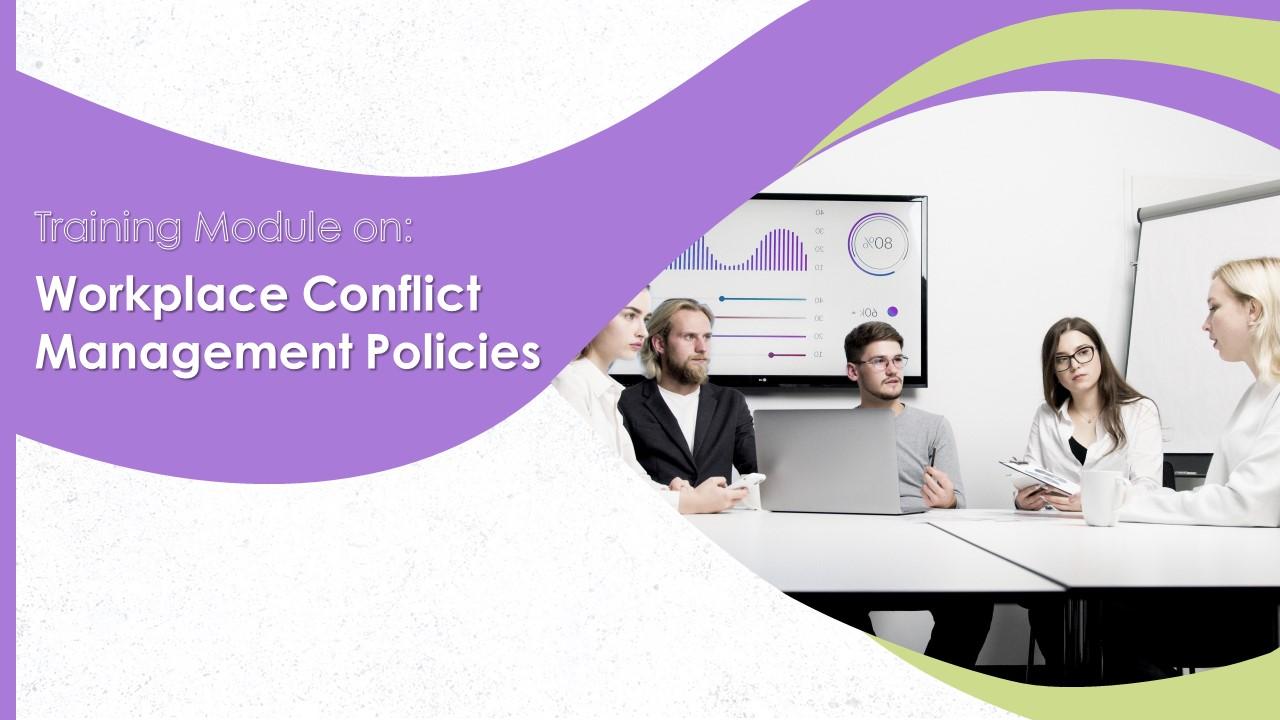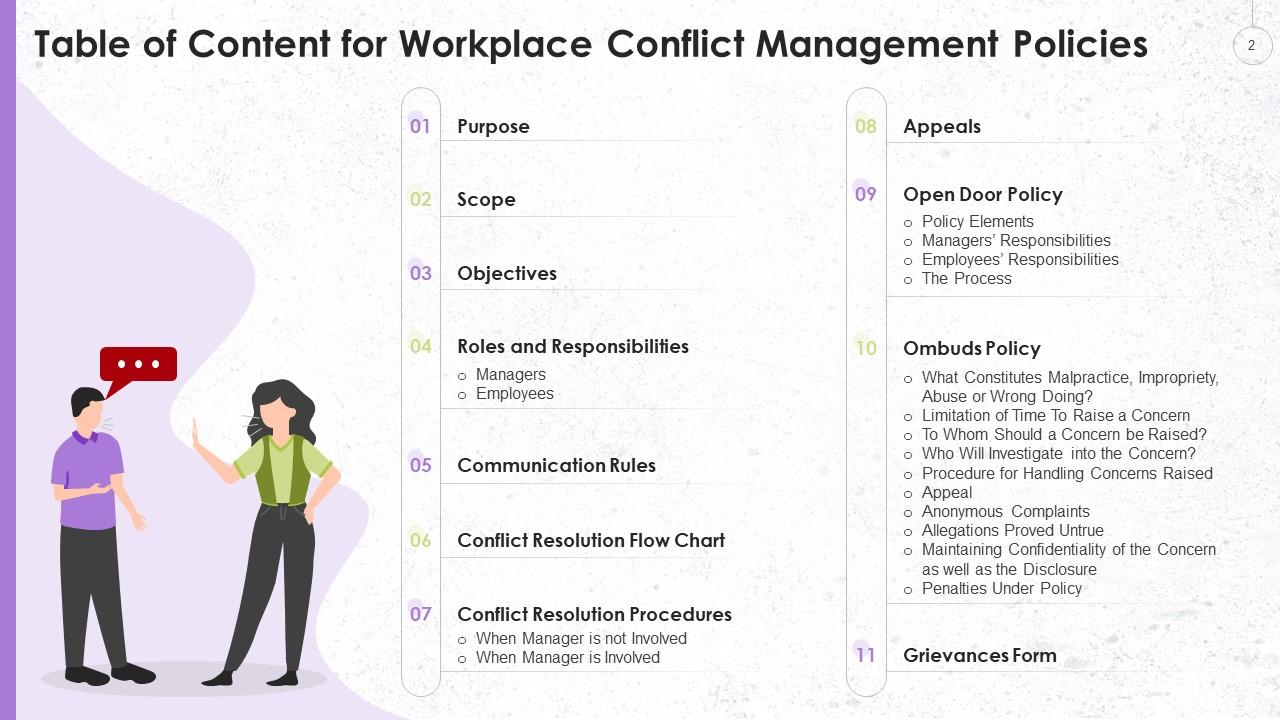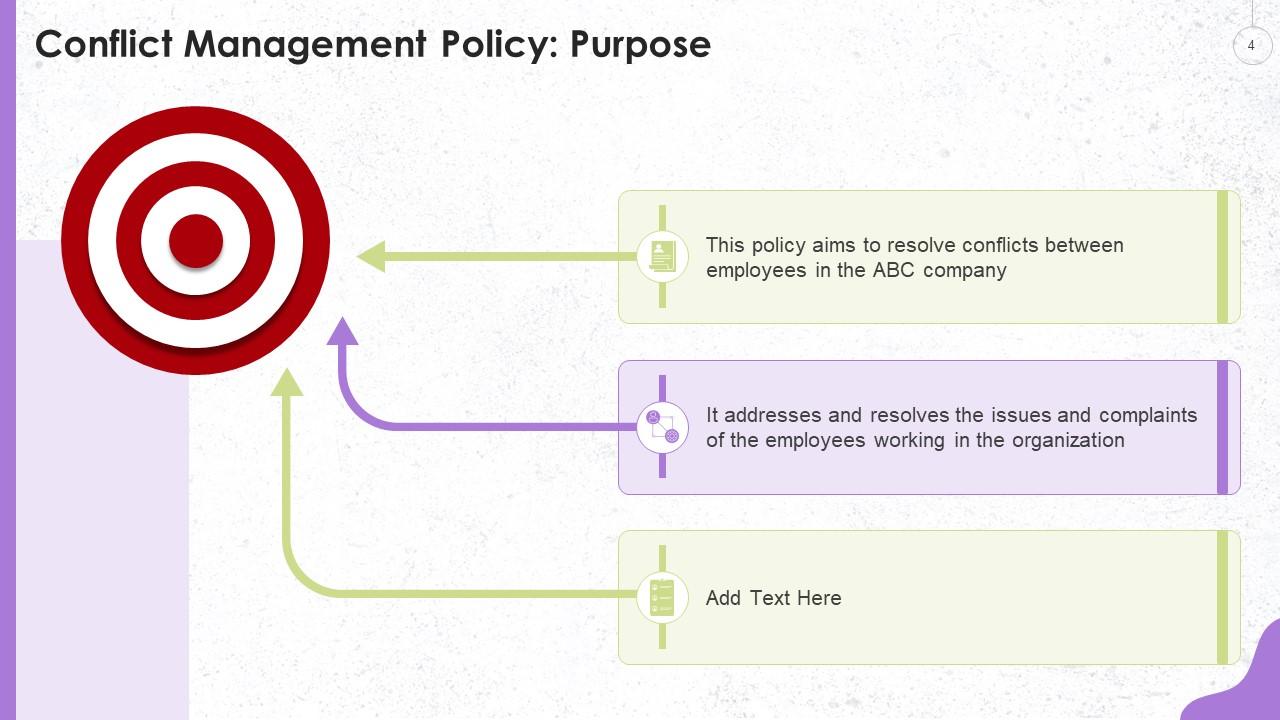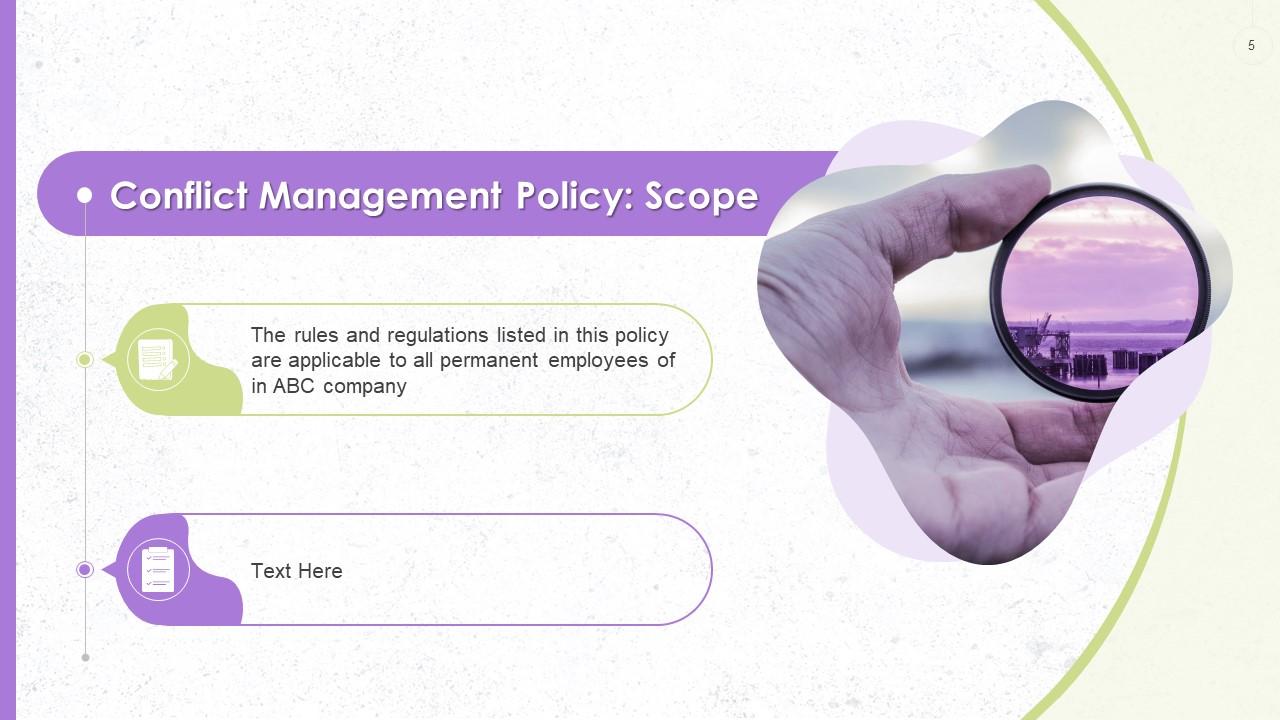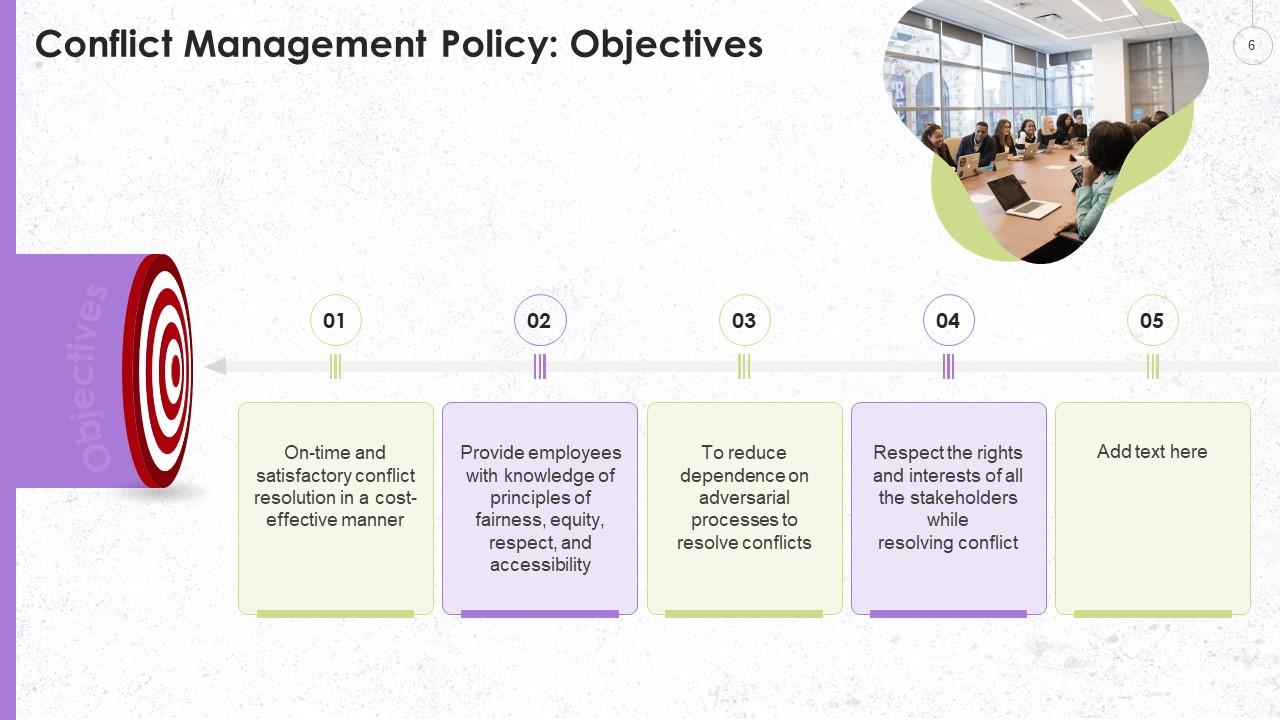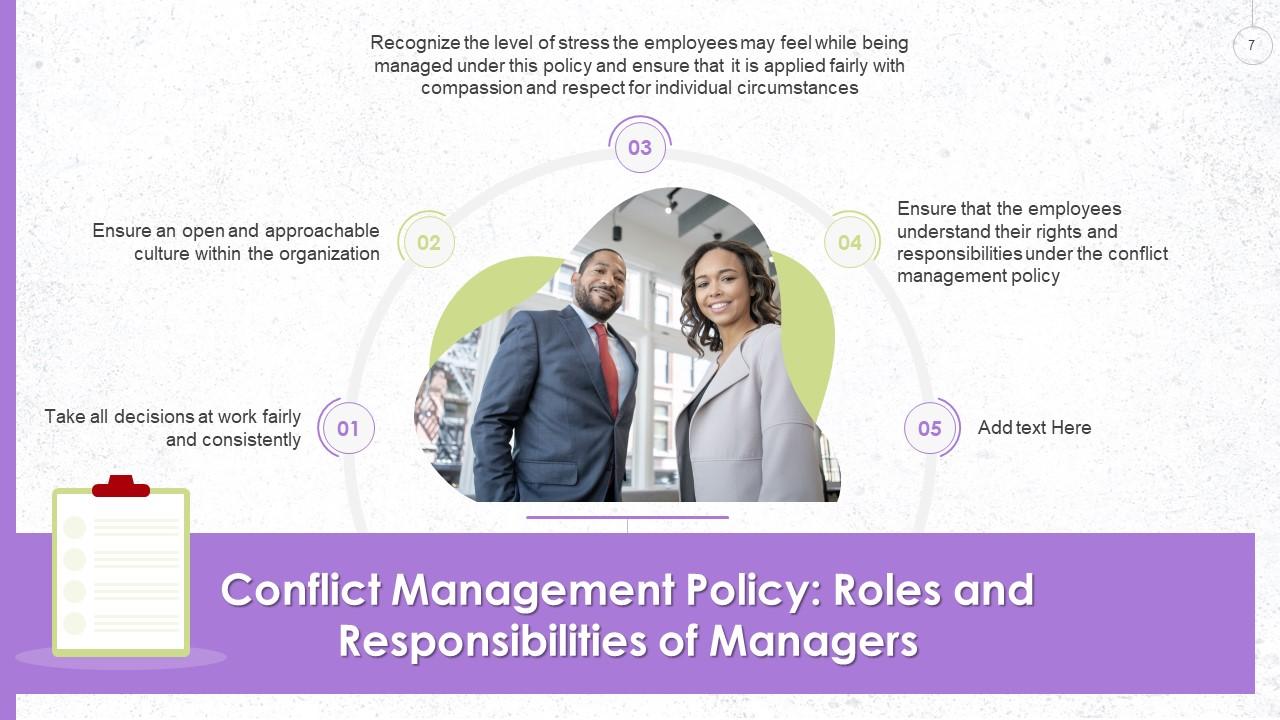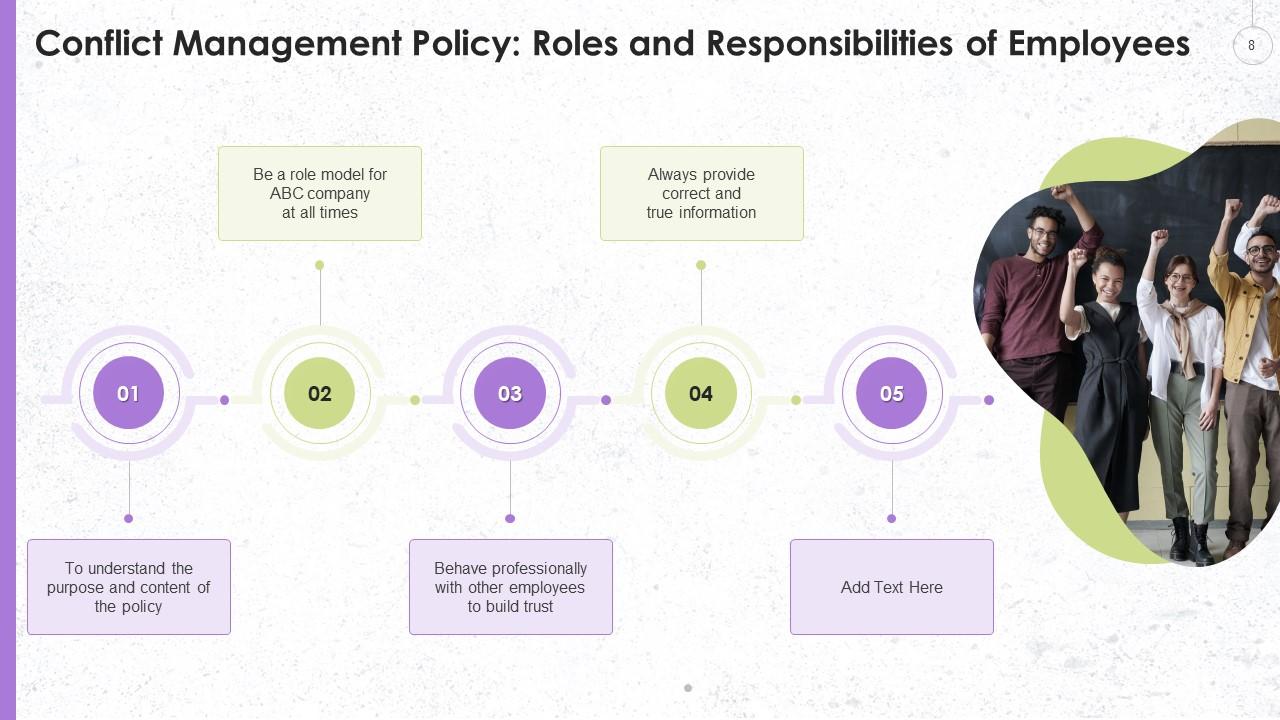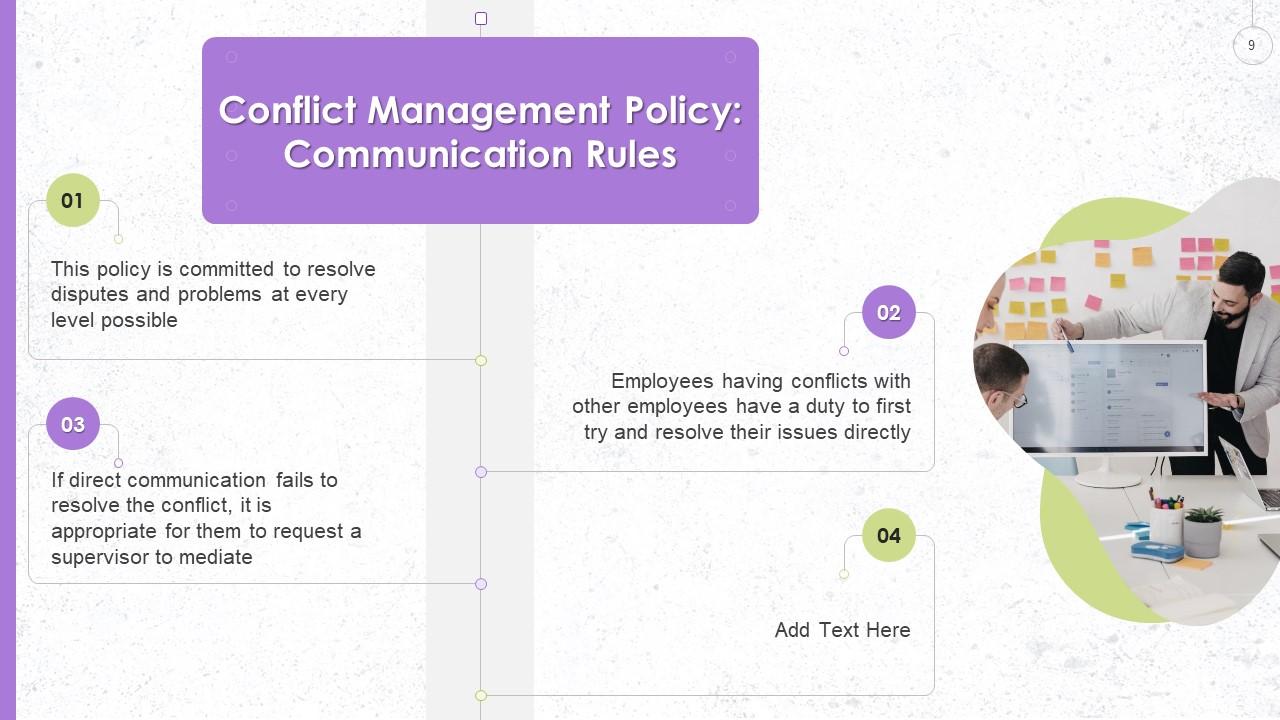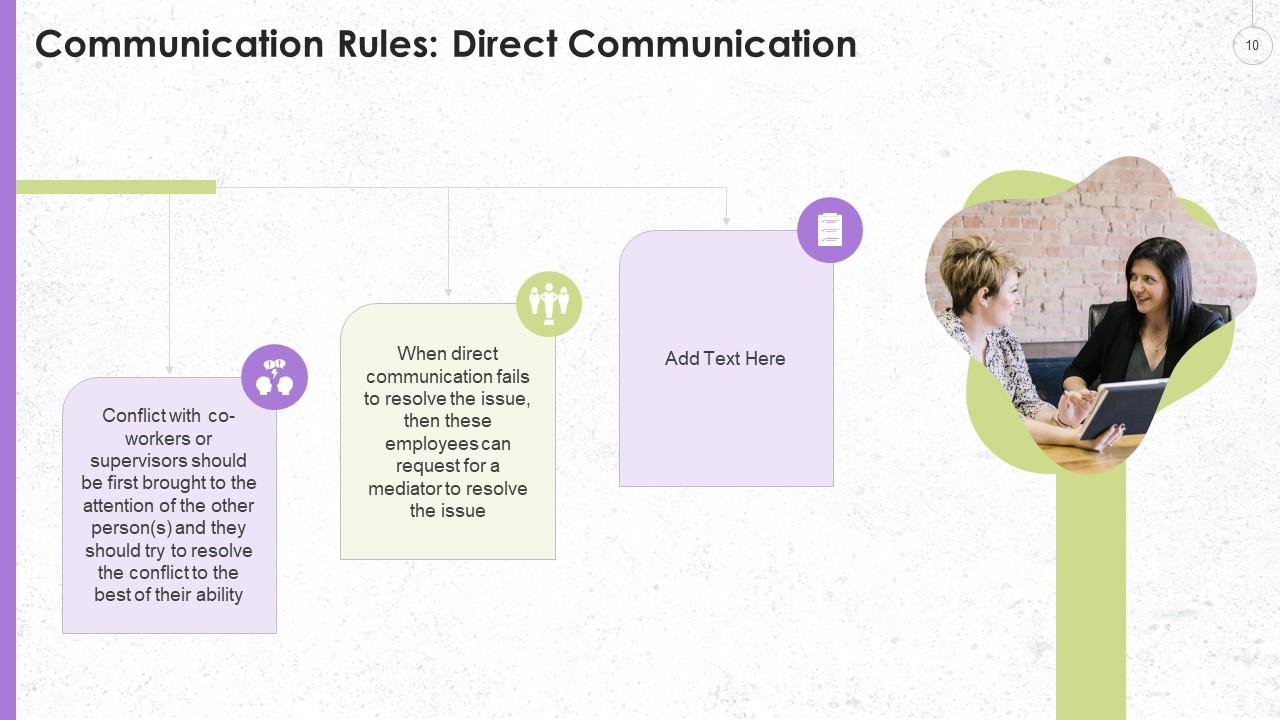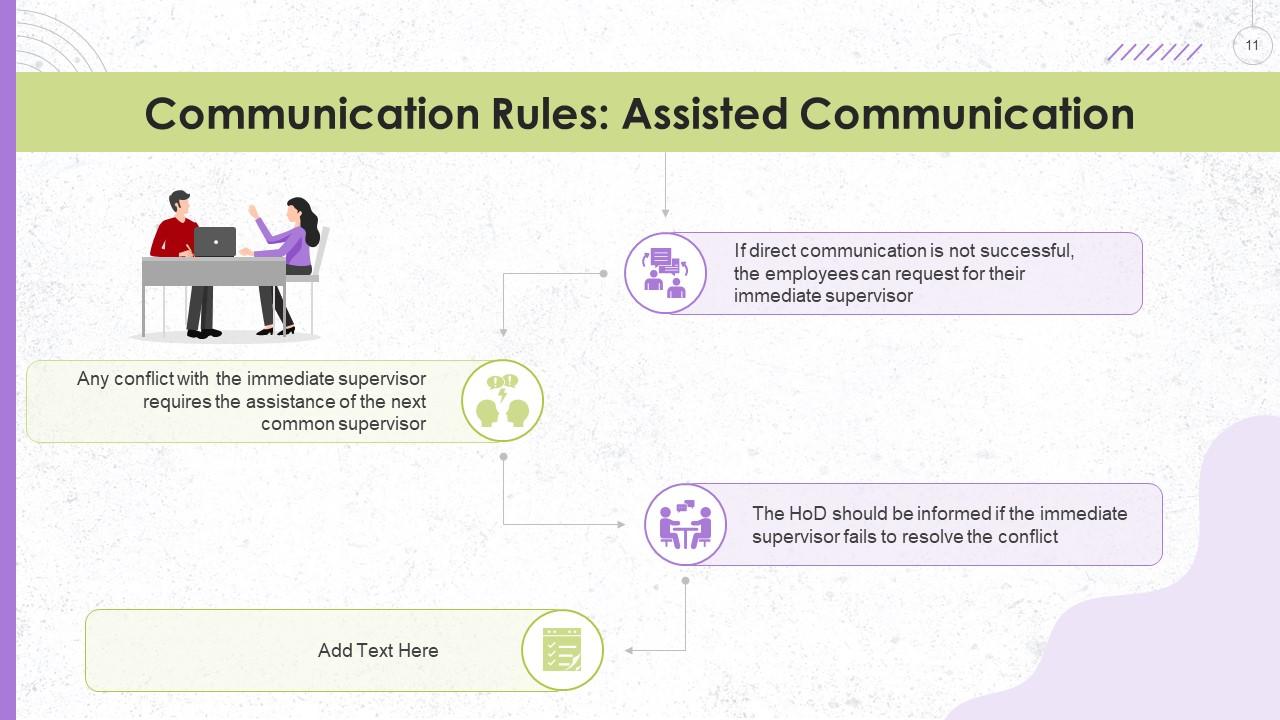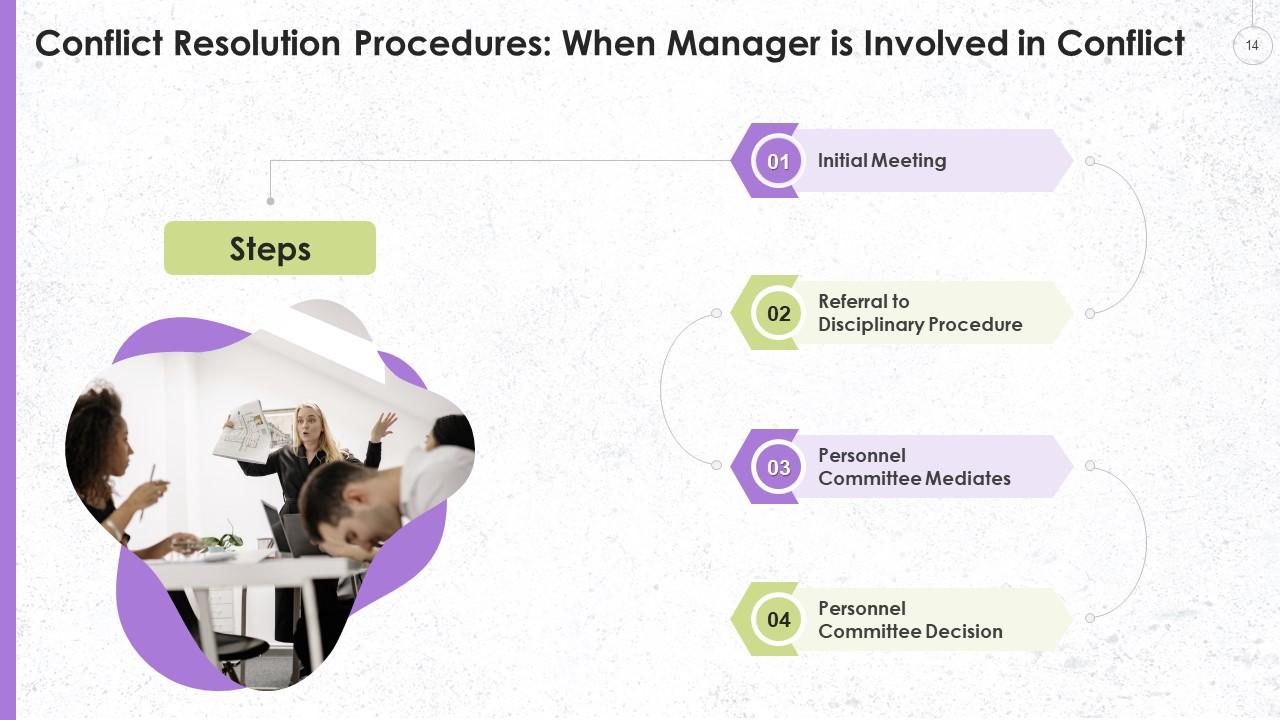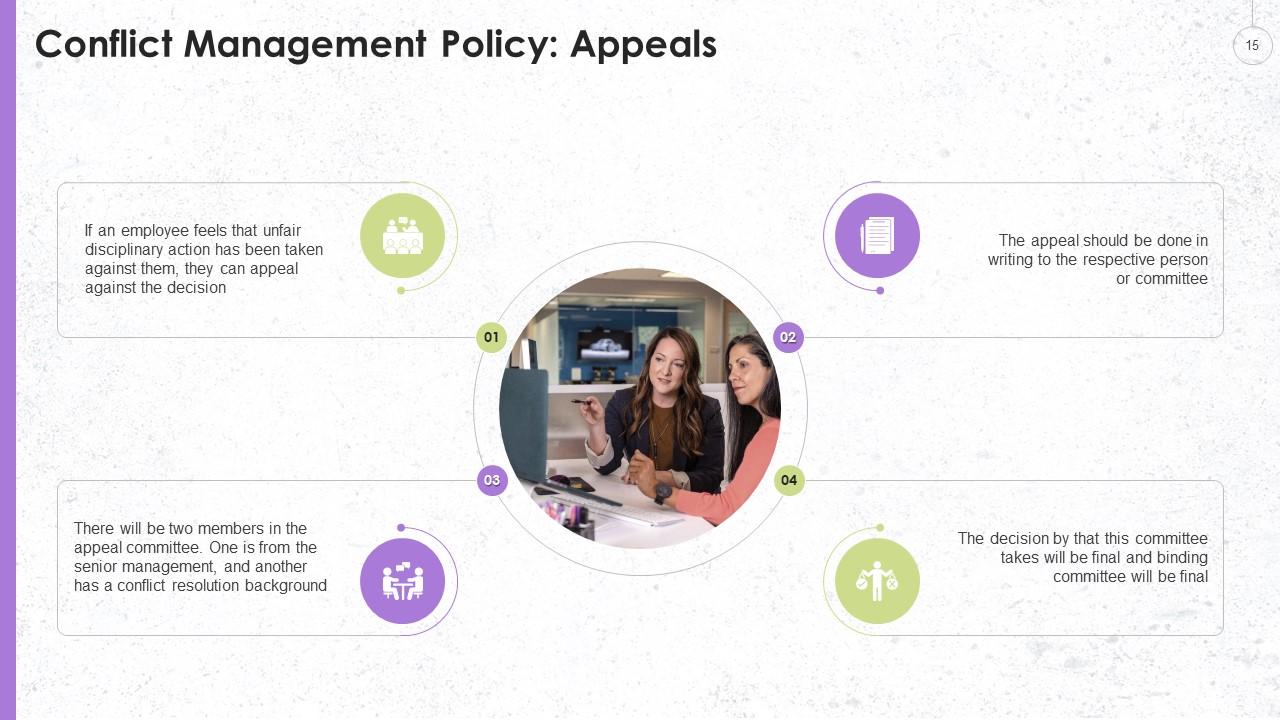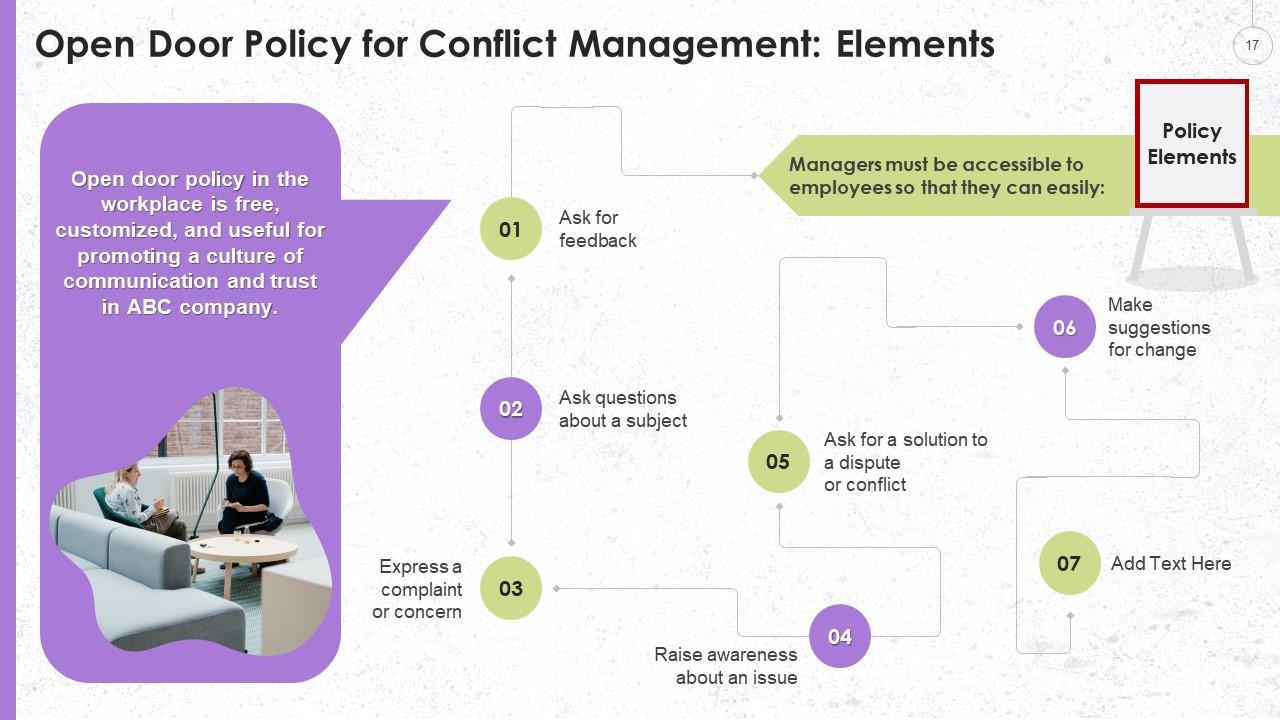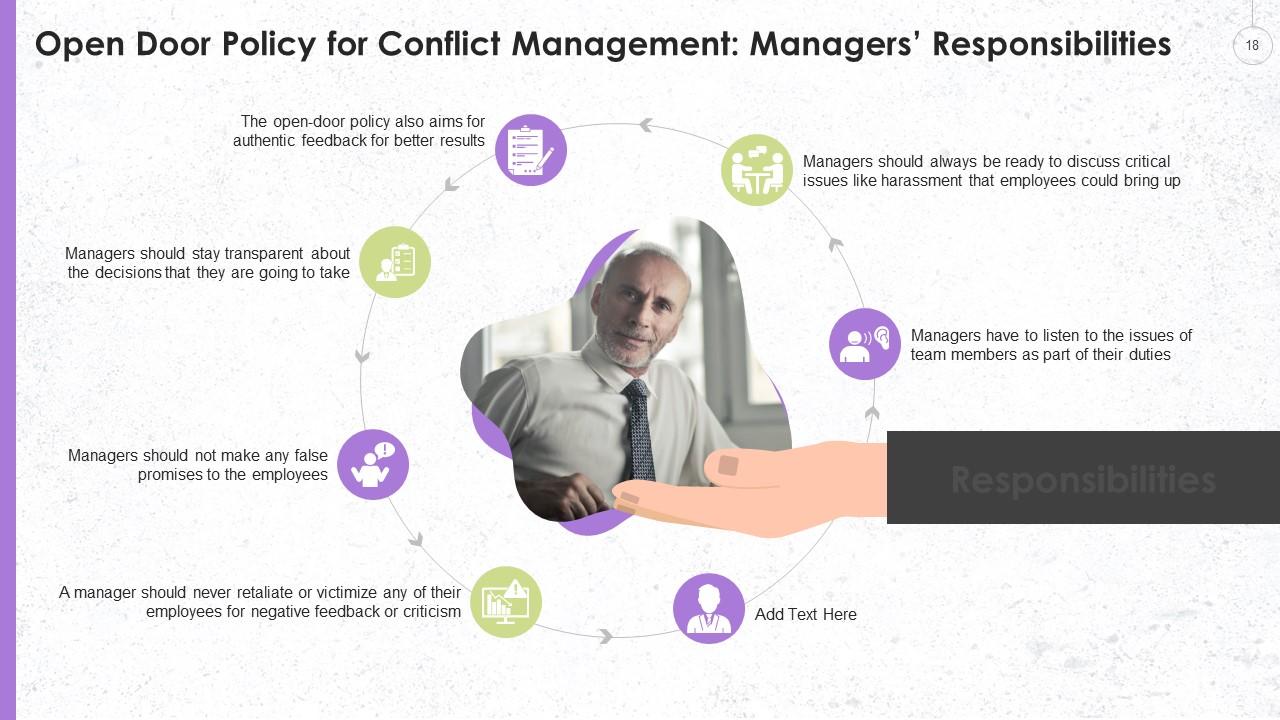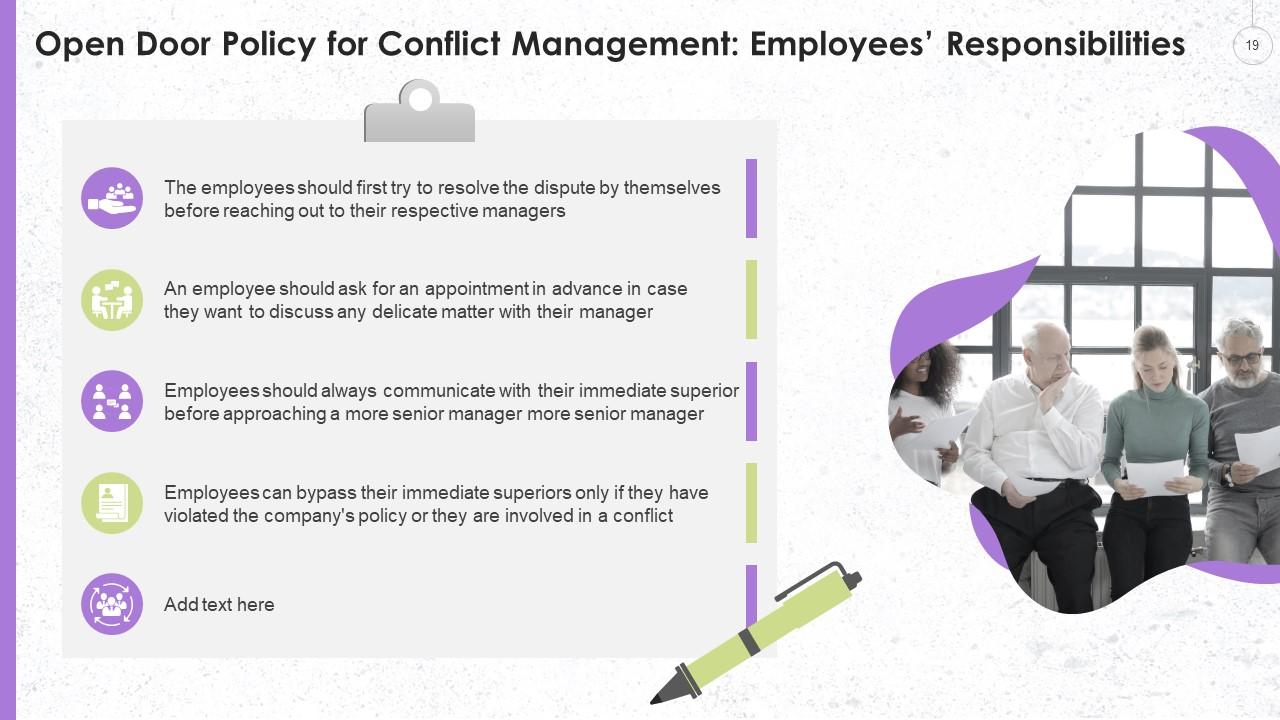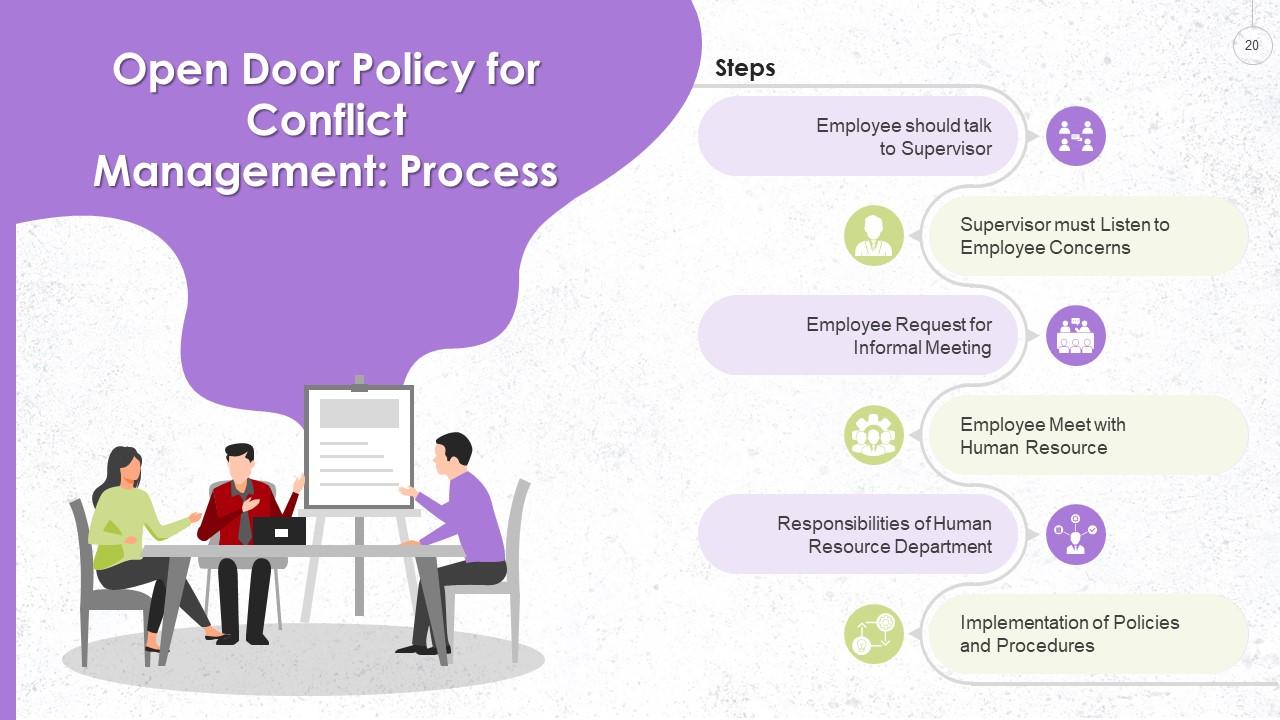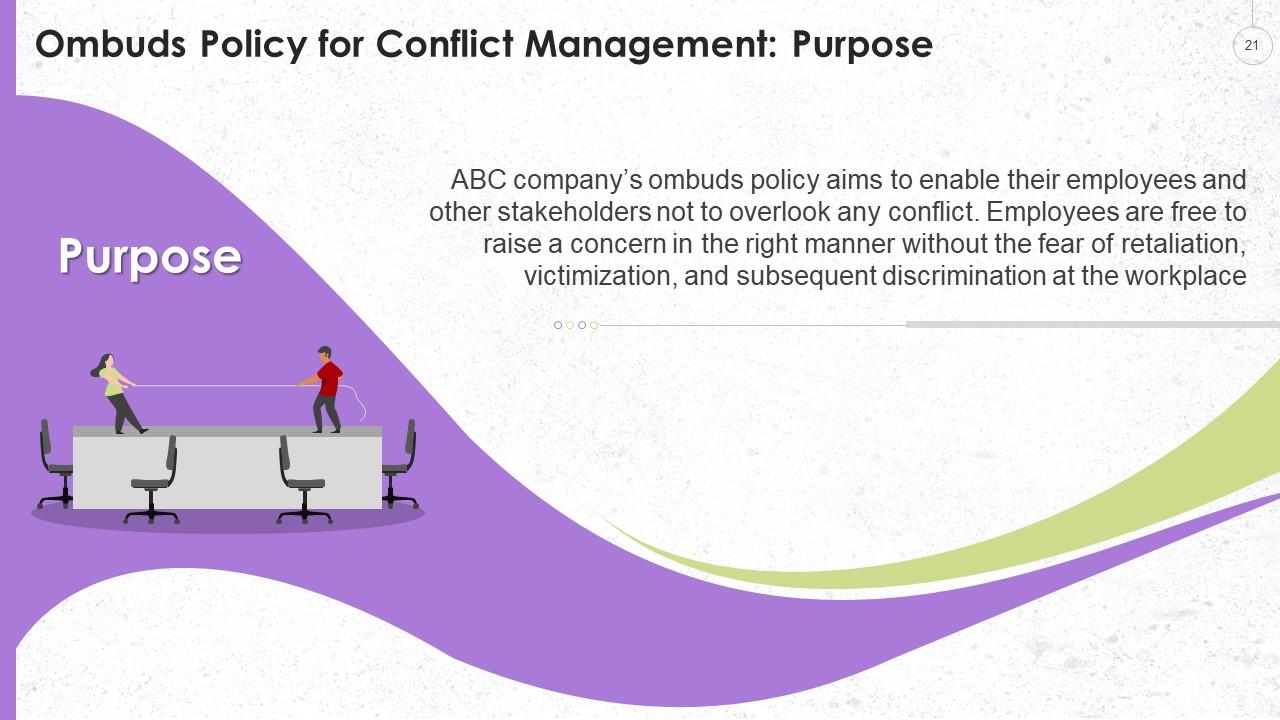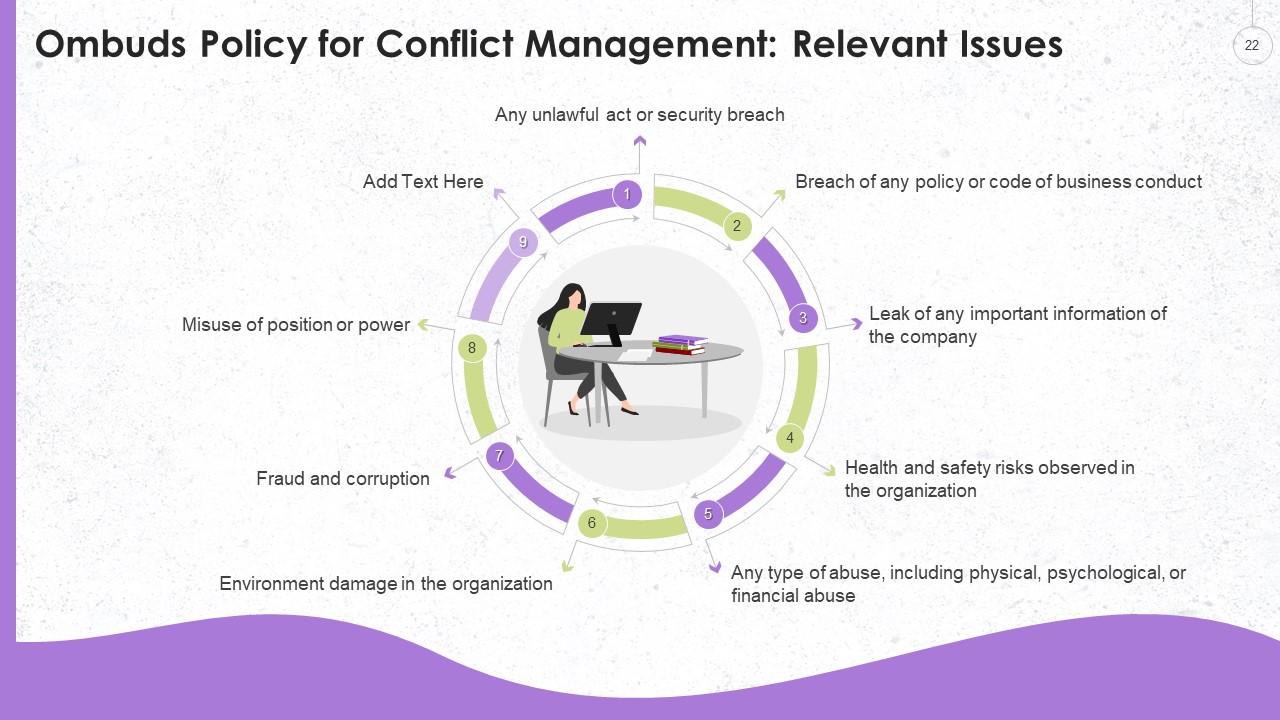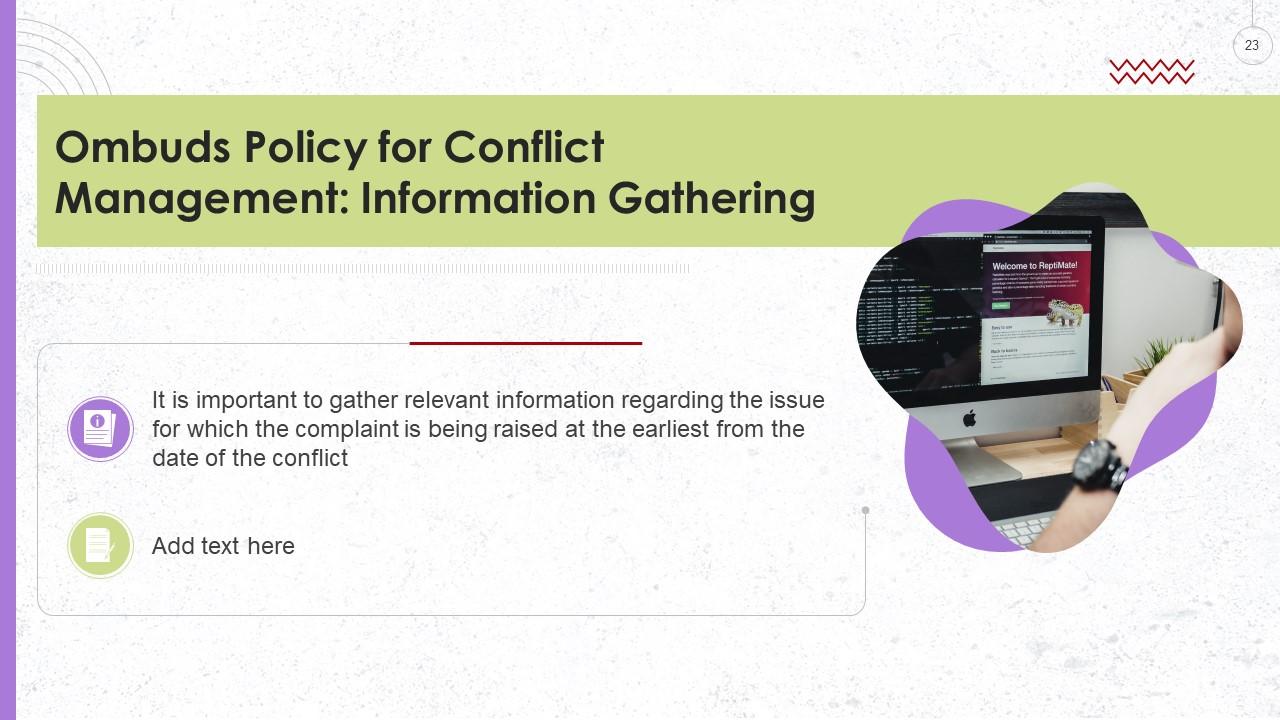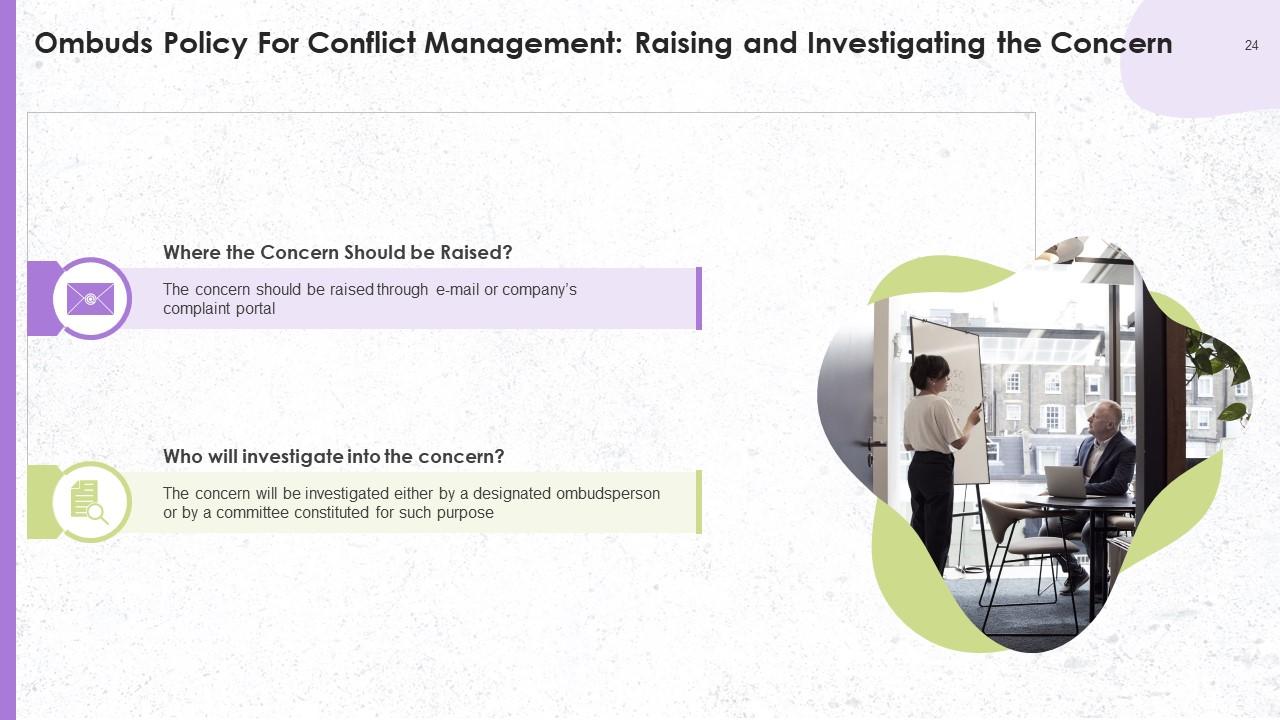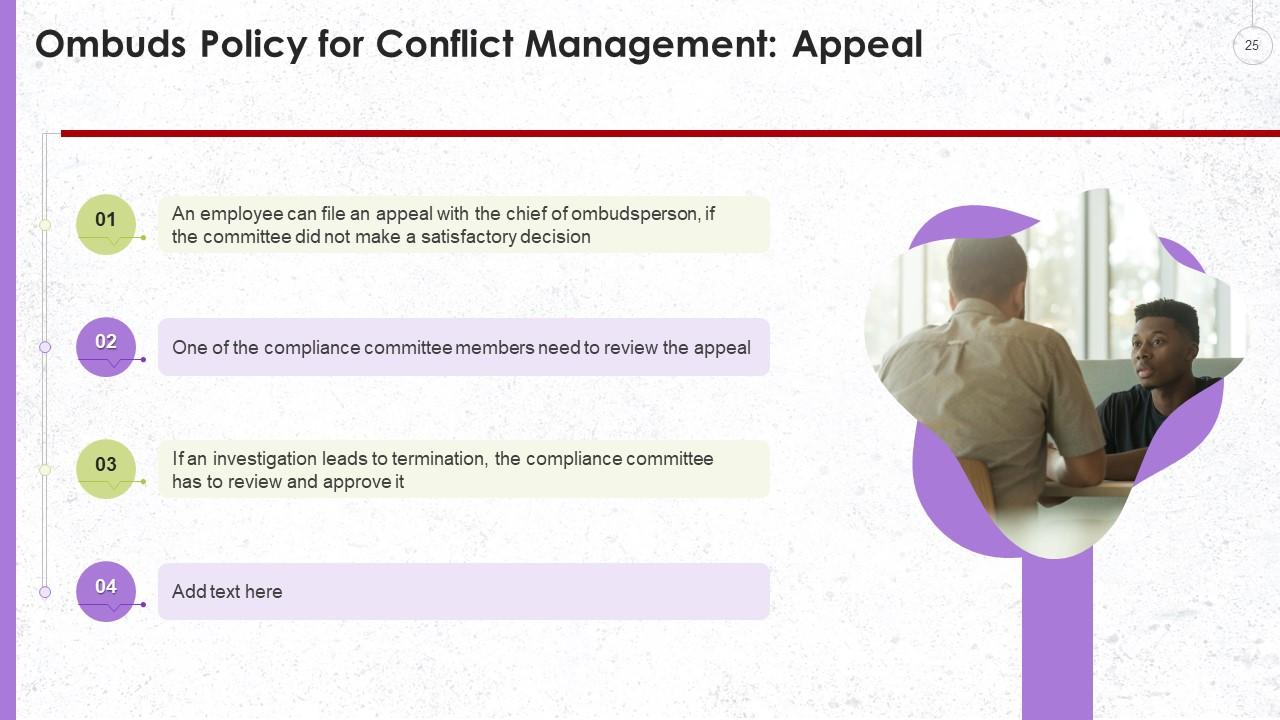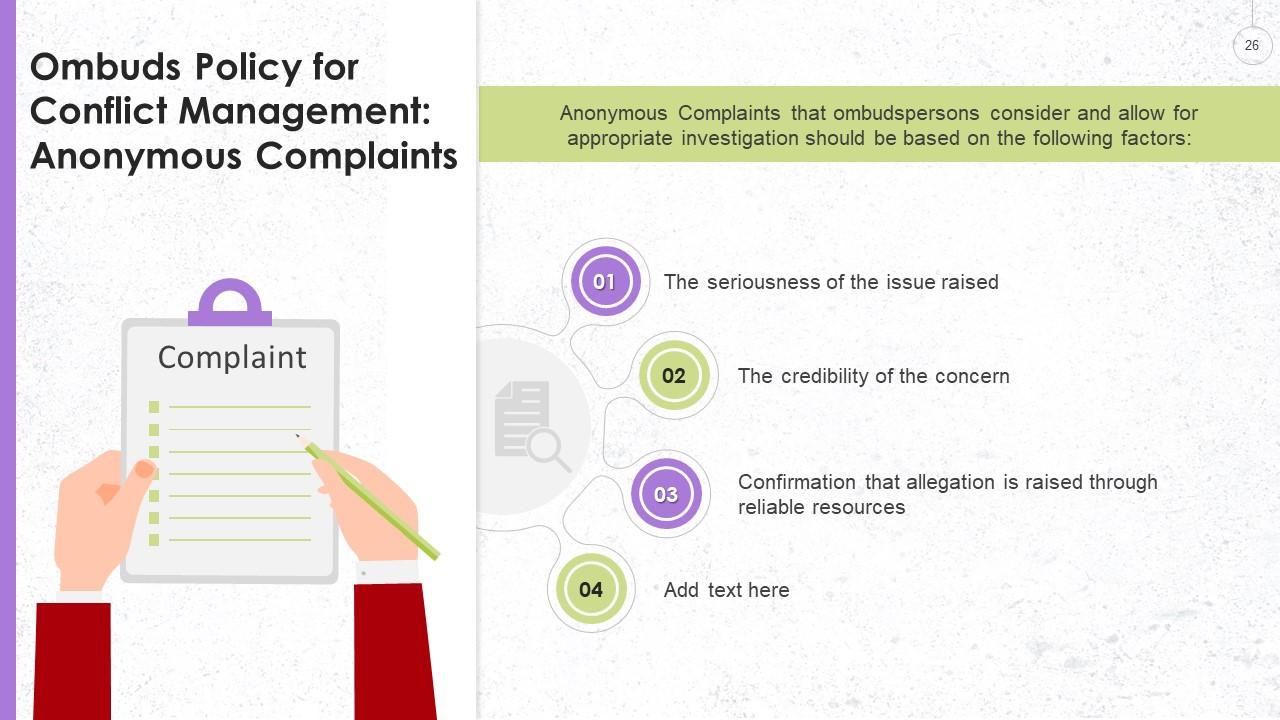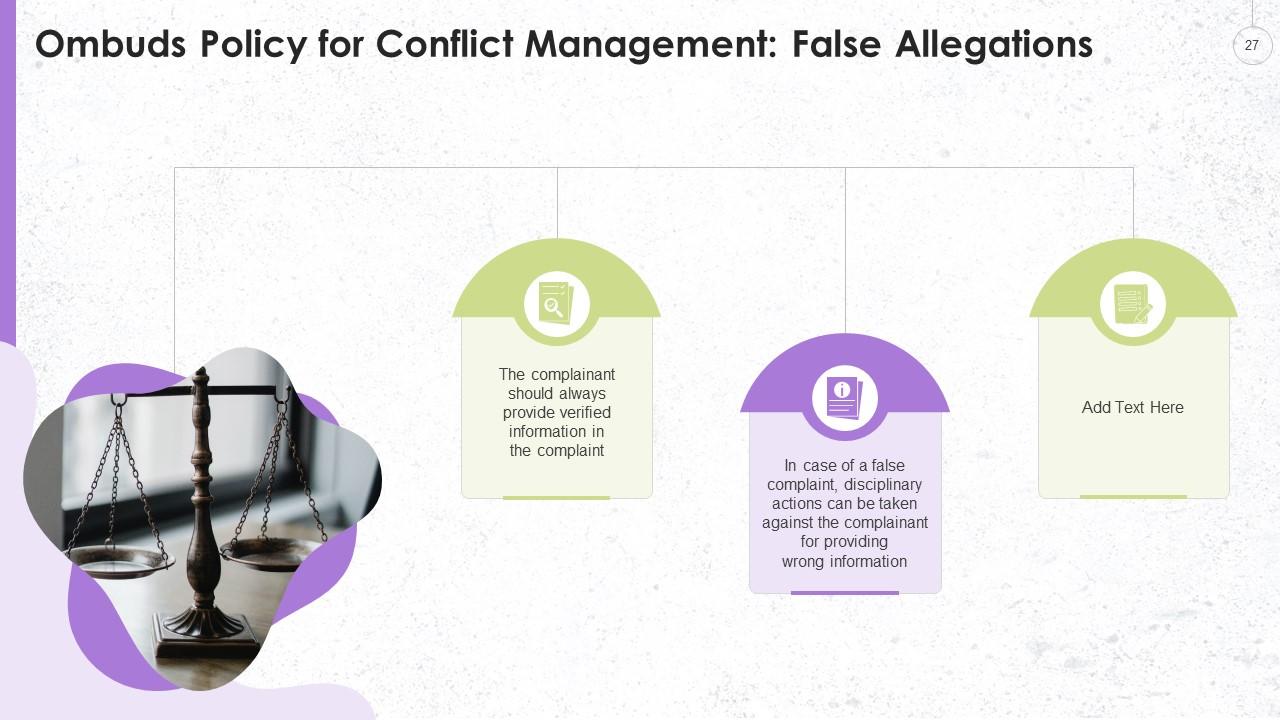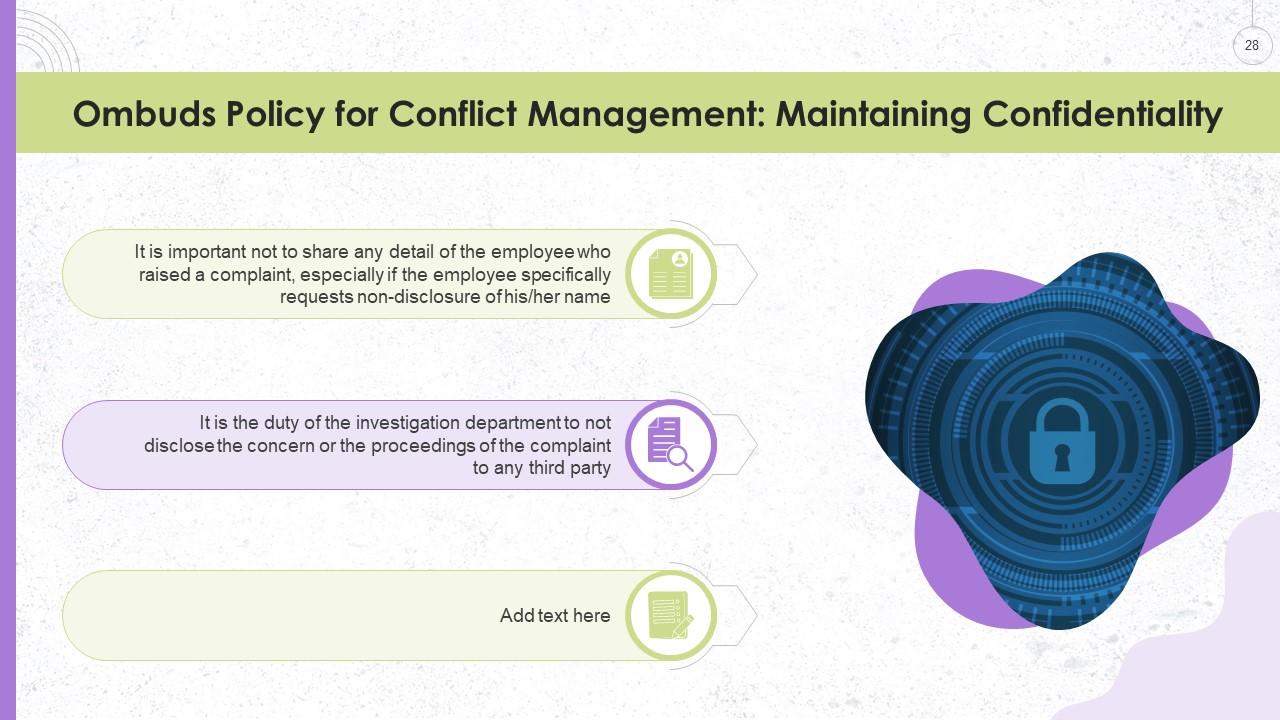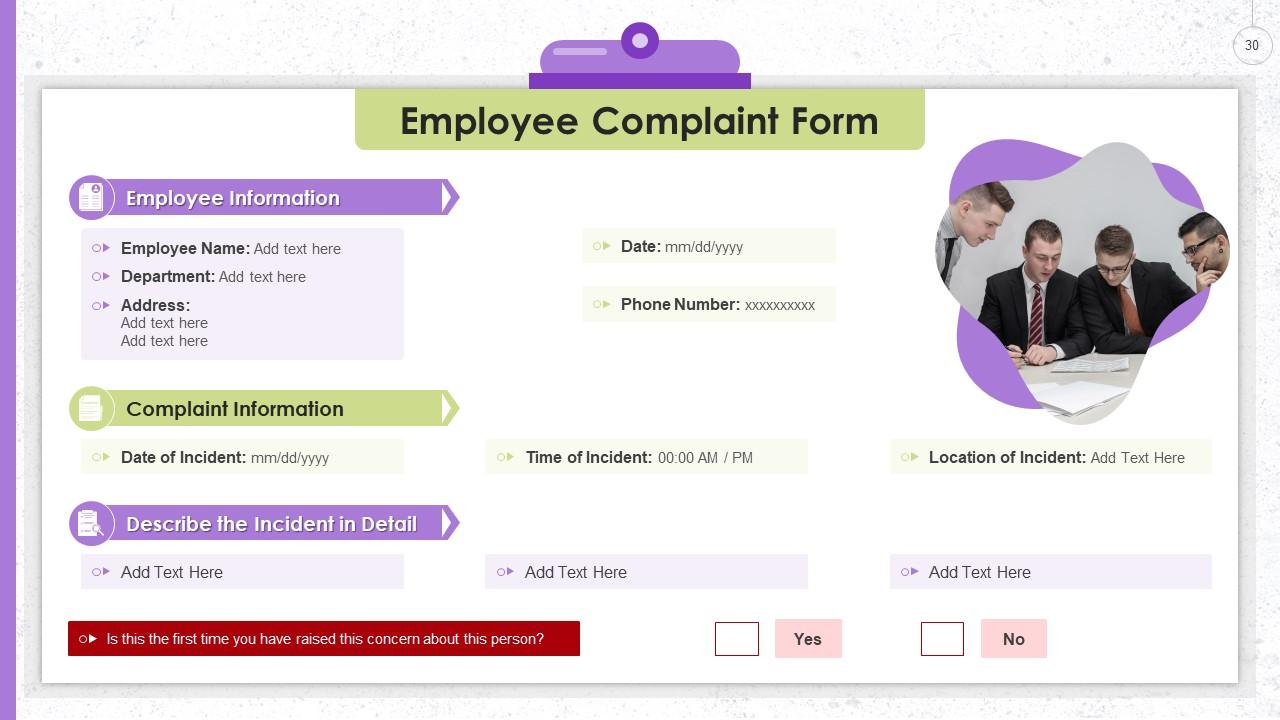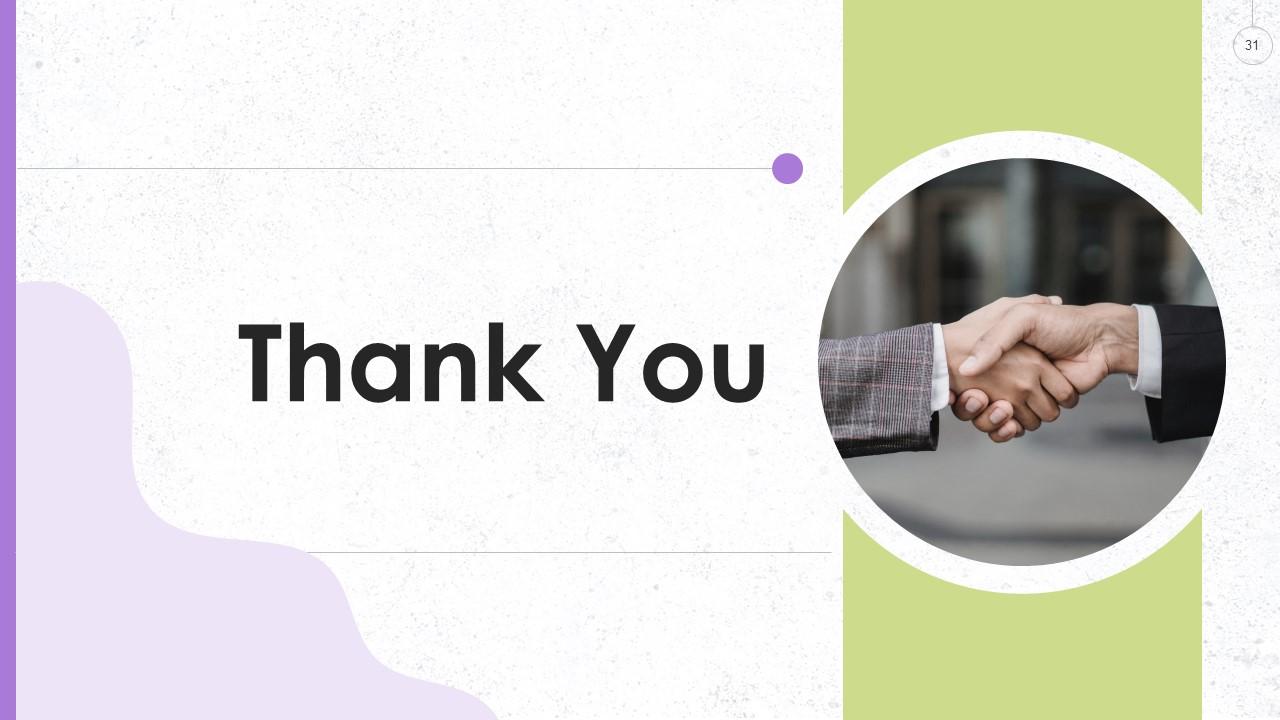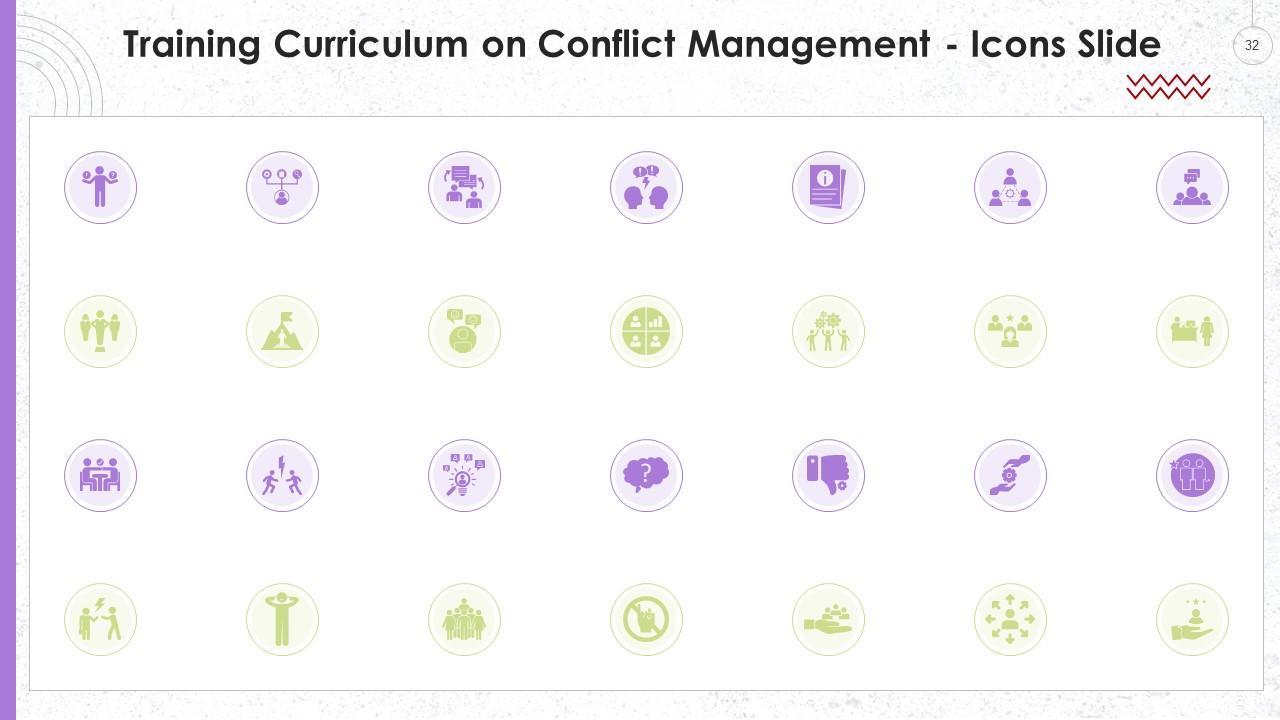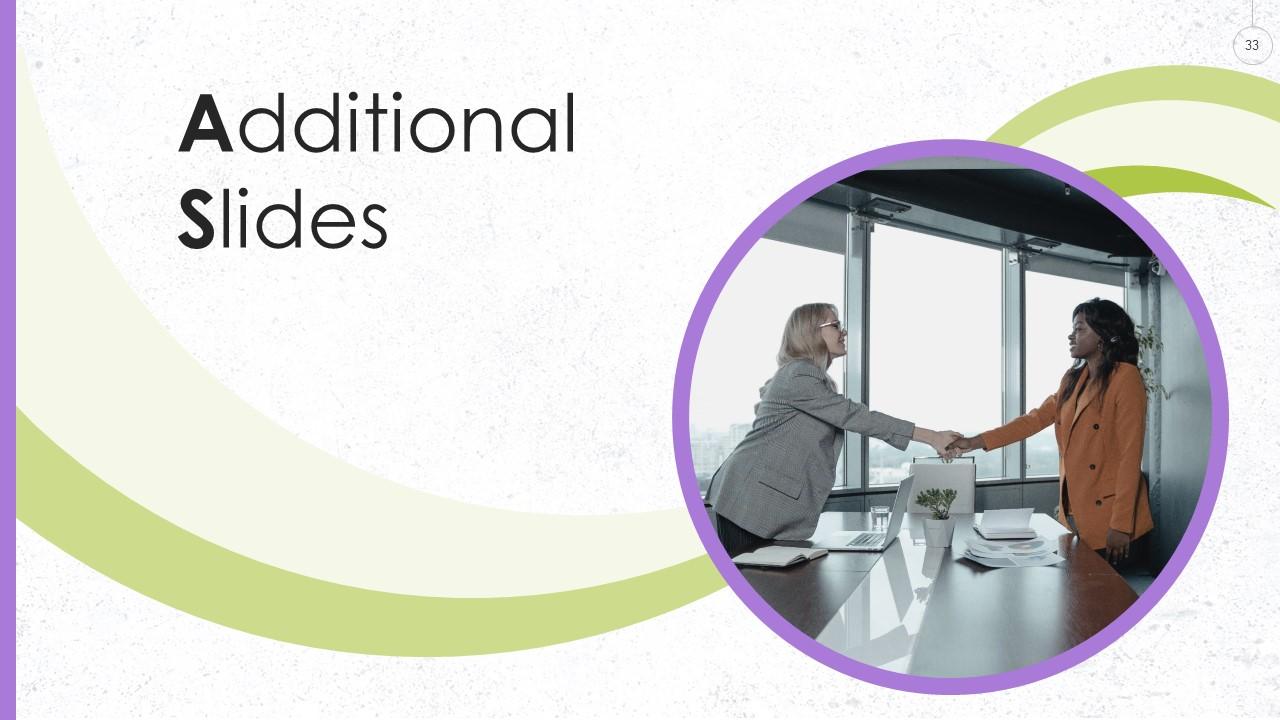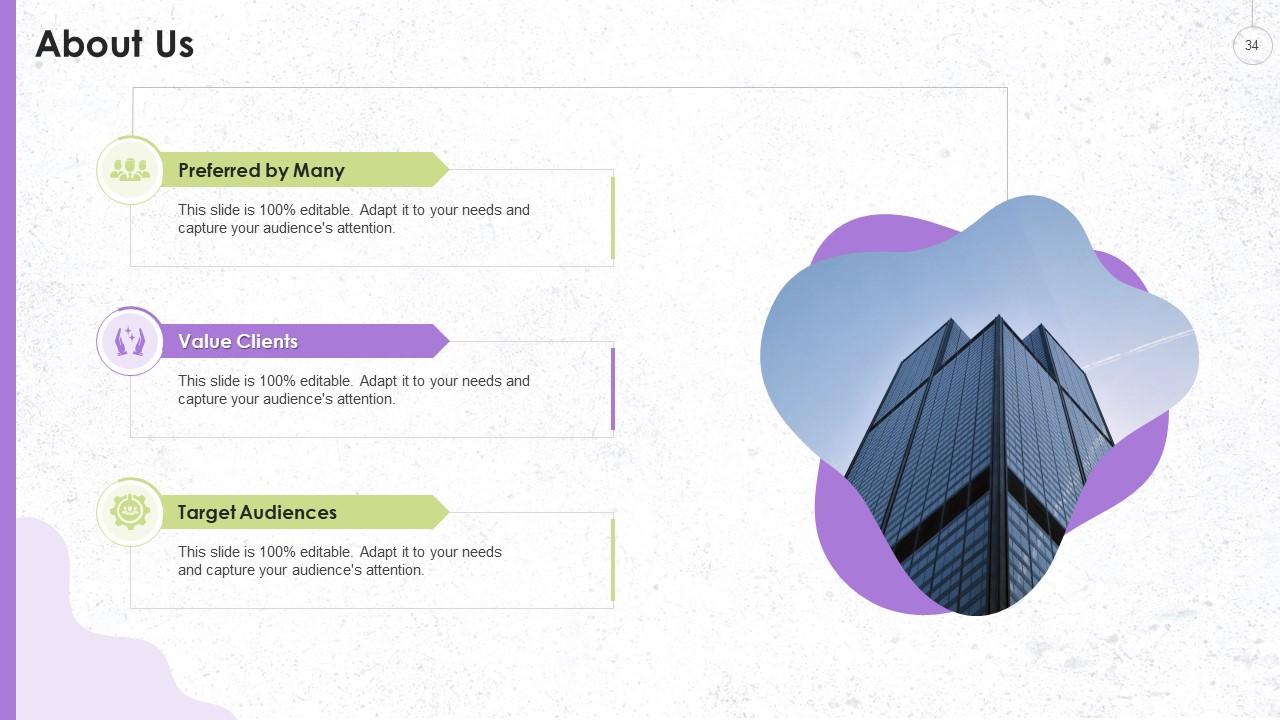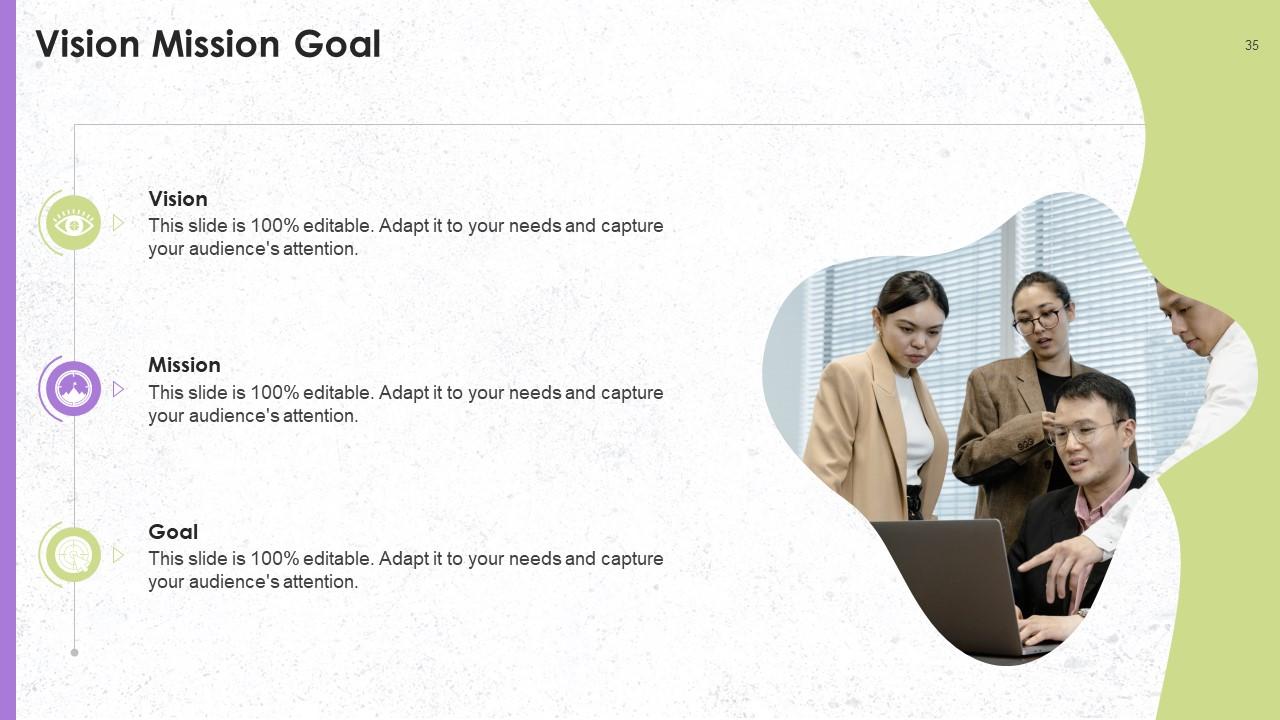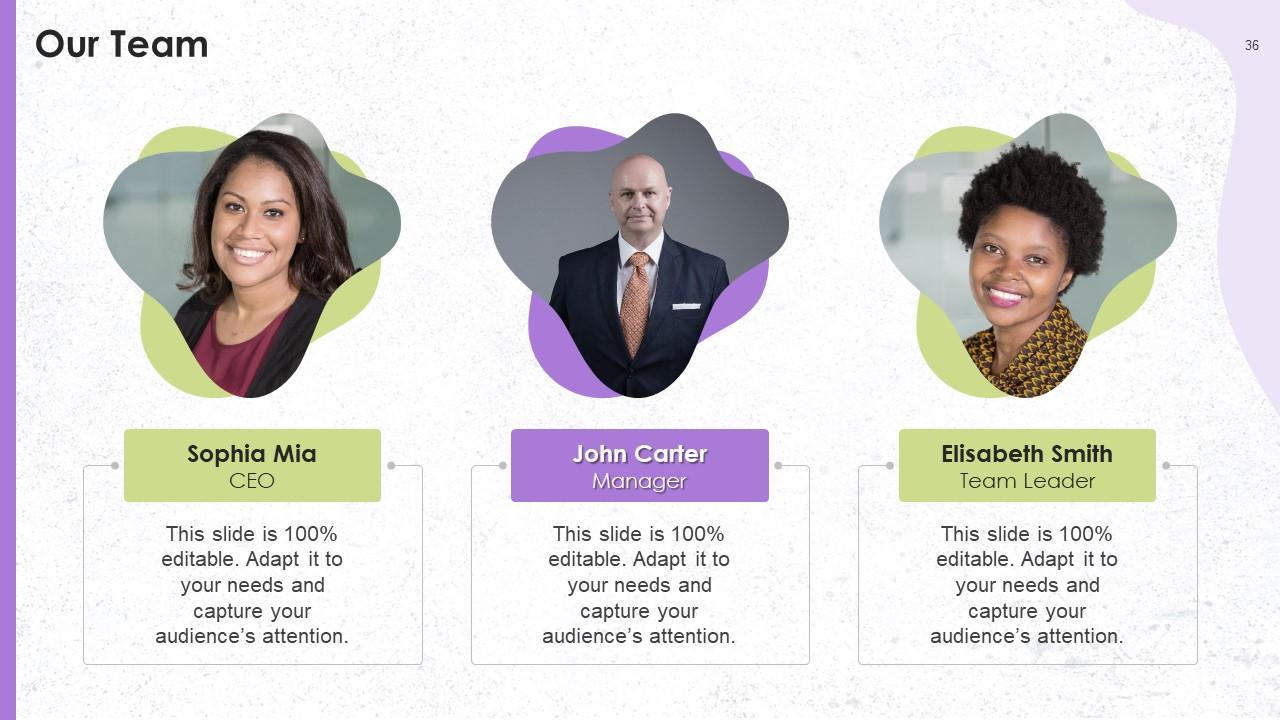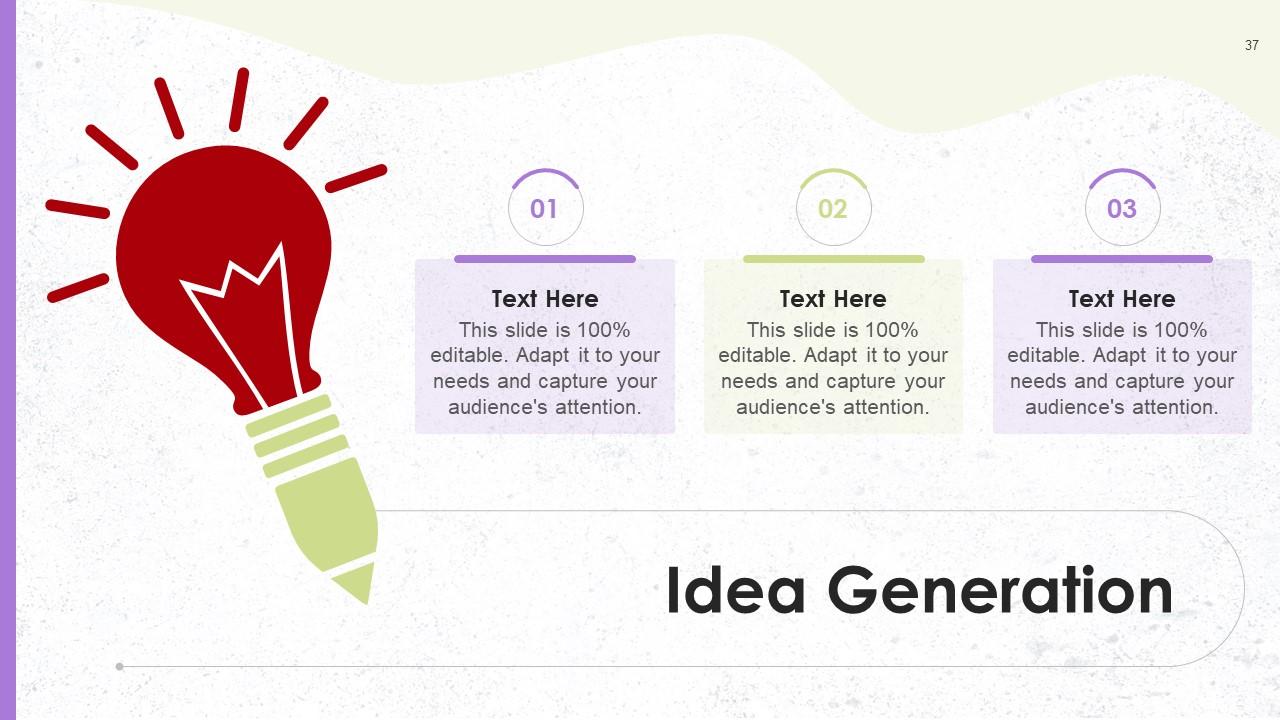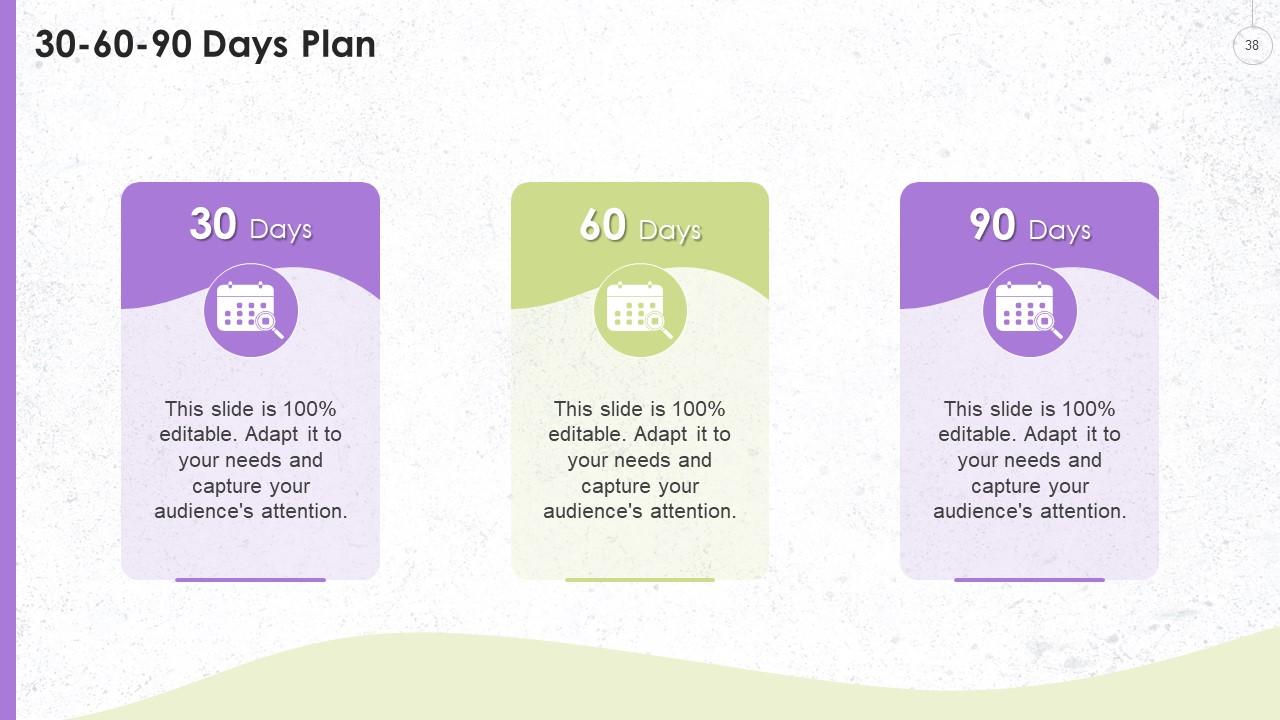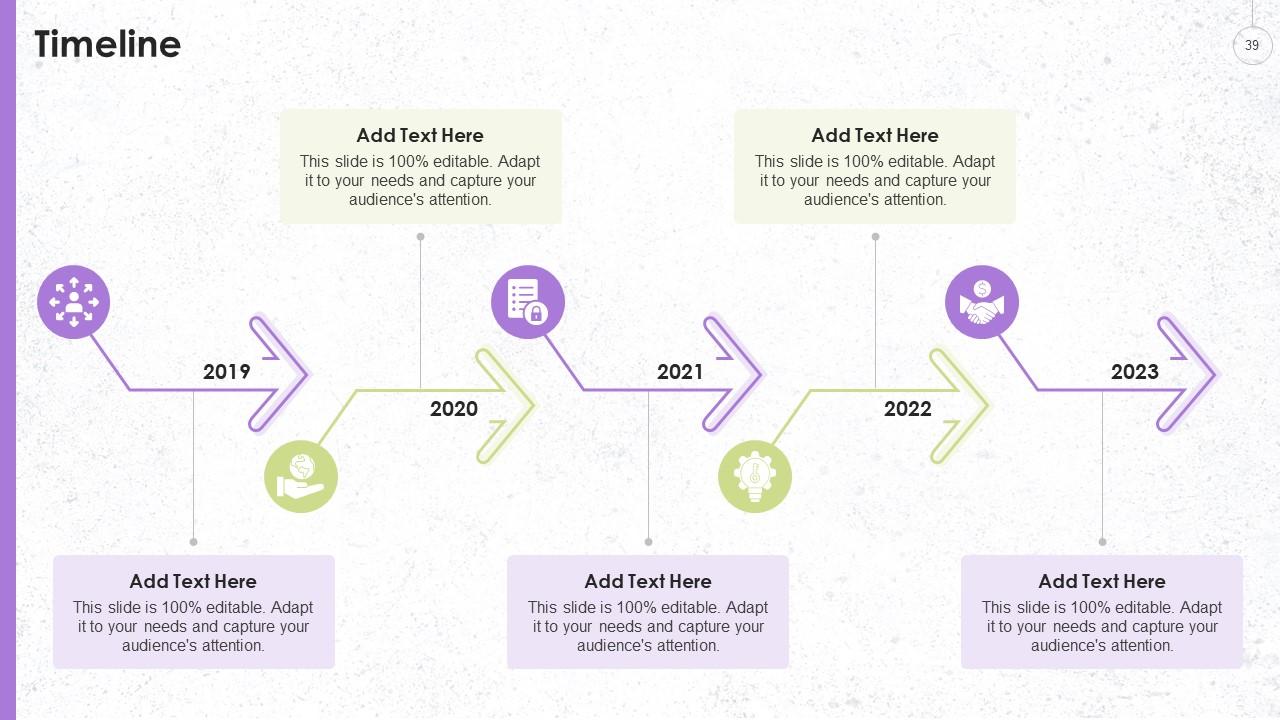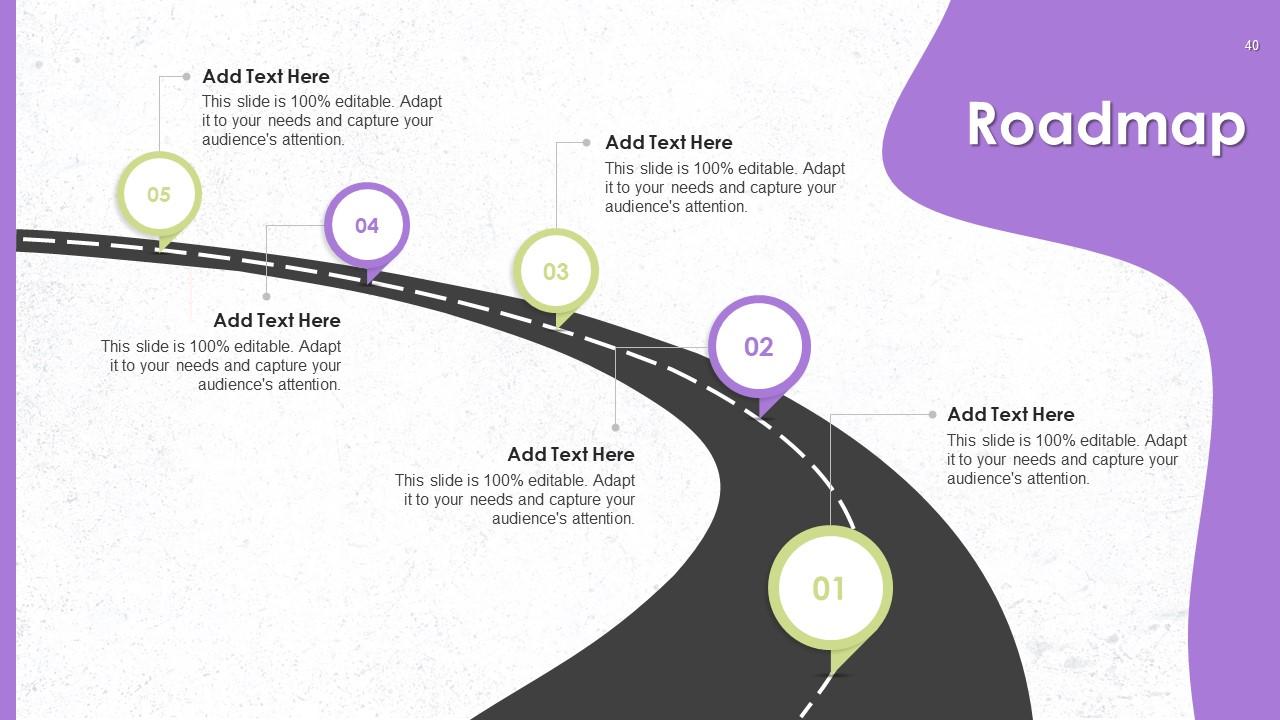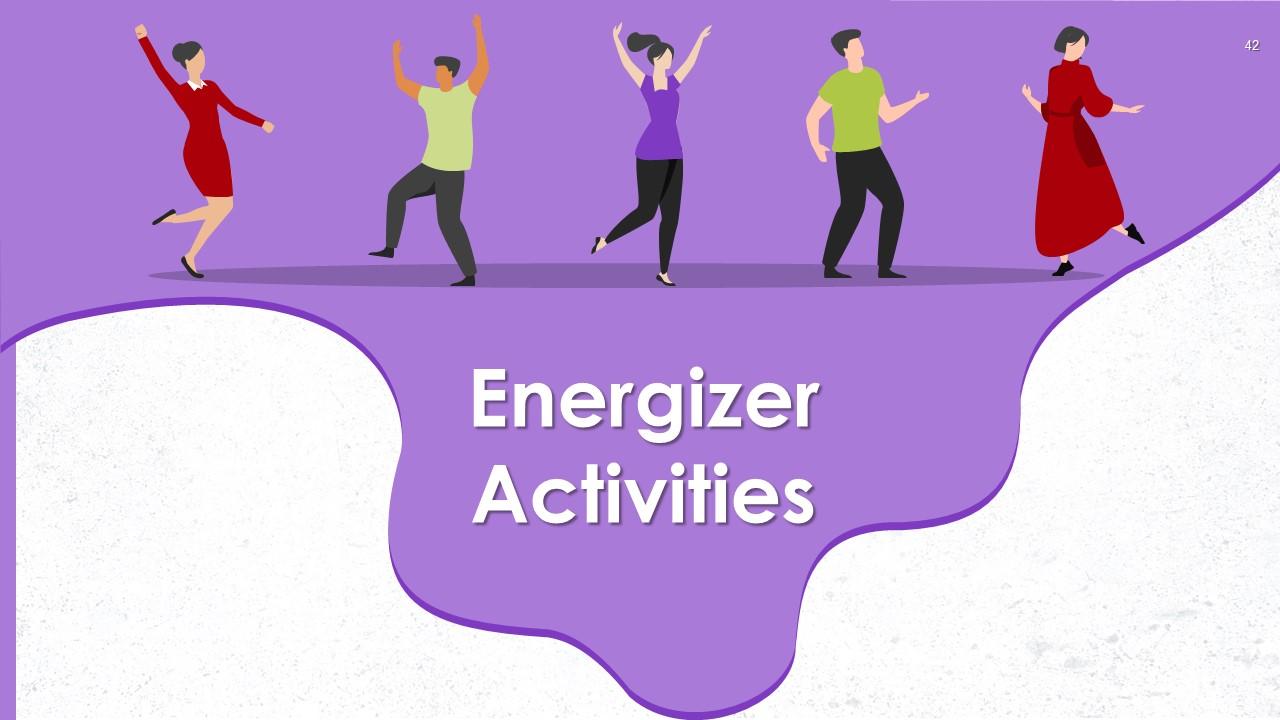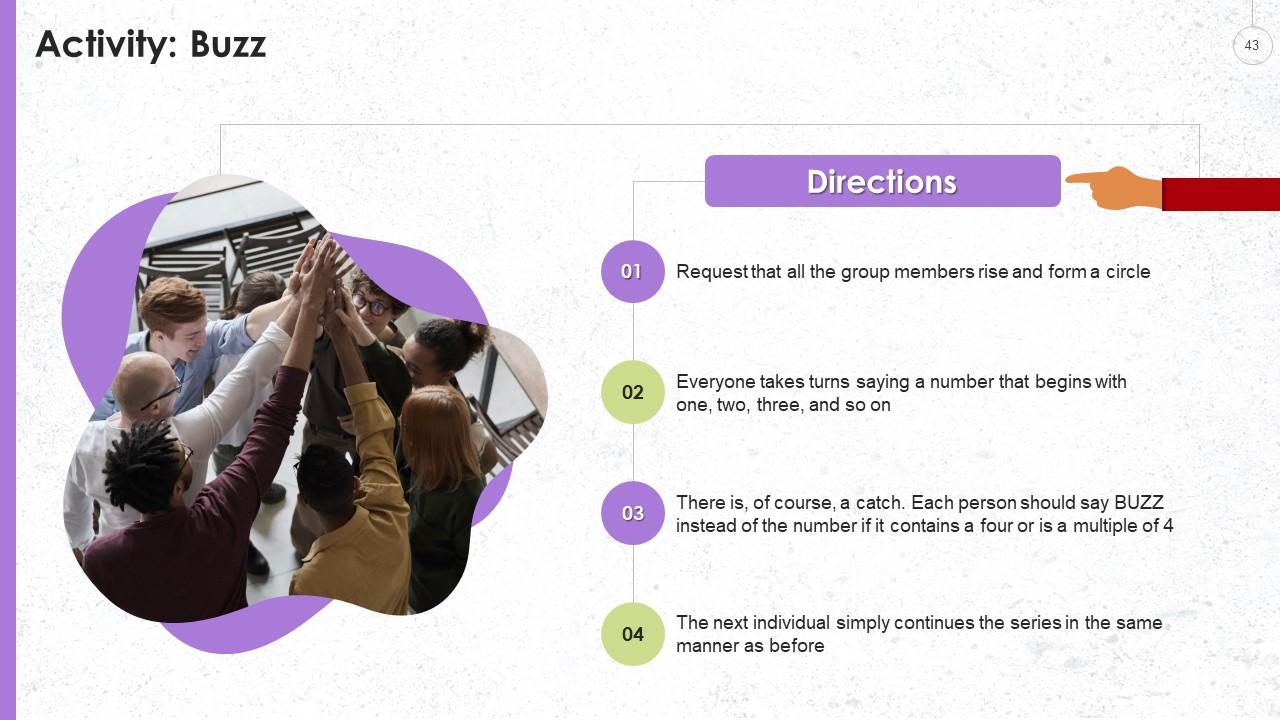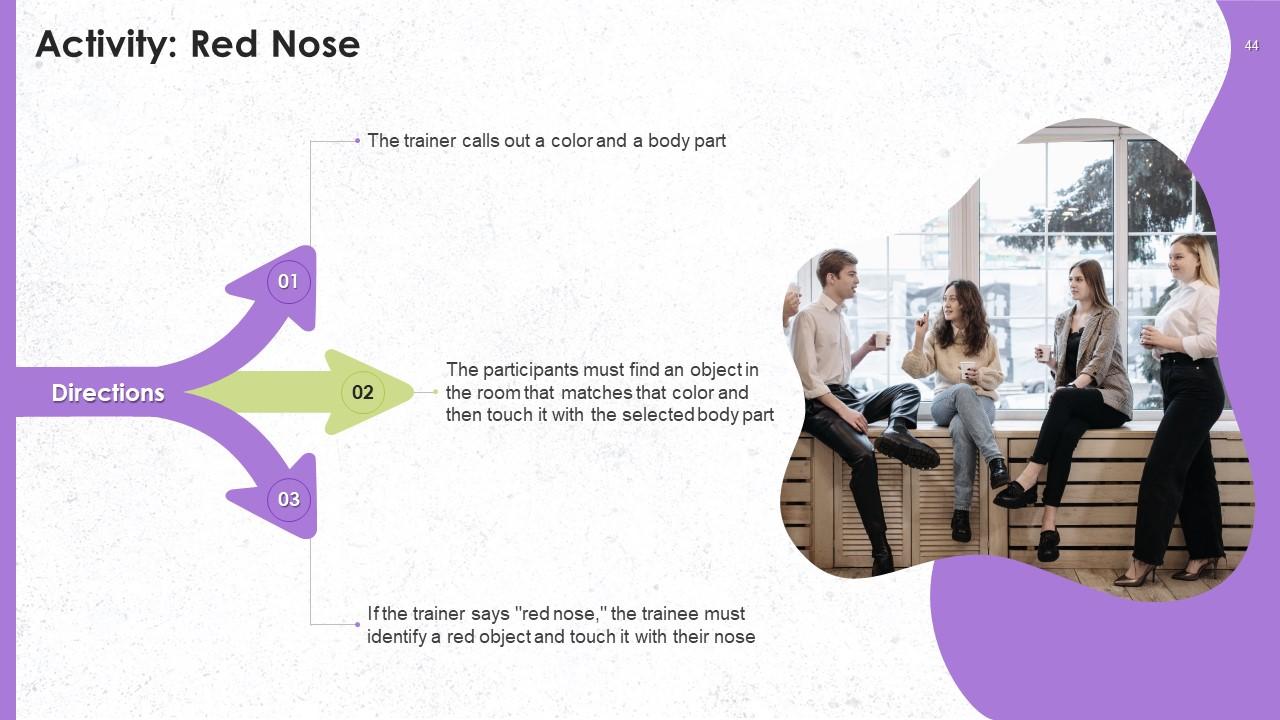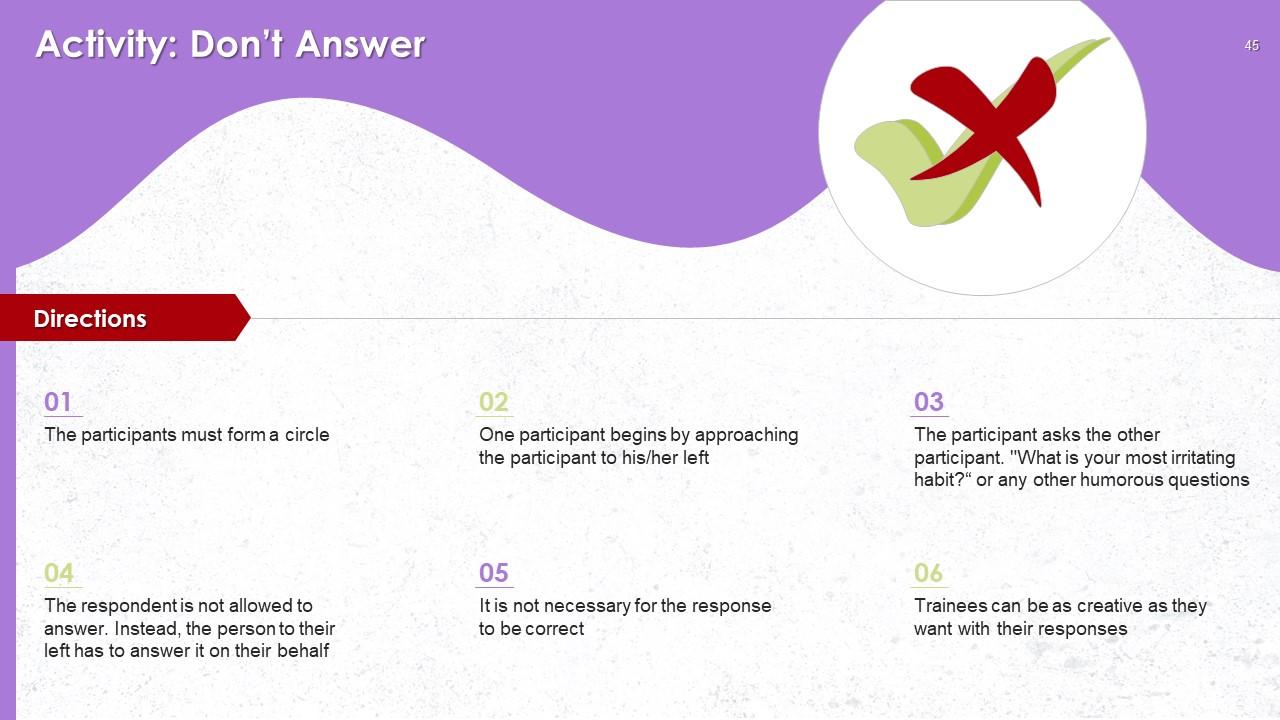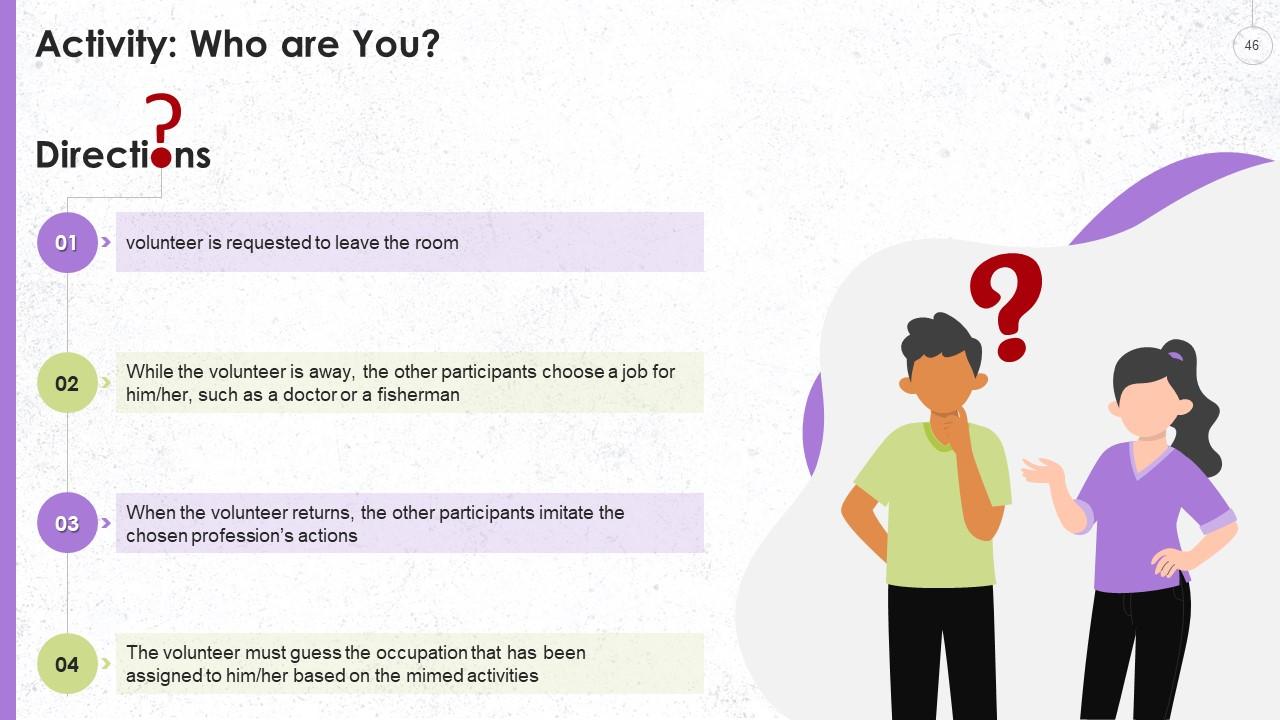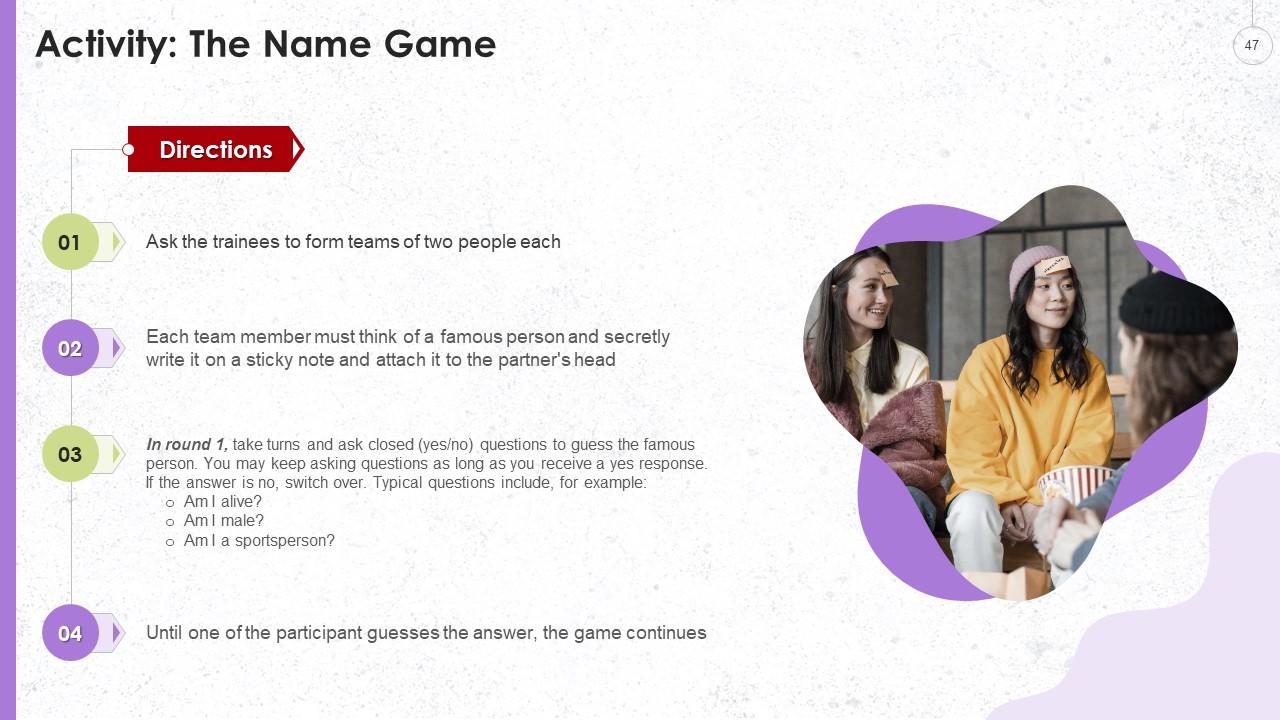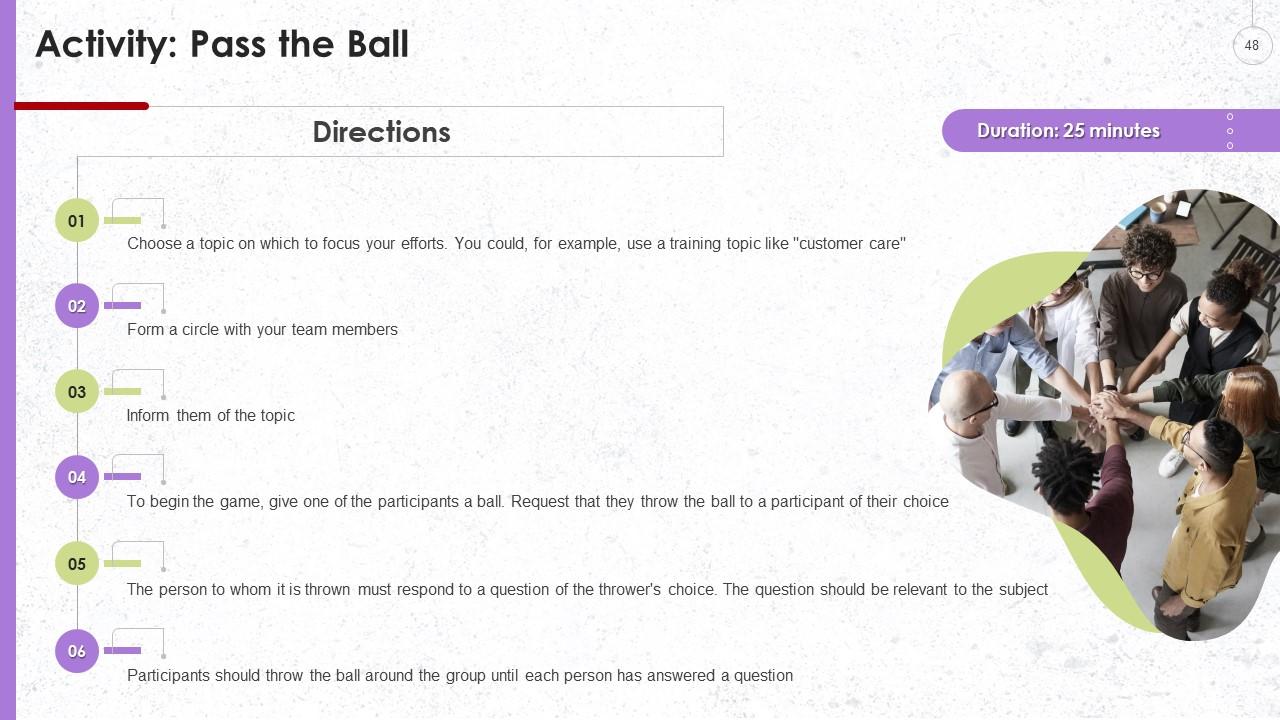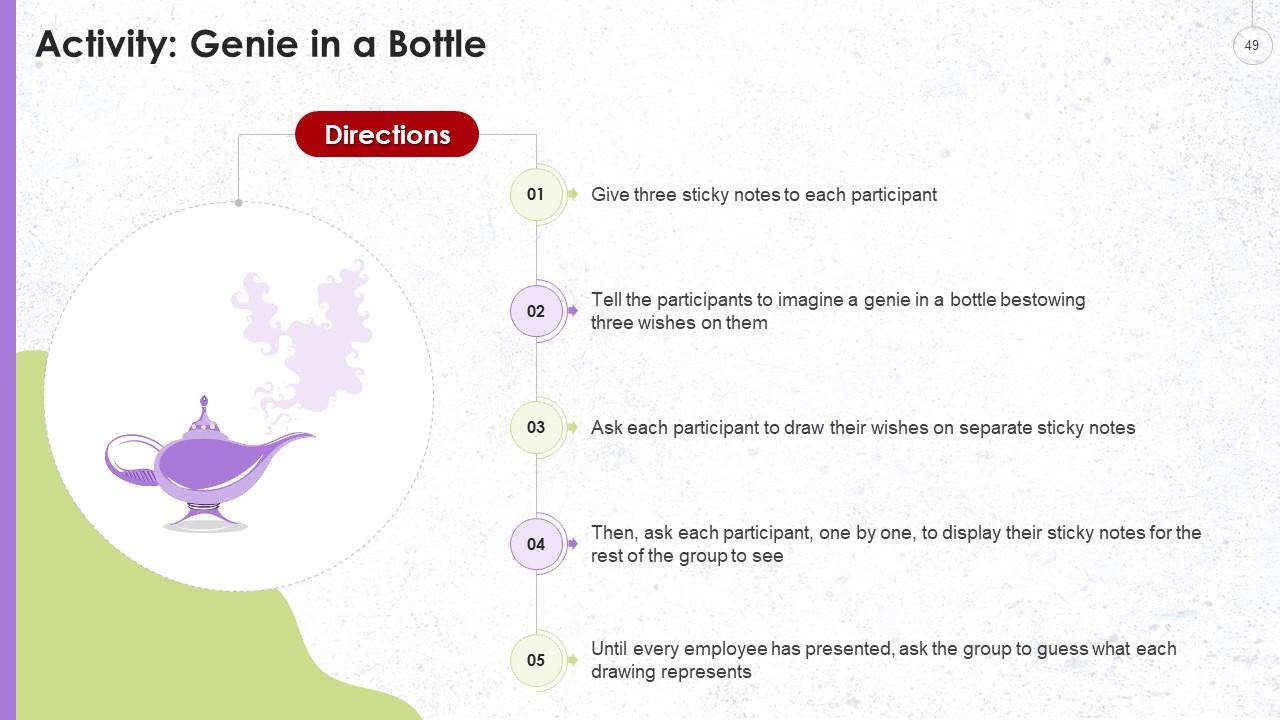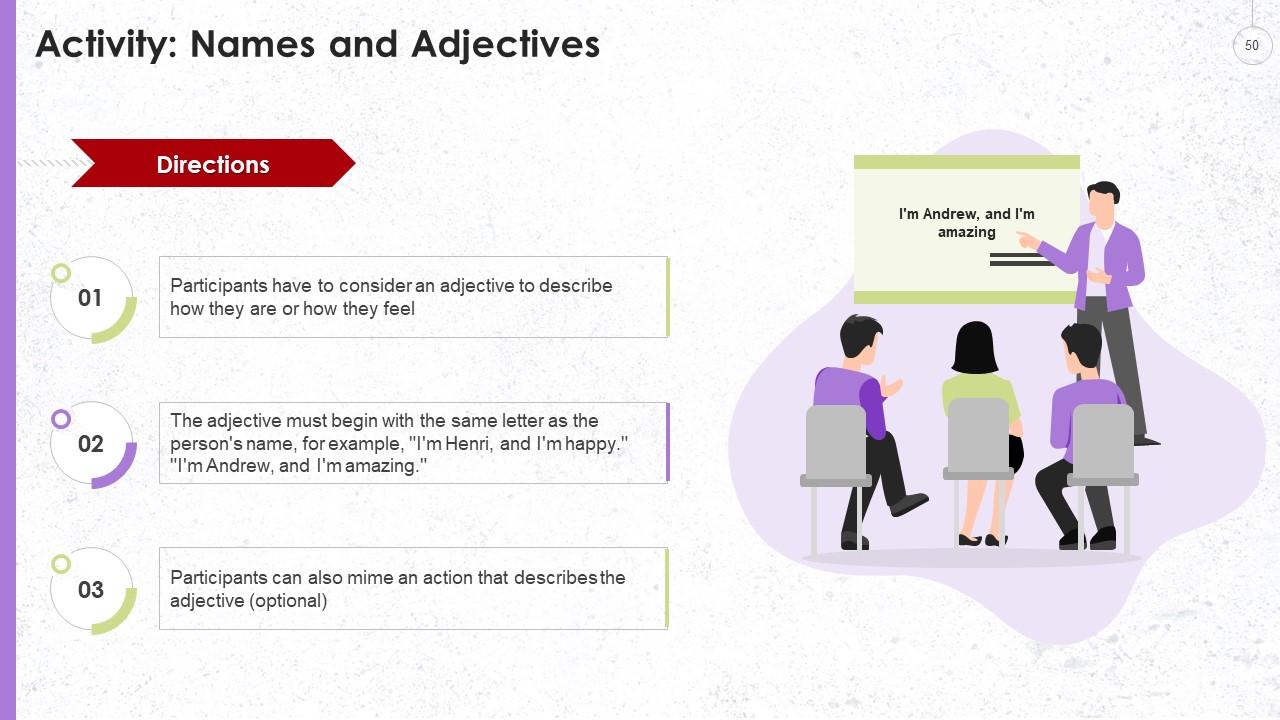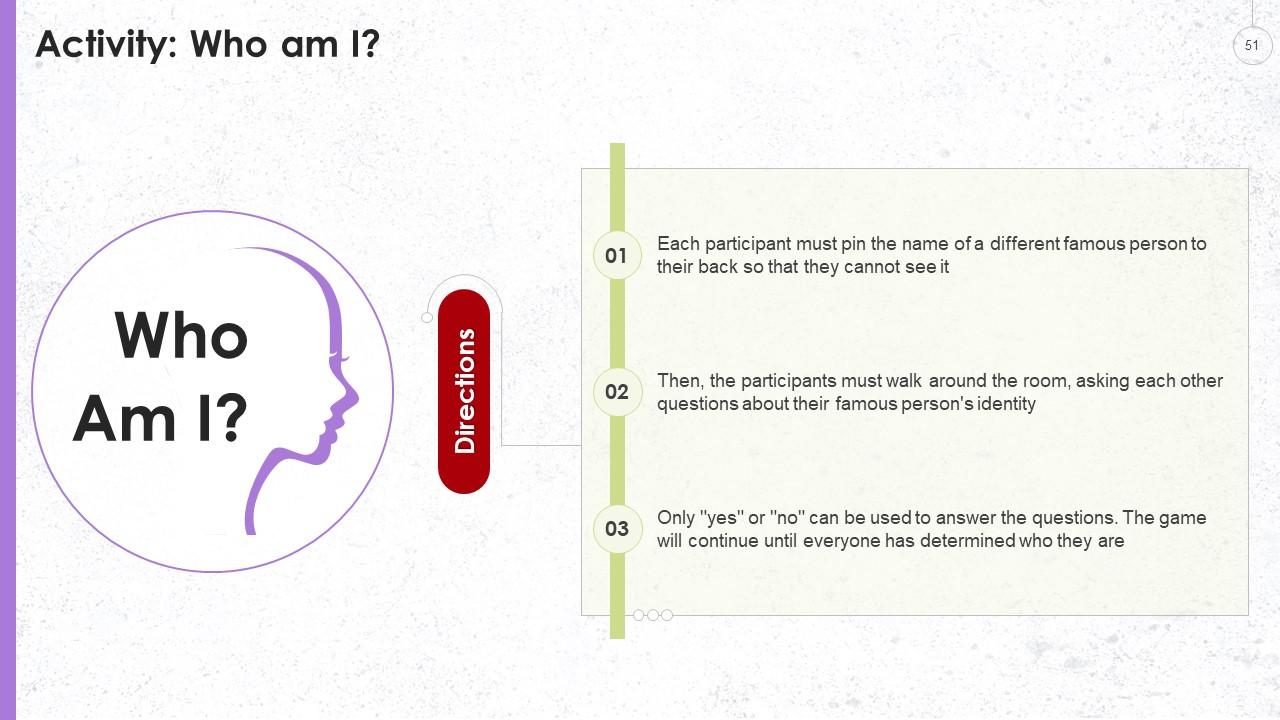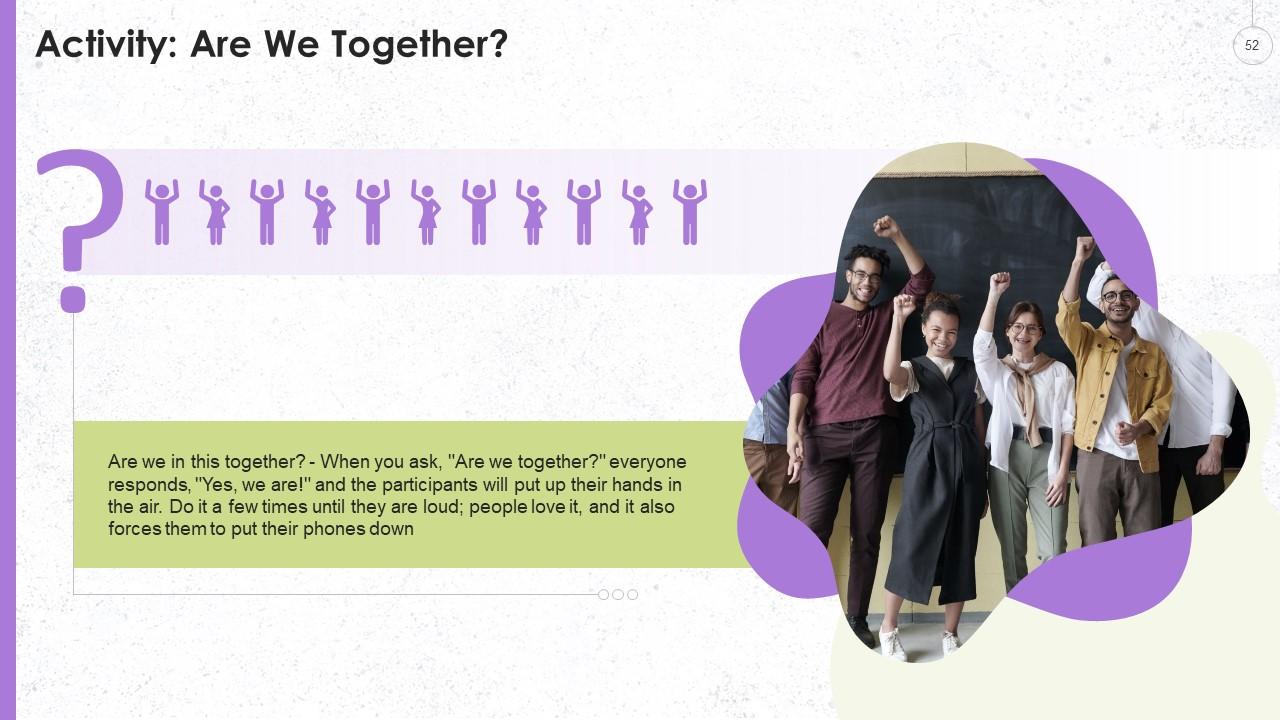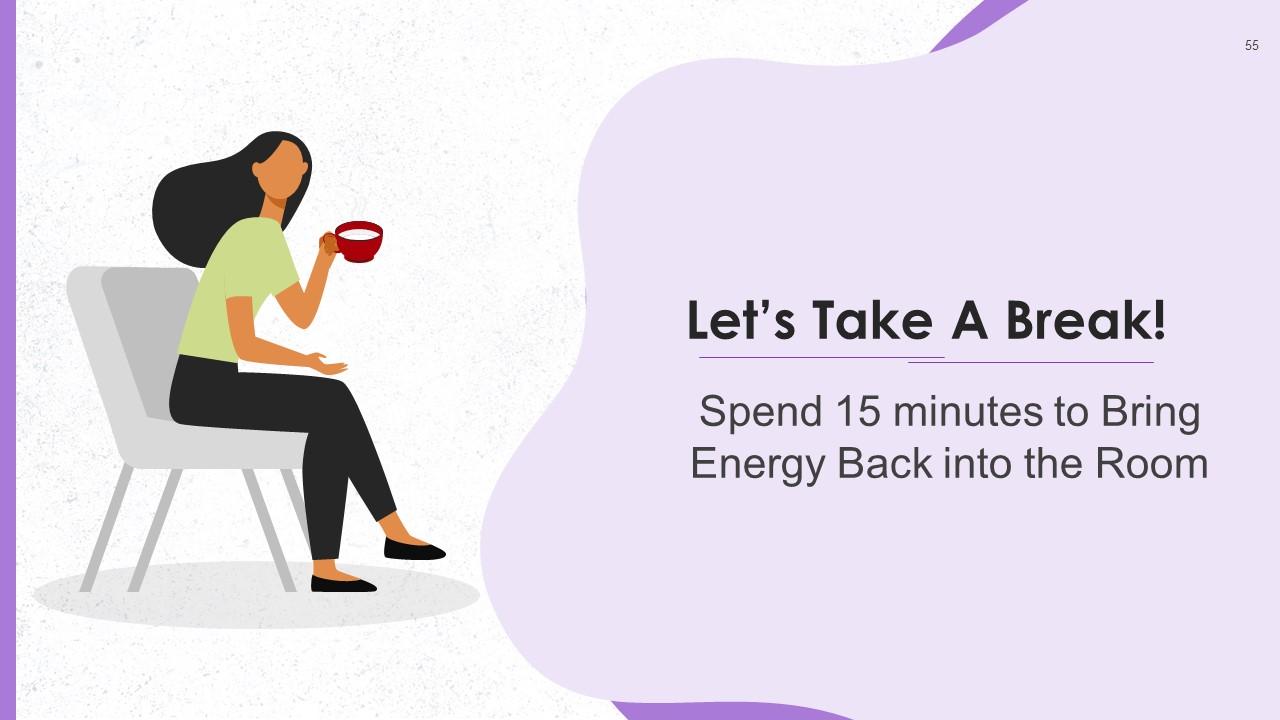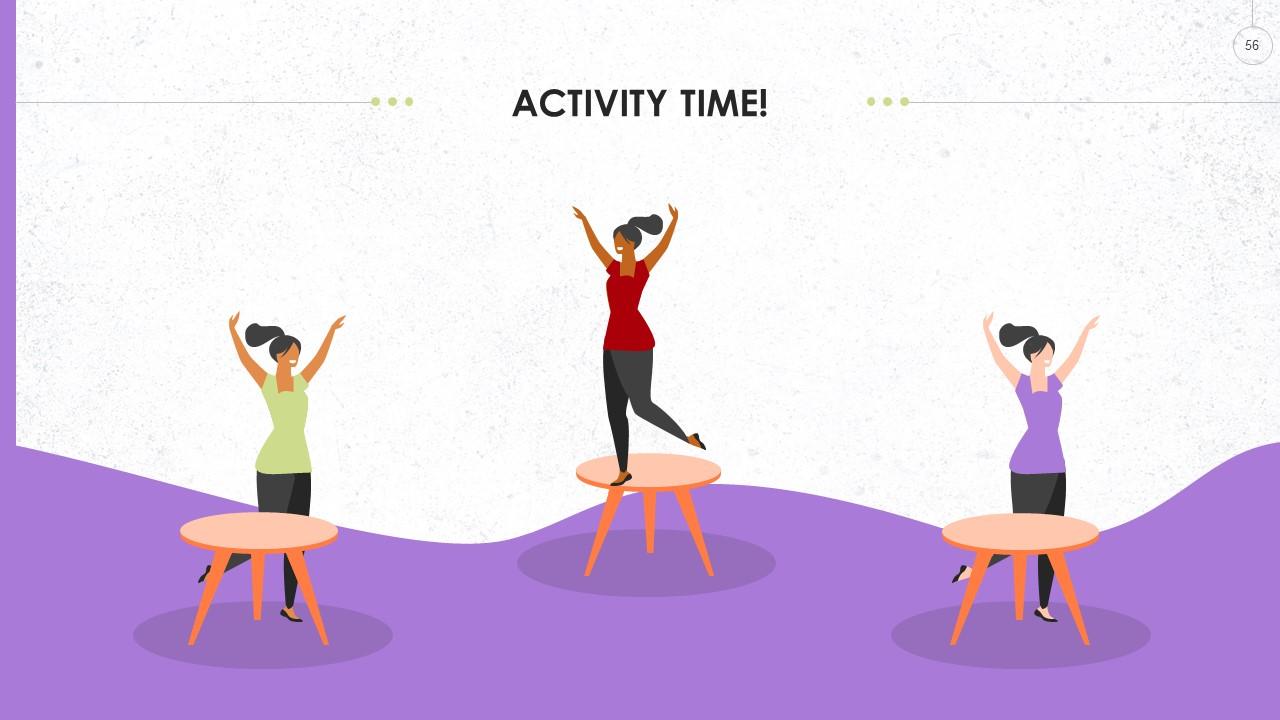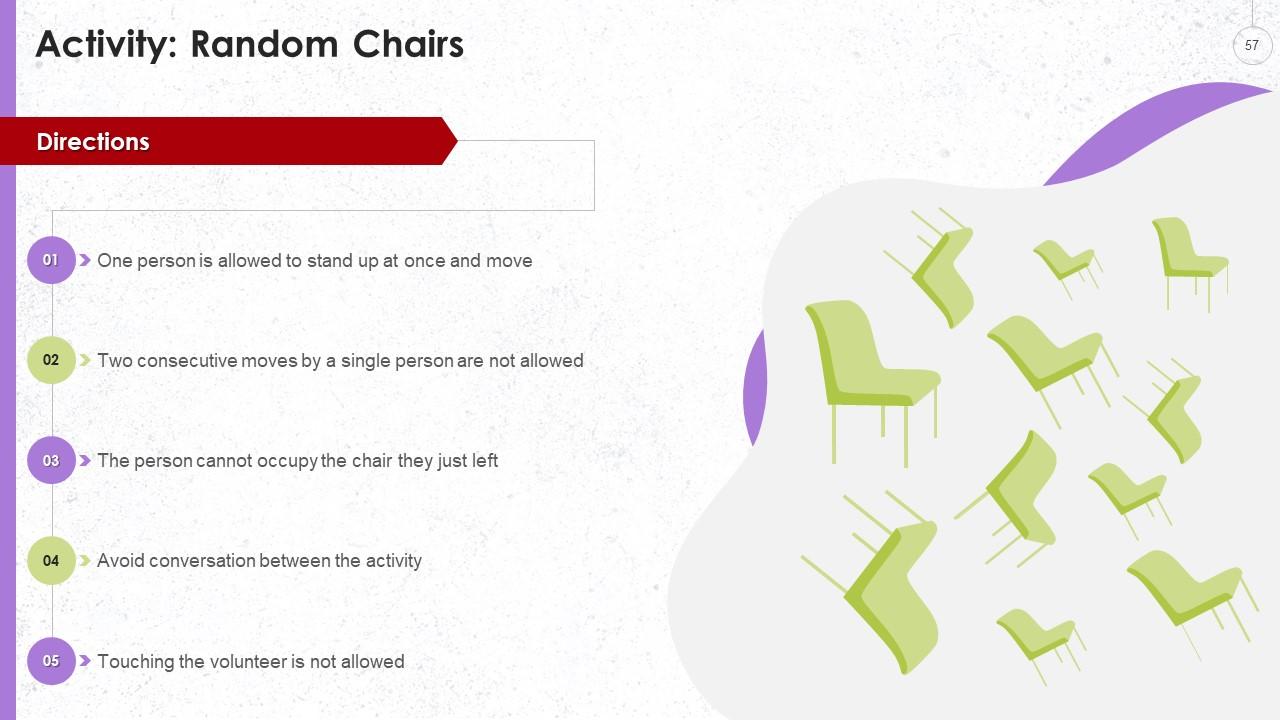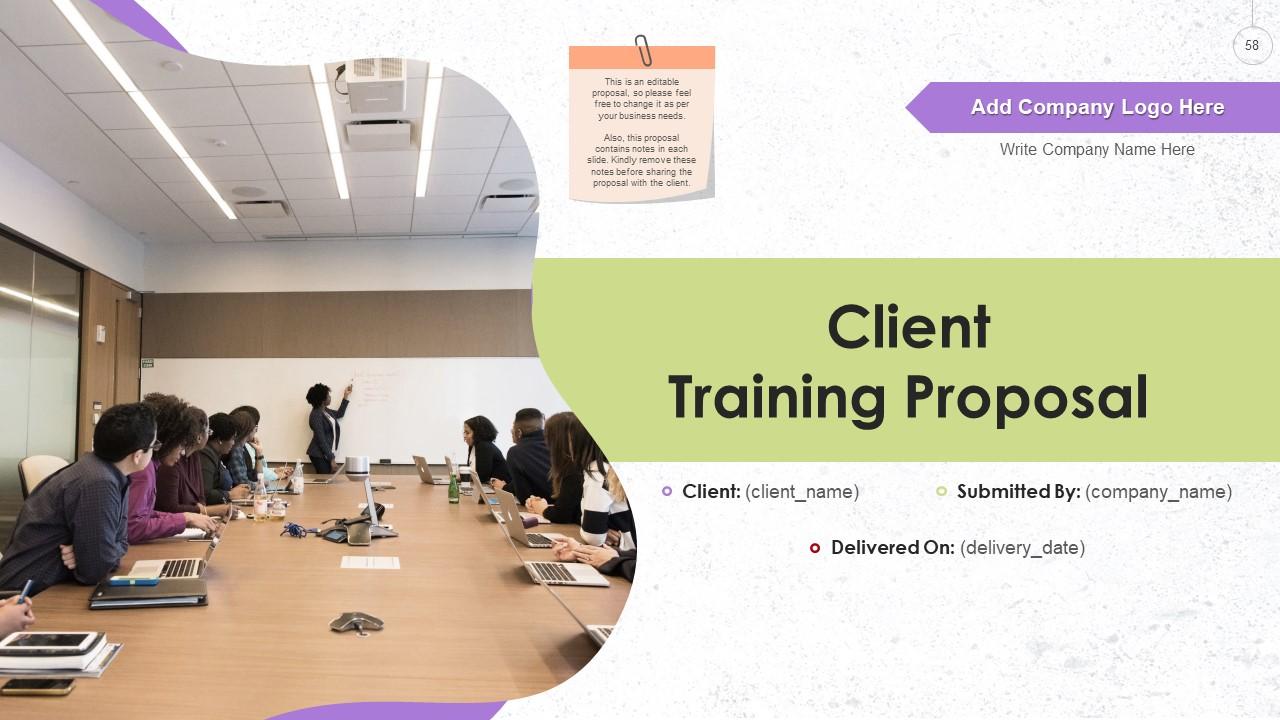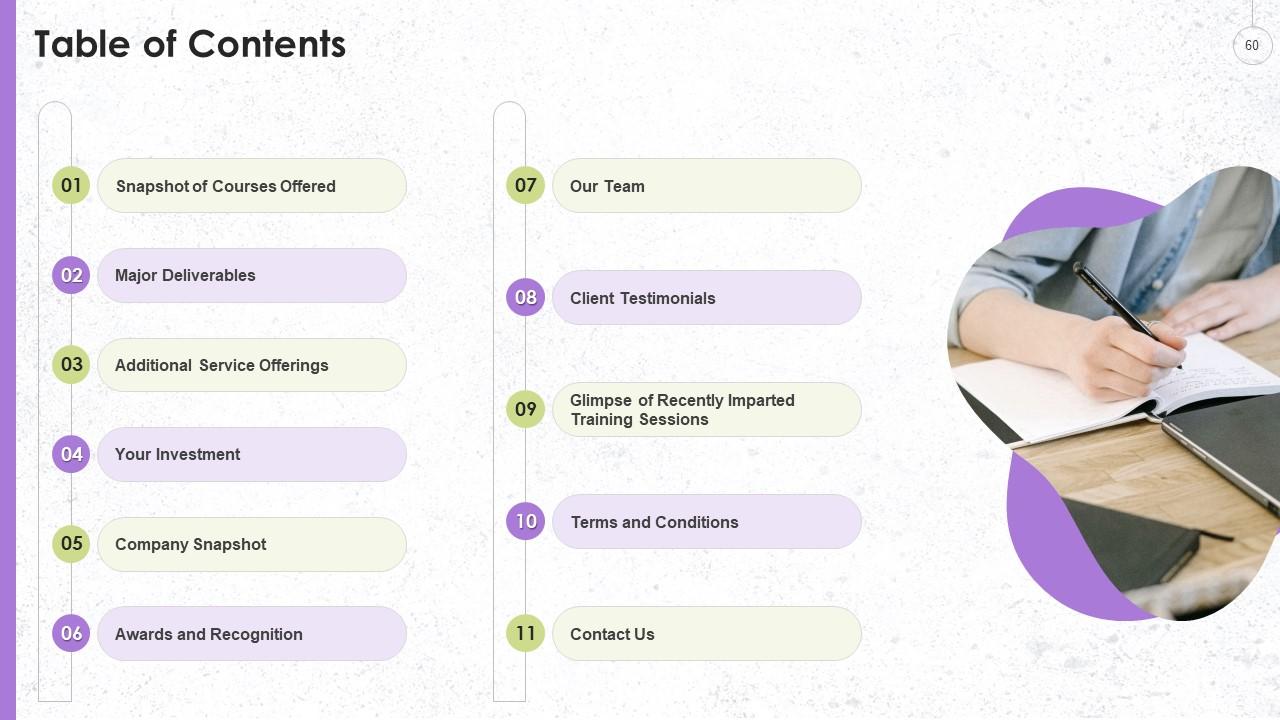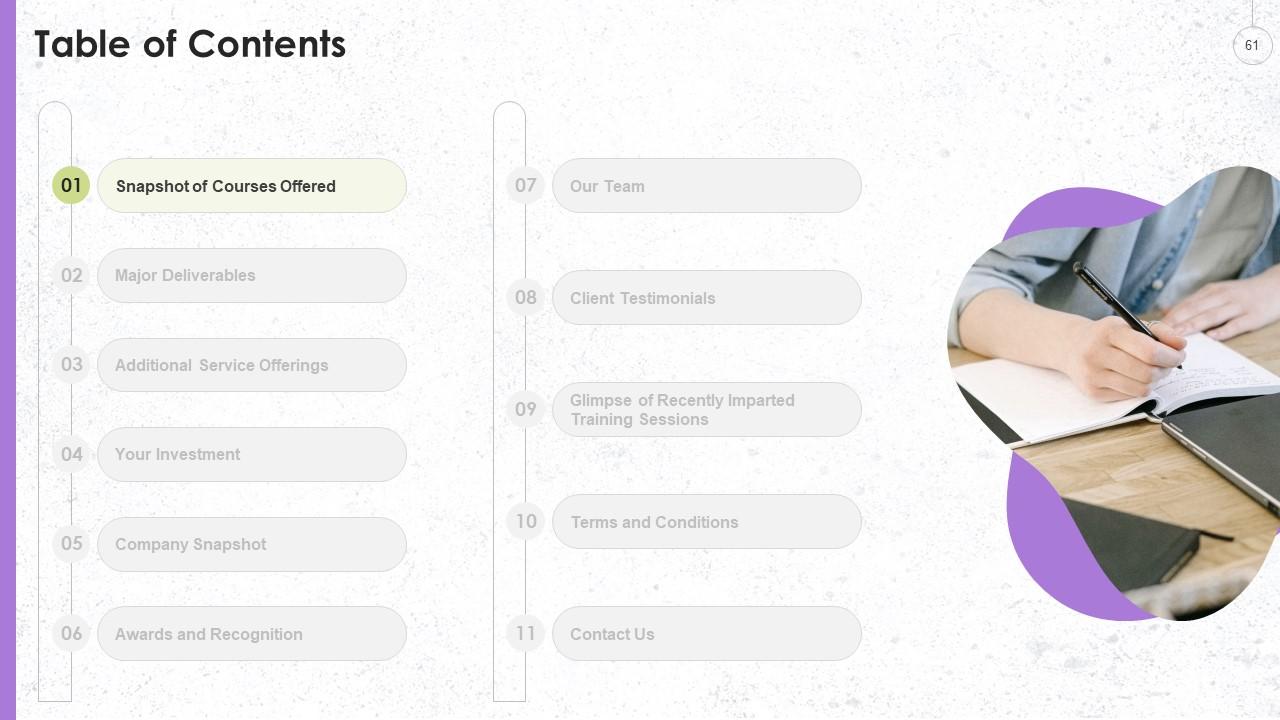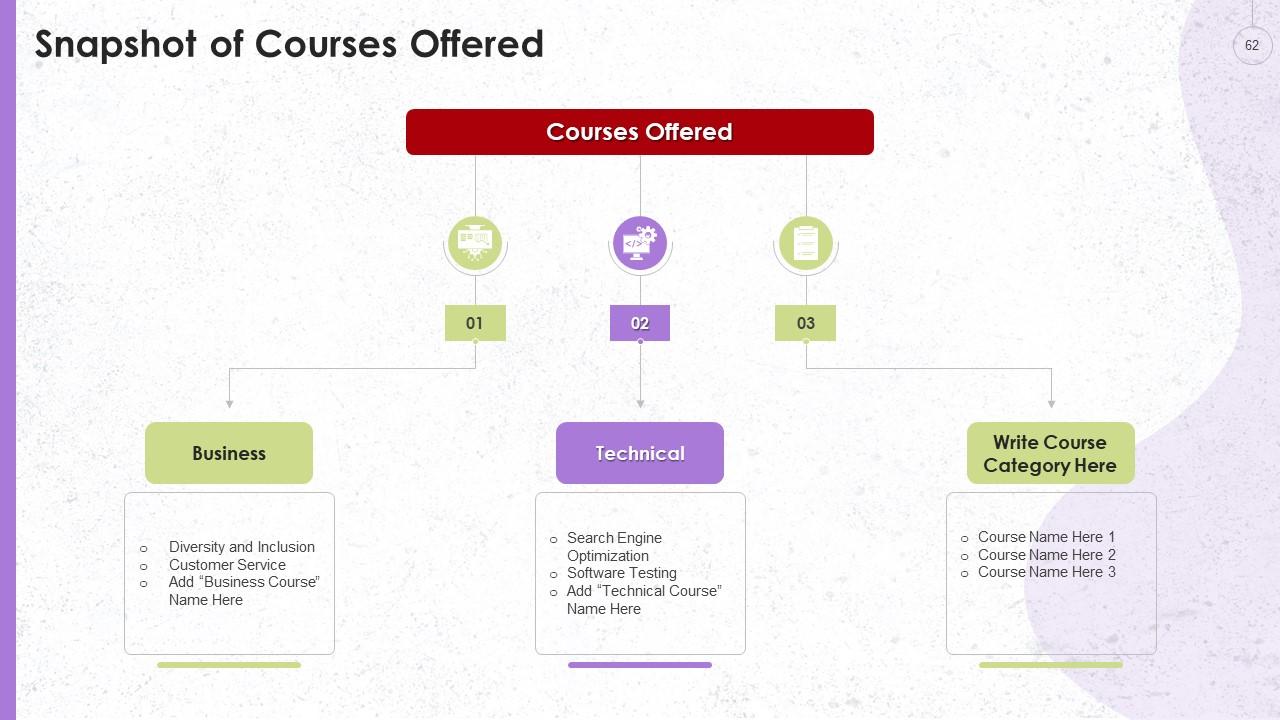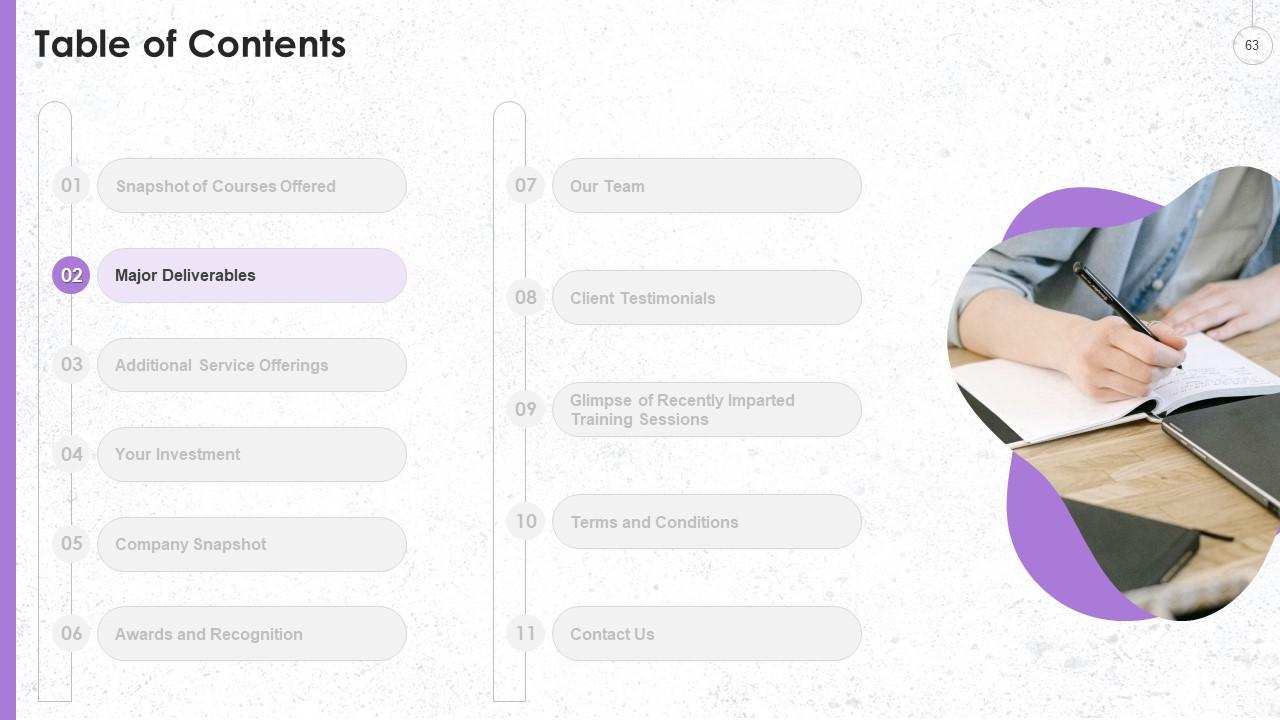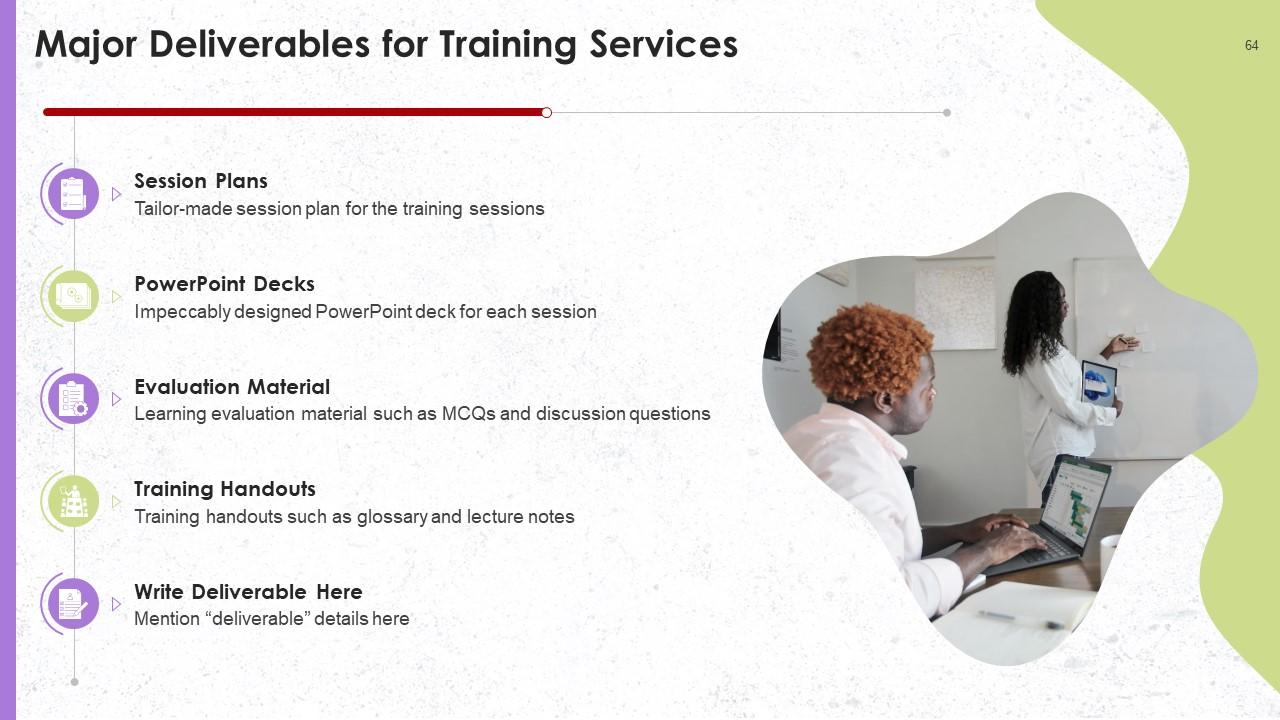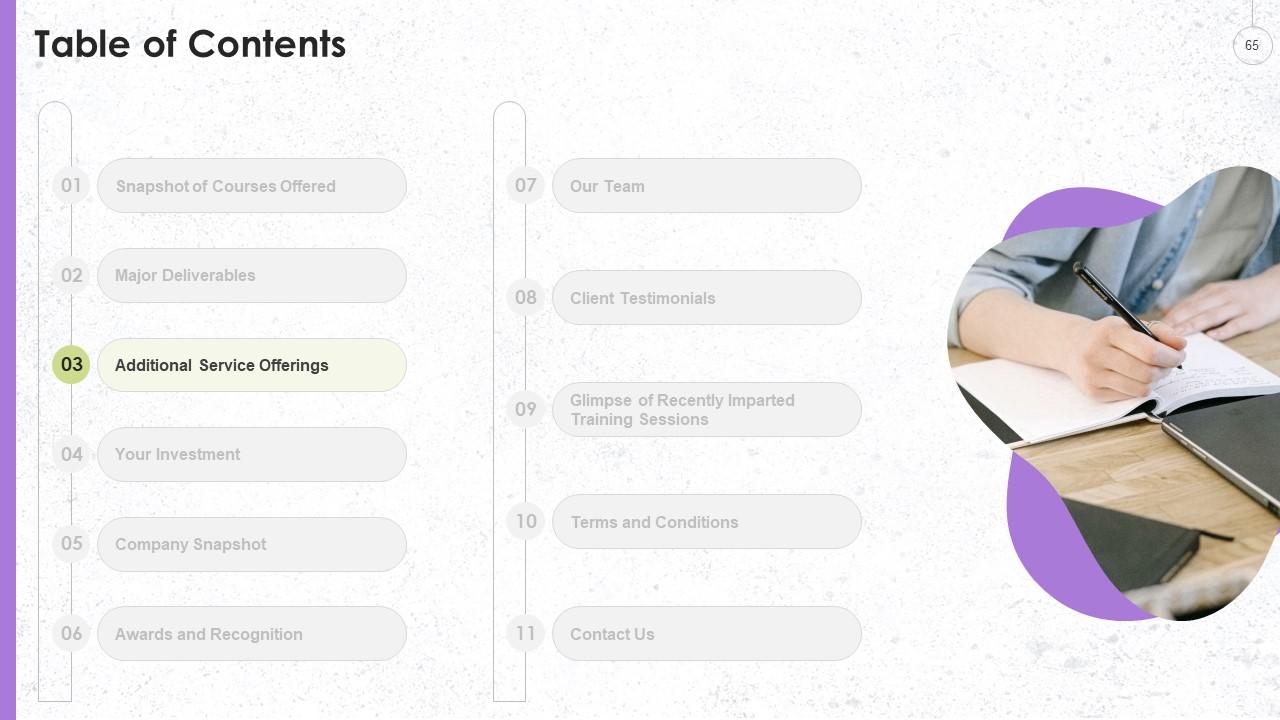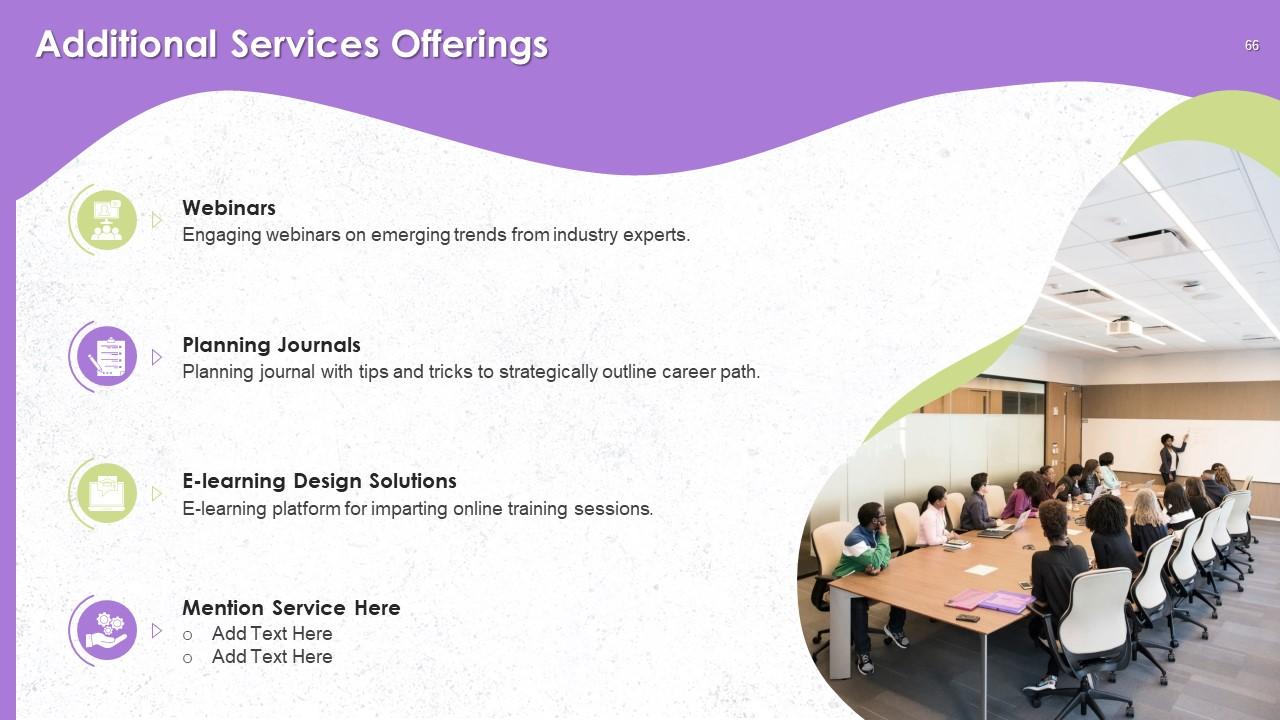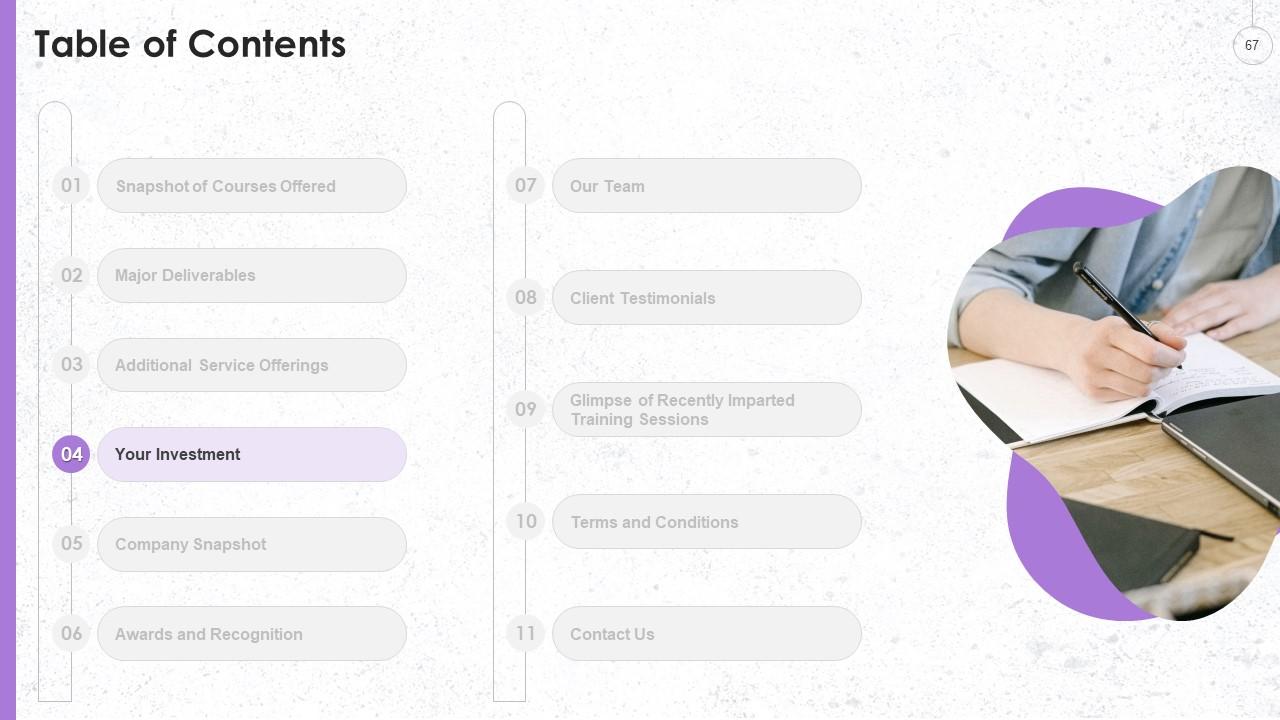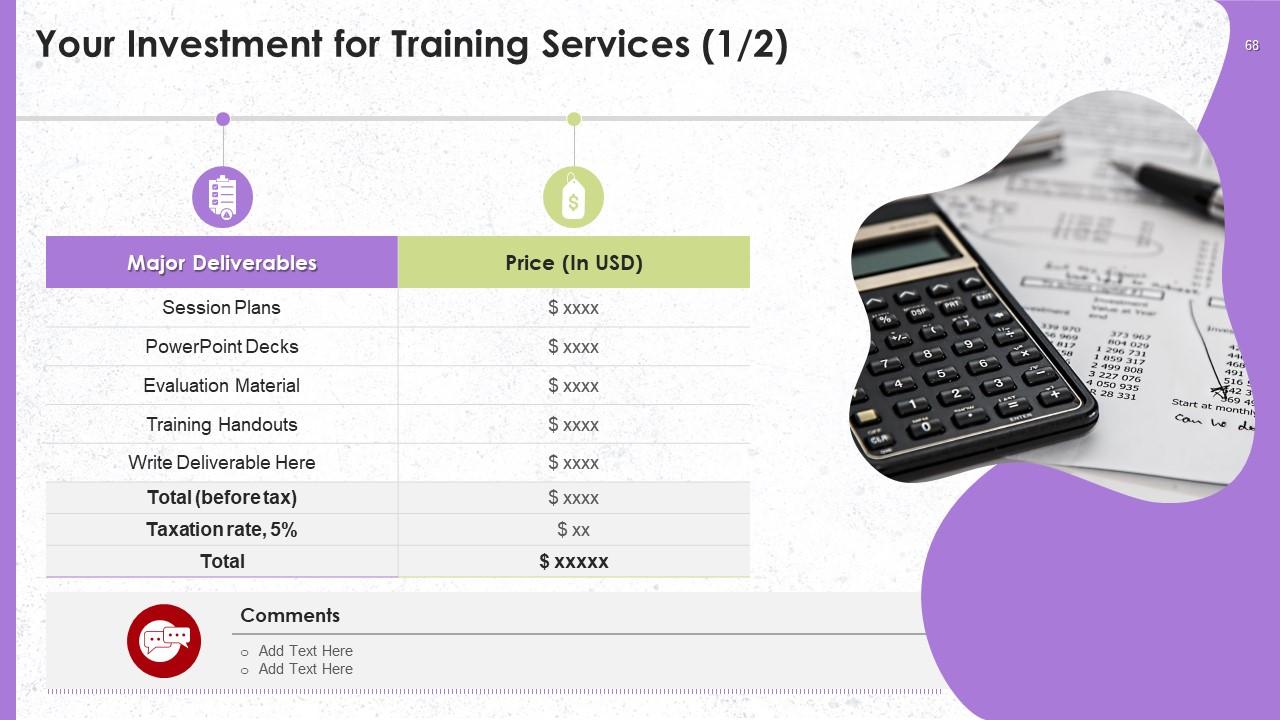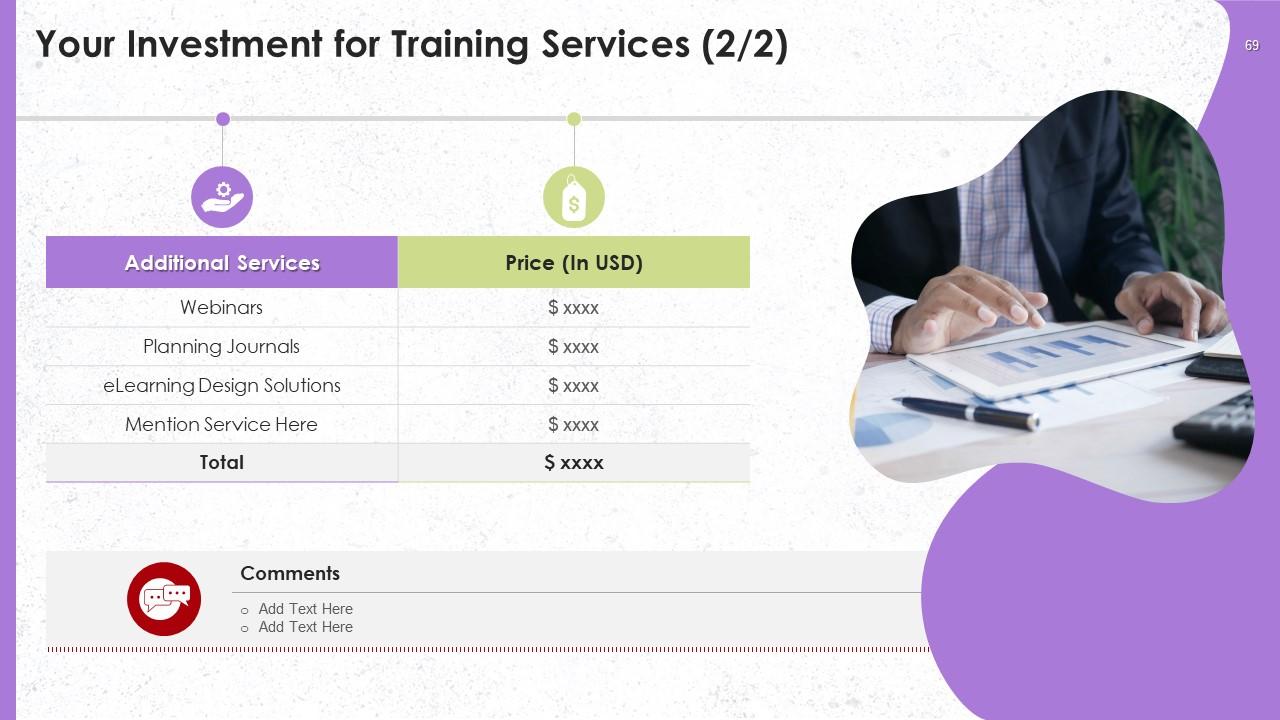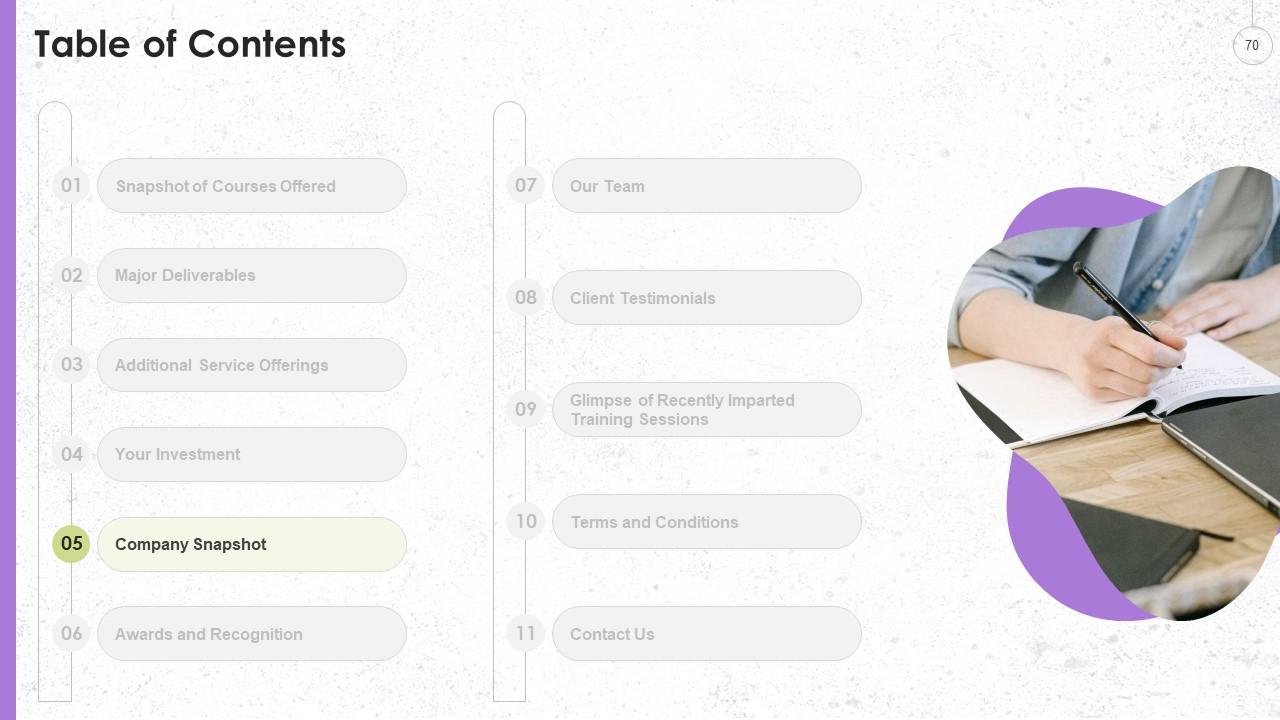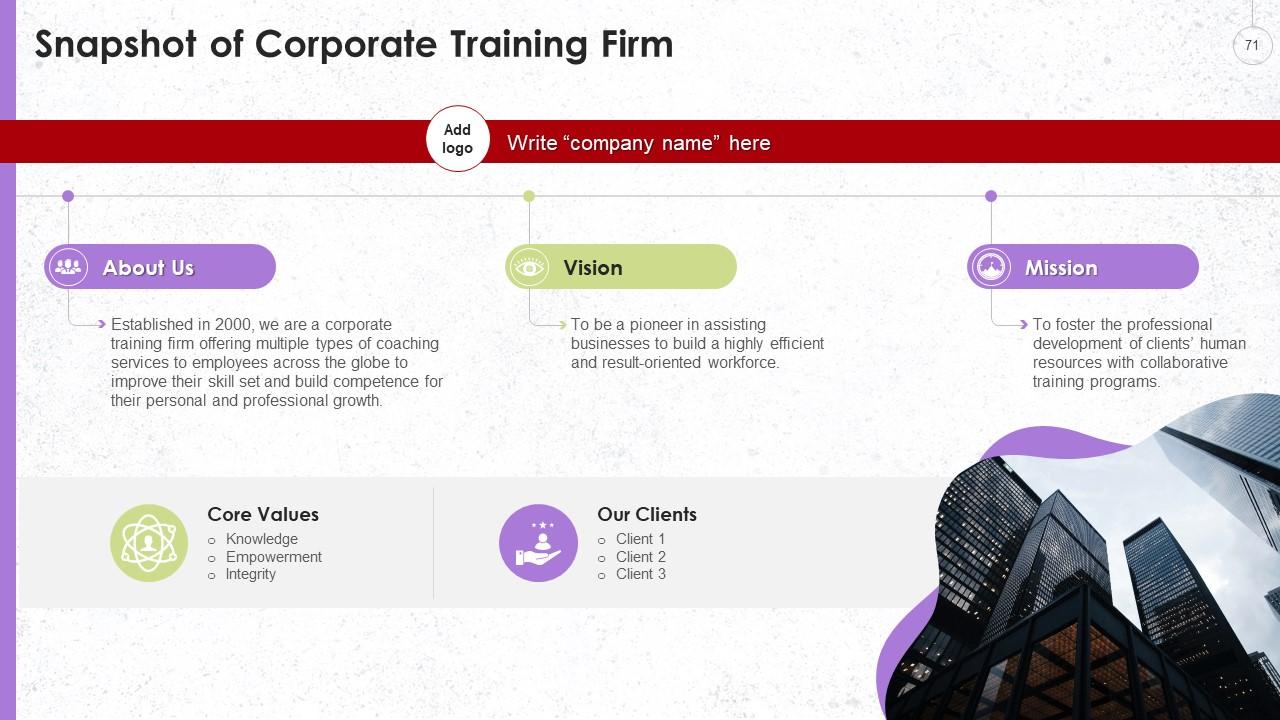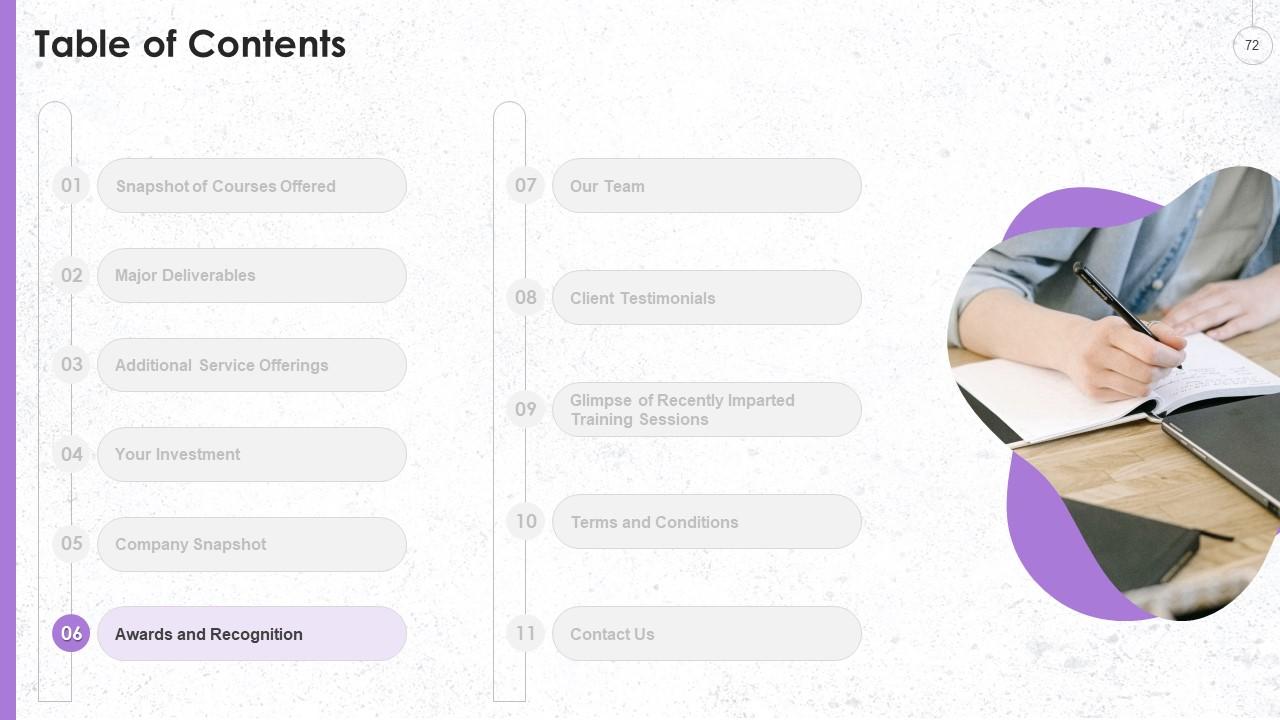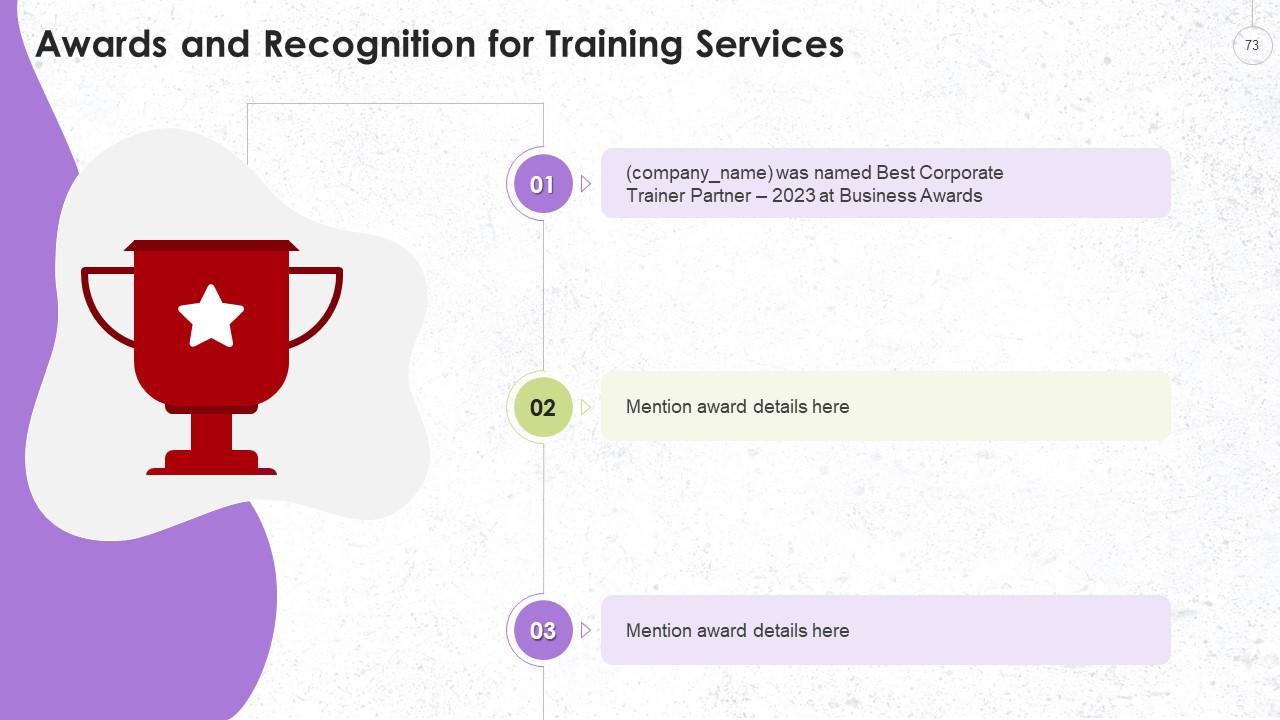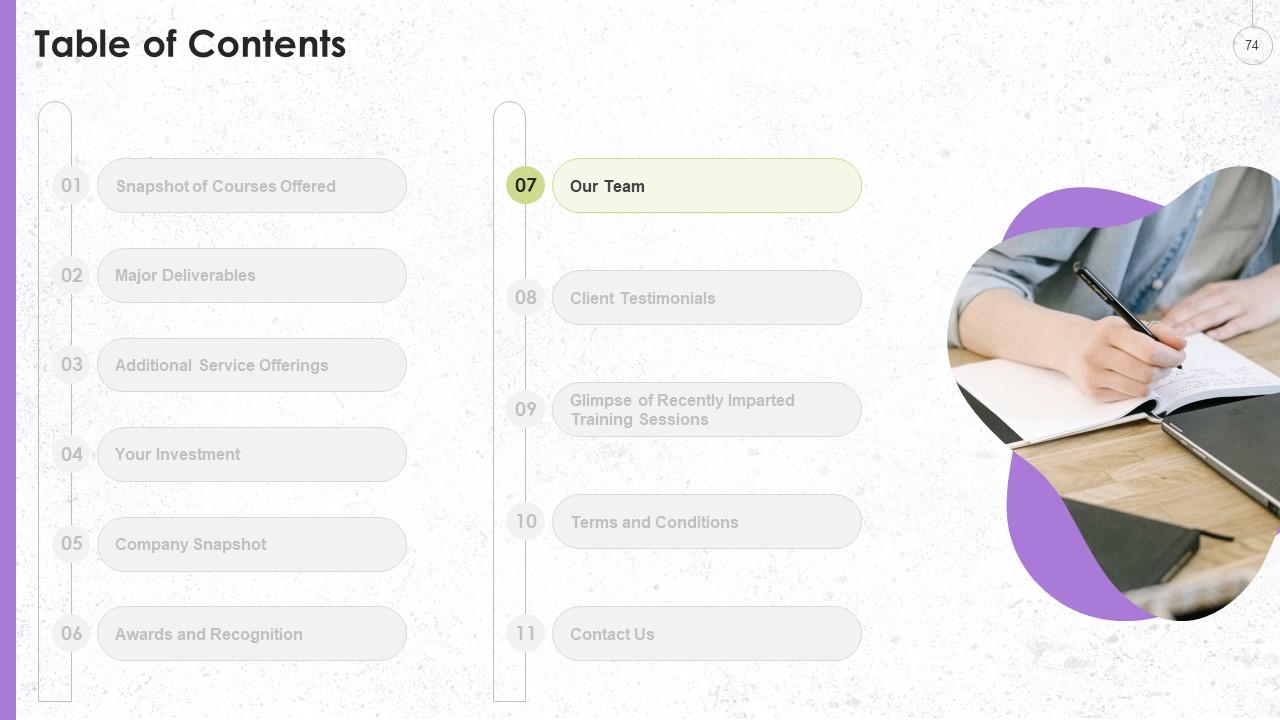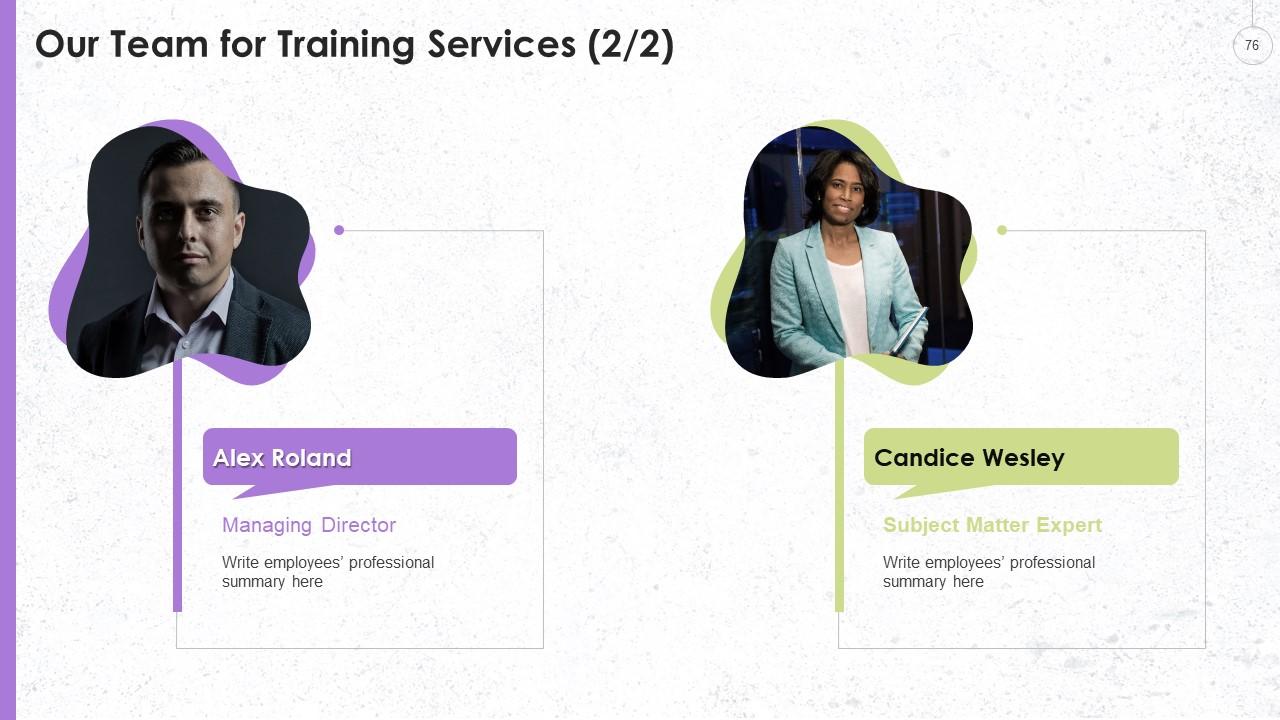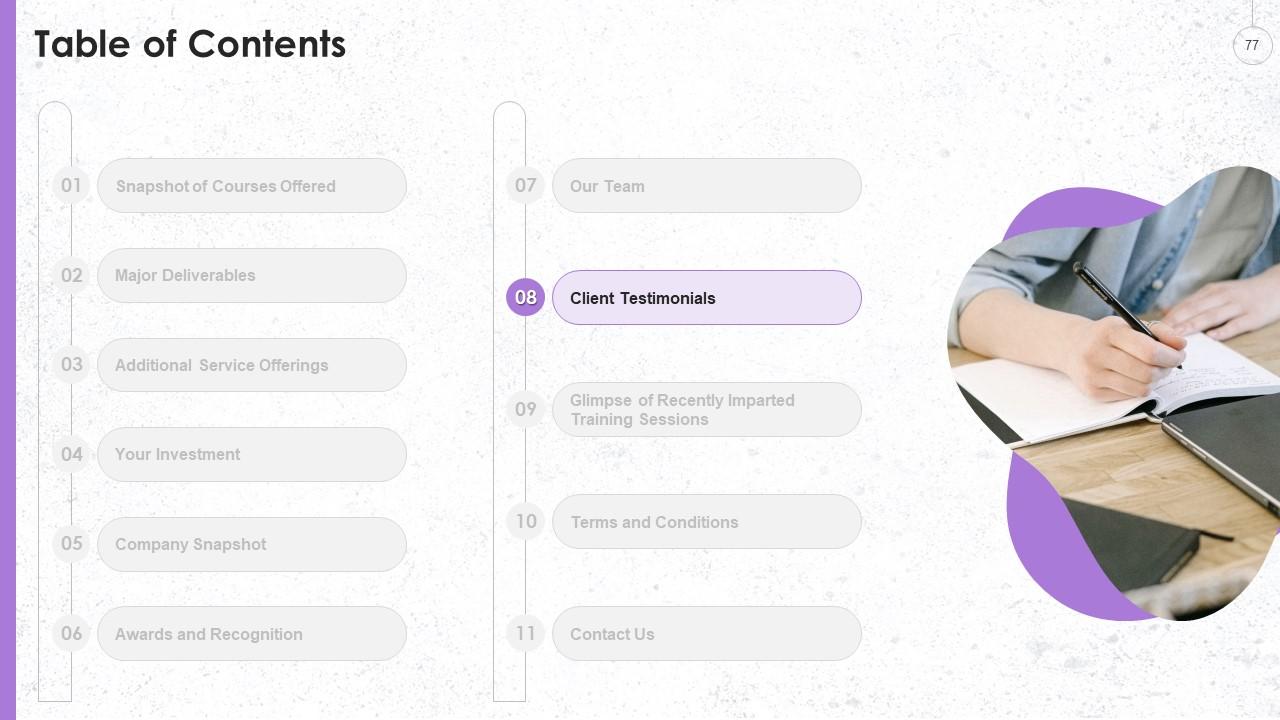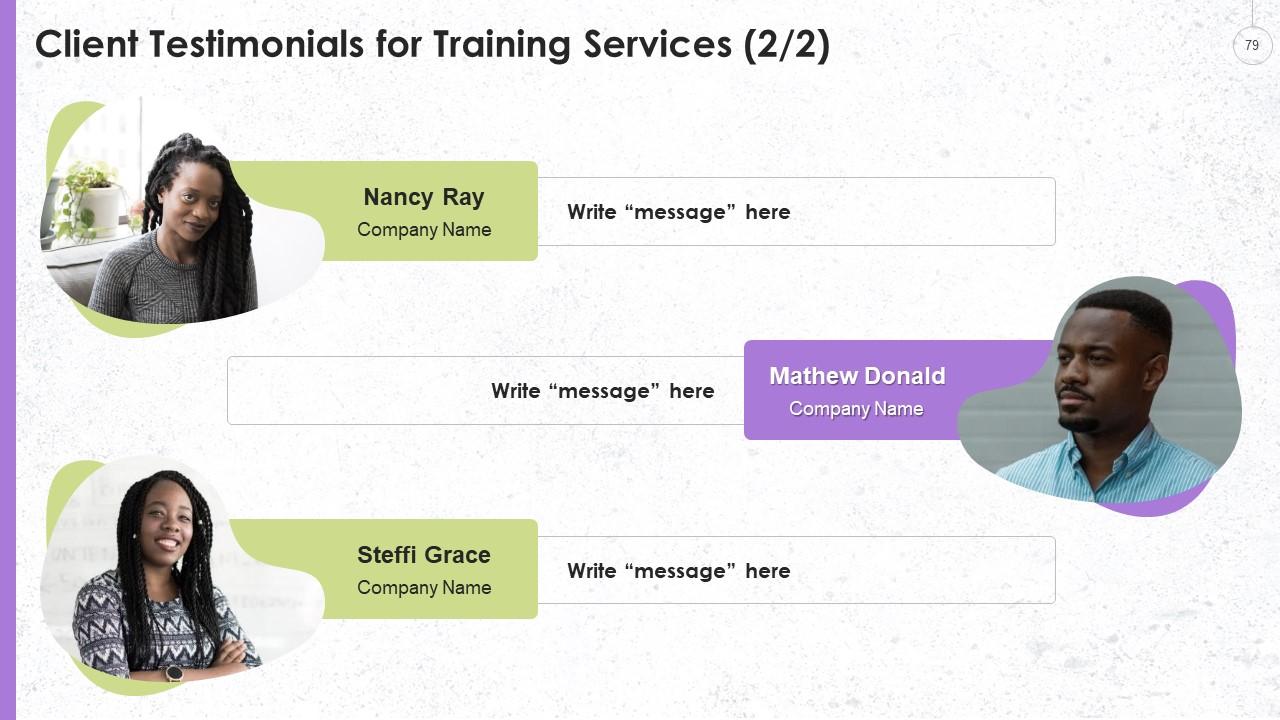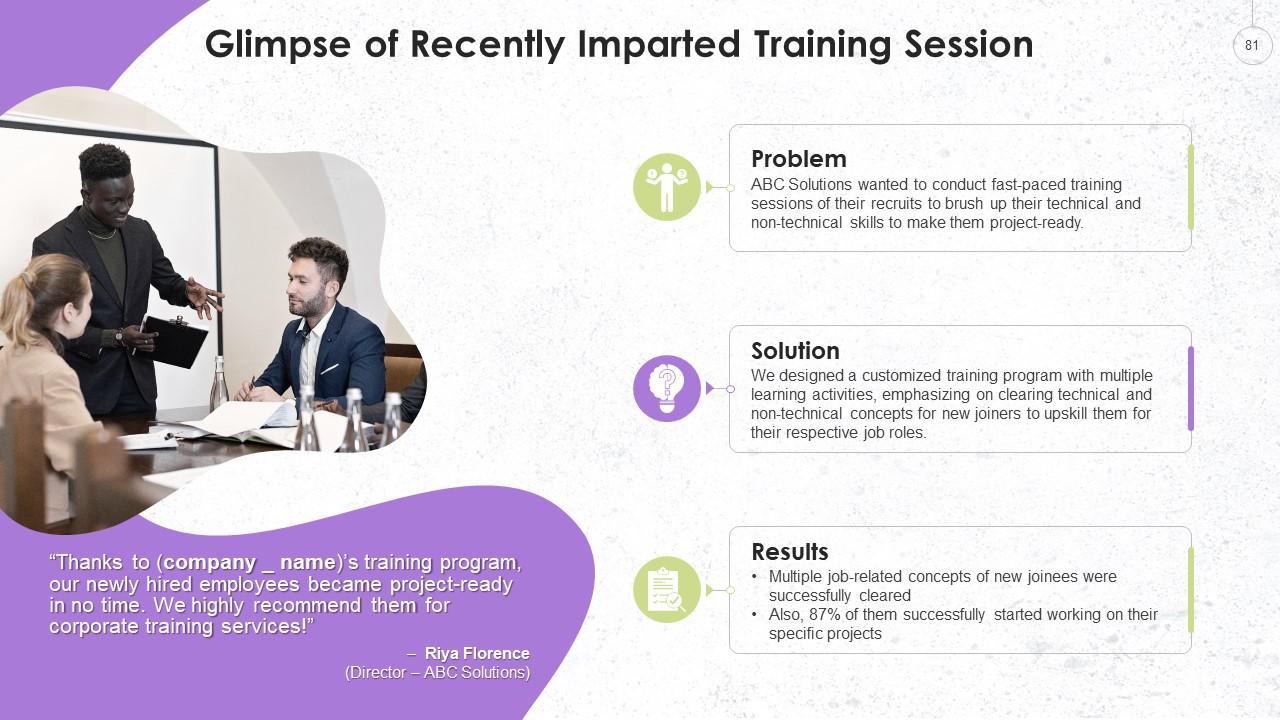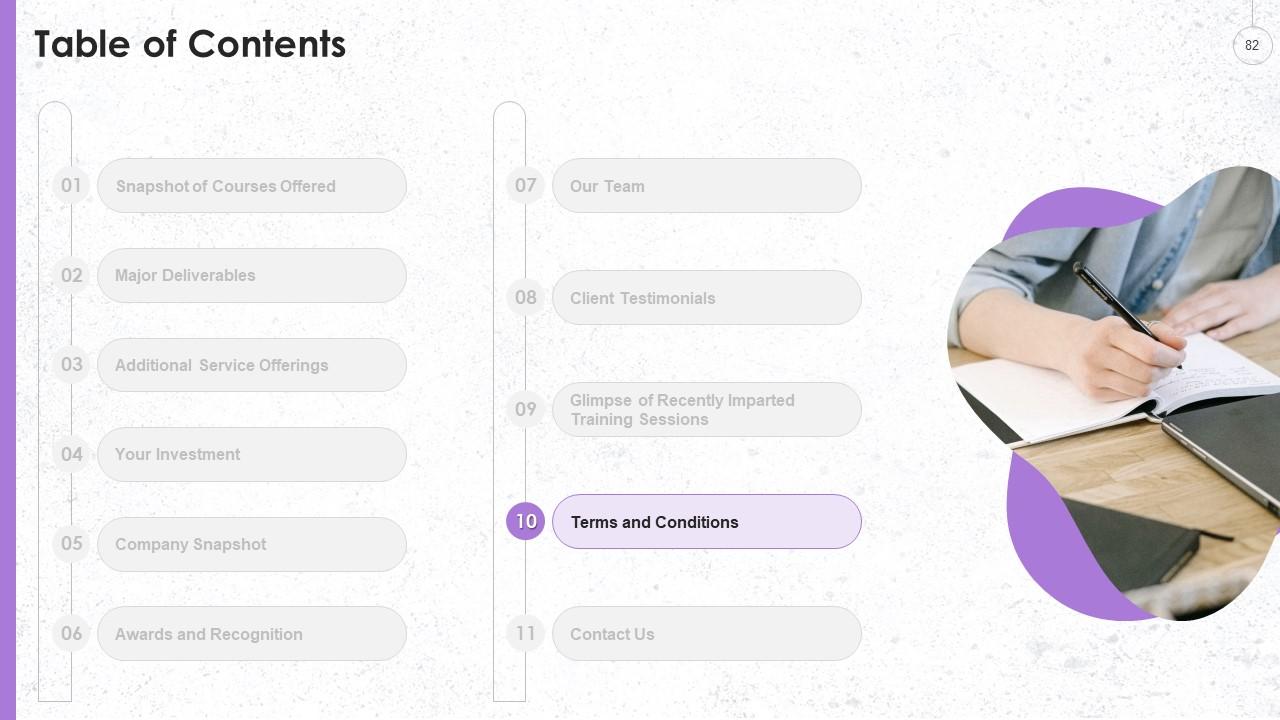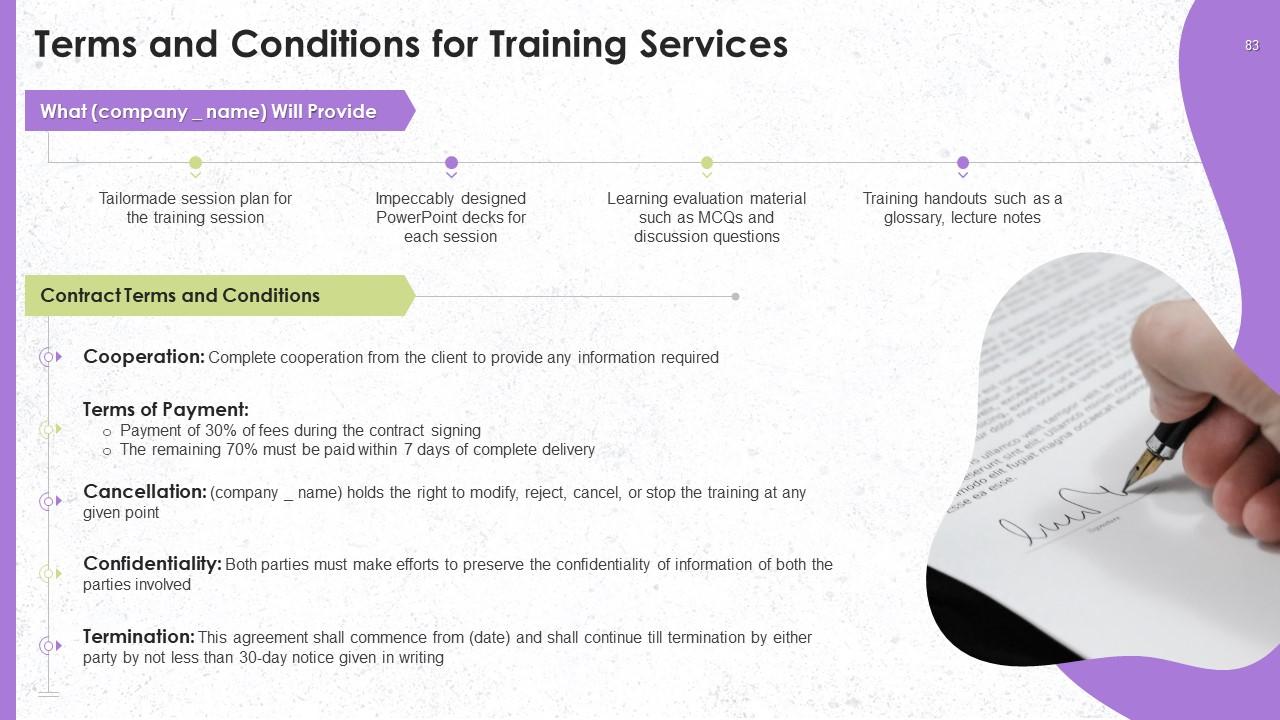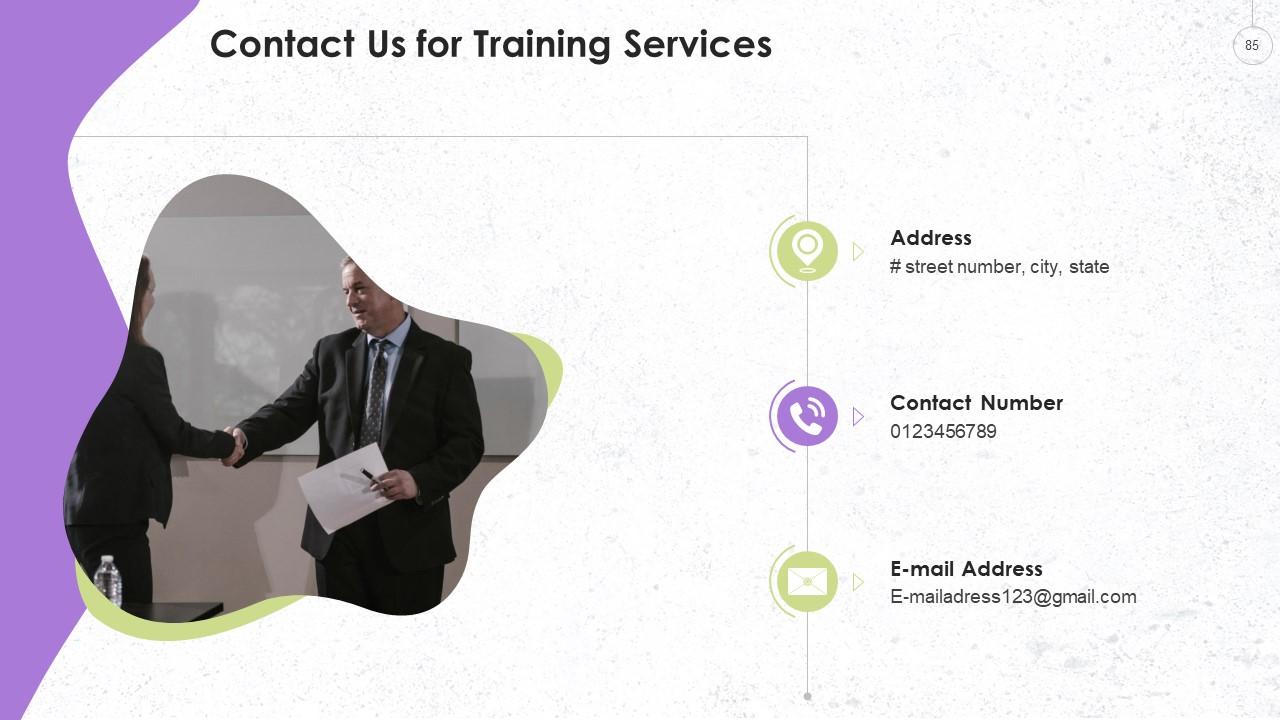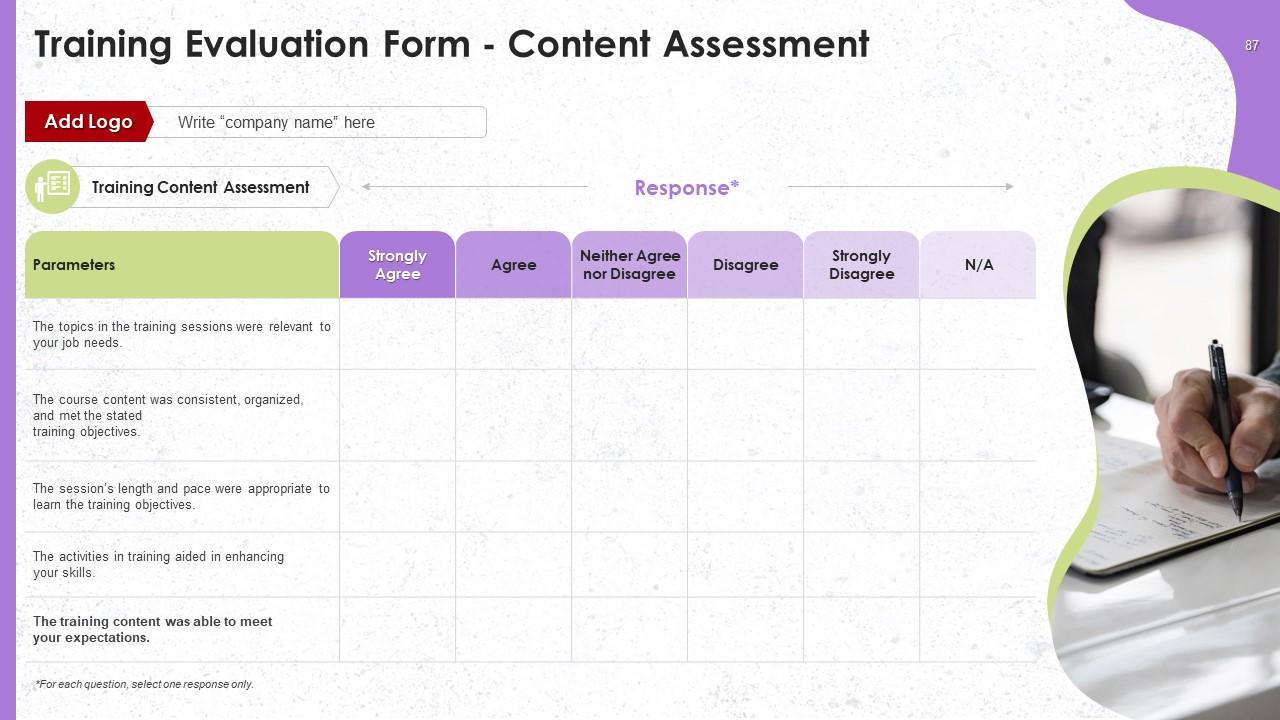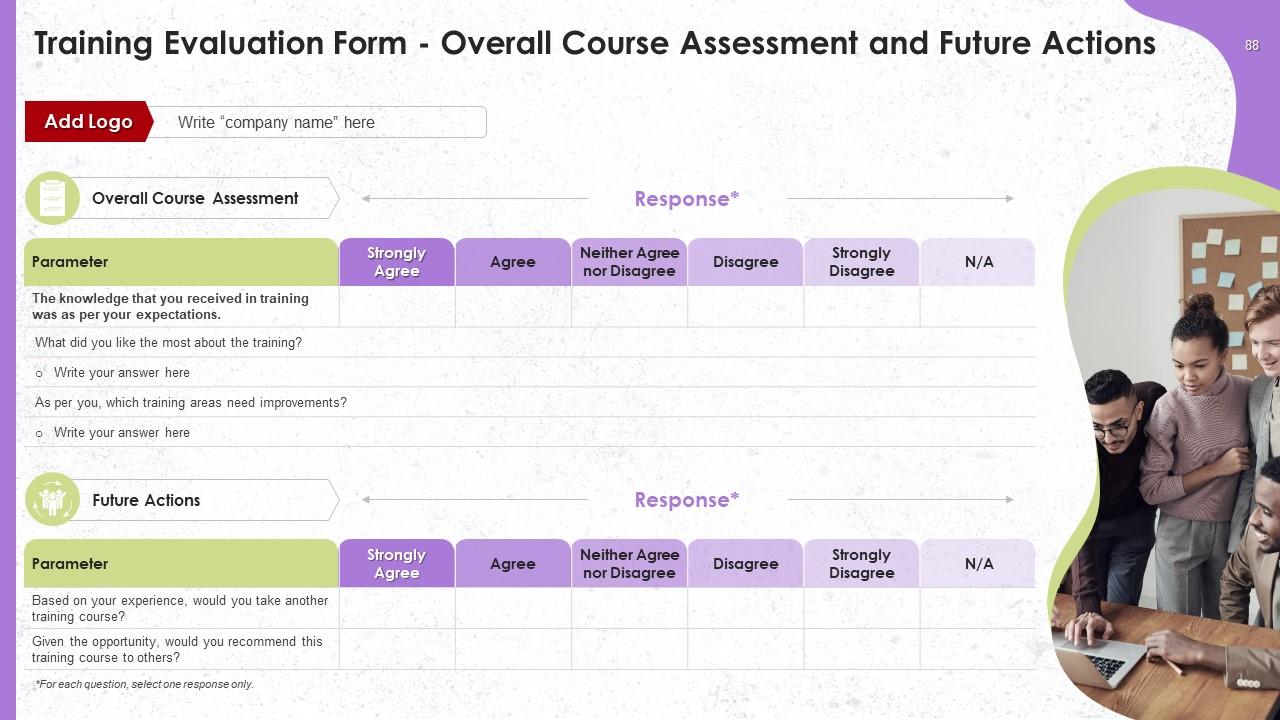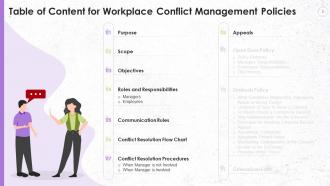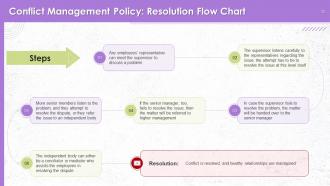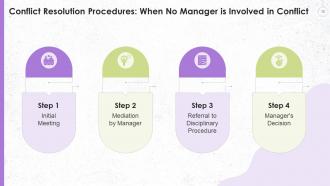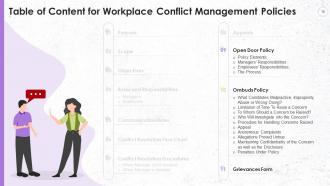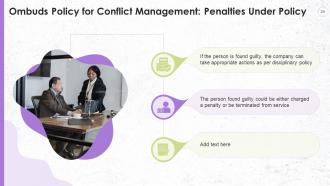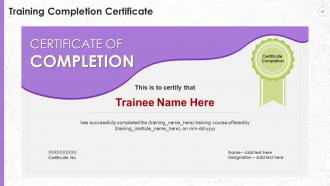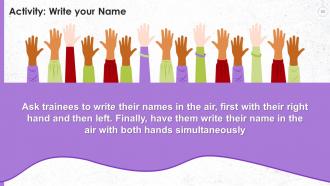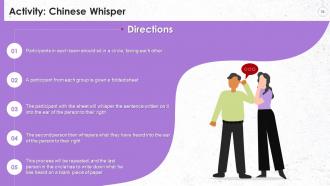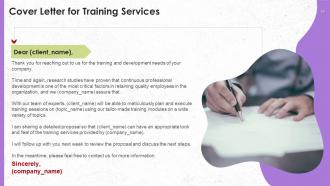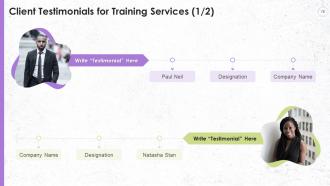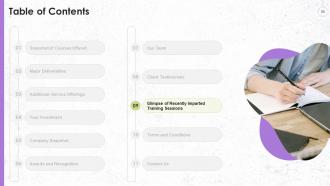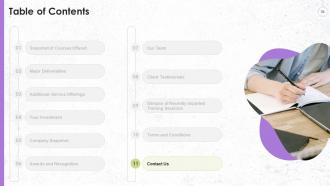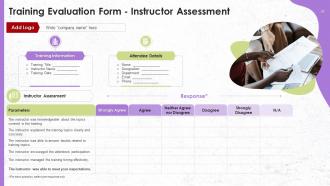Workplace Conflict Management Policies Training Ppt
This training module on Workplace Conflict Management Policies contains a compendium of templatized documents that managers can utilize to create conflict prevention and resolution guidelines in their organization. The multiple headers are the purpose, scope, objectives, roles, responsibilities of managers and employees, and communication rules. It also has a conflict resolution flowchart and procedures, appeals, and grievances form. Further, it has a detailed Open Door Policy and Ombuds Policy. The deck has PPT slides on about us, vision, mission, goal, 30-60-90 days plan, timeline, roadmap, and training completion certificate. It has energizer activities to make the coaching session more interactive. It also includes a client proposal and assessment form for training evaluation.
- Google Slides is a new FREE Presentation software from Google.
- All our content is 100% compatible with Google Slides.
- Just download our designs, and upload them to Google Slides and they will work automatically.
- Amaze your audience with SlideTeam and Google Slides.
-
Want Changes to This PPT Slide? Check out our Presentation Design Services
- WideScreen Aspect ratio is becoming a very popular format. When you download this product, the downloaded ZIP will contain this product in both standard and widescreen format.
-

- Some older products that we have may only be in standard format, but they can easily be converted to widescreen.
- To do this, please open the SlideTeam product in Powerpoint, and go to
- Design ( On the top bar) -> Page Setup -> and select "On-screen Show (16:9)” in the drop down for "Slides Sized for".
- The slide or theme will change to widescreen, and all graphics will adjust automatically. You can similarly convert our content to any other desired screen aspect ratio.
Compatible With Google Slides

Get This In WideScreen
You must be logged in to download this presentation.
PowerPoint presentation slides
Presenting Training Deck on Workplace Conflict Management Policies. This deck comprises of 88 slides. Each slide is well crafted and designed by our PowerPoint experts. This PPT presentation is thoroughly researched by the experts, and every slide consists of appropriate content. All slides are customizable. You can add or delete the content as per your need. Not just this, you can also make the required changes in the charts and graphs. Download this professionally designed business presentation, add your content and present it confidently.
People who downloaded this PowerPoint presentation also viewed the following :
Content of this Powerpoint Presentation
Slide 4
This slide lists the purpose of workplace conflict management policy. It explains that conflict management policy is a framework for resolving conflict and complaints between all employees of an organization.
Instructor's Notes:
You might want to replace the text with its equivalent purpose of your own organization
Slide 5
This slide lists the scope of workplace conflict management policies. It is applicable to all the employees working in the organization.
Instructor's Notes:
Kindly modify this as per business requirements of your organizations
Slide 6
This slide lists the objectives of the conflict management policies. It also explains that conflict management policy helps to provide on-time and satisfactory conflict resolution in a cost-effective manner.
Slide 7
This slide lists the roles and responsibilities of managers at workplace conflict management policy. It explains that managers should take all decisions at work in a fair and consistent manner.
Slide 8
This slide lists the roles and responsibilities of employees in conflict management. It explains that the employees need to understand the purpose and content of the policy.
Slide 9
This slide showcases the use of communication rules in resolving workplace conflicts. It explains that this policy is committed to resolve disputes and problems at every level possible.
Slide 10
This slide showcases the use of direct communication in resolving workplace conflicts. It explains that conflict with co-workers or supervisors should be first brought to the attention of the others person(s) and they should try to resolve the conflict to the best of their ability.
Slide 11
This slide showcases the use of assisted communication in resolving workplace conflicts. It explains that if direct communication is not successful then employees can request for their immediate supervisor.
Slide 12
This slide lists the flow chart for conflict resolution. It explains that the employee’s representative can meet with the supervisor to discuss the issue and resolve it. For all intents and purposes, everybody hopes that no conflict ever has to be go the level above it.
Slide 13
This slide lists the conflict resolution procedure when he is not involved (not a party) to the conflict. The steps include initial meeting, mediation by manager, referral to disciplinary procedure, and manager’s decision.
Instructor’s Notes:
Conflict resolution procedure when no manager is involved in conflict are as follows:
Step 1 Initial Meeting:
- Employees need to make an appointment and discuss the matter without distraction
- It is important for everyone to listen to each other and understand their perspective
- Each of them should come to a solution that will work for every one of them
- The meeting must just be labelled the first meeting, but the date should be recorded for future reference
Step 2 Mediation by Manager:
- If the conflict persists, then employees should request mediation from the manager
- The mediation request should be made within 30 days of the initial meeting
- After receiving the request, the manager, within 14 days, will attempt to mediate
Step 3 Referral to Disciplinary Procedure:
- After the completion of mediation, if the manager finds that the reason for conflict is due to a violation of station policies, then the matter will become a disciplinary matter
- The manager will immediately shift to procedure that deals with disciplinary issues
Step 4 Manager’s Decision:
- In case the conflict is not a disciplinary one, and it remains an interpersonal conflict, also if the mediation fails to resolve the conflict, then the manager will write down their final decision and send a copy of it to the concerned employees
Slide 14
This slide lists the conflict resolution procedure when a manager is involved in conflict which includes initial meeting, referral to disciplinary procedure, mediation by personnel committee, and the personnel committee's decision.
Instructor’s Notes:
Conflict resolution procedure when manager is involved in conflict are as follows:
Step 1 Initial Meeting:
- Employees need to make an appointment and discuss the matter without distraction
- It is important for everyone to listen to each other and understand their perspective
- Each of them should come to a solution that will work for every one of them
- The meeting must just be labelled the first meeting, but, the date should be recorded for future reference
Step 2 Referral to Disciplinary Procedure:
- If meeting fails and the manager finds that the reason for conflict is due to a violation of station policies, then the matter will become a disciplinary matter
- The manager will immediately shift to the discipline procedure
Step 3 Mediation by Personnel Committee:
- If there is no violation of station policy and the matter is not resolved within 30 days of initial meeting, then it is taken to members of the personnel committee
- The committee will delegate the matter to an expert member of the personnel (NOT PERSONAL) committee who may provide a better solution the conflict
- The appointed member will try to resolve the issue within 45 days of the initial meeting
Step 4 Decision by Personnel Committee:
- If the parties to the conflict fail to accept the personnel committee's decision, then the committee has the authority to take a decision which could include disciplinary action
Slide 15
This slide lists the appeals that employees make at the workplace as a part of conflict management policy. It explains that if an employee feels that unfair disciplinary action has been taken against them, an appeal can be filed against the decision.
Slide 17
This slide showcases The Open-Door policy’s elements to resolve workplace conflict. Open door policy in the workplace is free, customized, and useful for promoting a culture of communication and trust in the organization.
Slide 18
This slide lists the responsibilities of managers in open door policy at workplace. It explains that managers have to listen to the issue of team members as part of their duties.
Slide 19
This slide lists the responsibilities of employees in The Open-Door policy at the workplace. It also explains that employees should first try to resolve the dispute by themselves before reaching out to their respective managers.
Slide 20
This slide illustrates the multistep process used to resolve workplace conflict with open door policy, such as employee should talk to a supervisor, the supervisor must listen to employee concerns. After this, the employee requests an informal meeting, employee meet with human resources, responsibilities of human resource department, and implementation of policies and procedures.
Instructor’s Notes:
Steps to resolve workplace conflict with open door policy are as follows:
- Step1 Employee should talk to Supervisor: The employees should talk to their supervisor in order to resolve any conflict within the company
- Step 2 Supervisor must Listen to Employee Concerns: Supervisors should listen to their employees' issues and respond to them on time
- Step 3 Employee Request for Informal Meeting: If there is a complaint about the supervisor, then the employee can request an informal meeting with their manager's manager
- Step 4 Employee Meet with Human Resource: If the issue is still not resolved then the employee can choose to meet the human resources department
- Step 5 Responsibilities of Human Resource Department: It will be the duty of the HR personnel to collect facts from both the parties and formulate a solution
- Step 6 Implementation of Policies and Procedures: The HR department will ensure that all the policies and procedures are followed while resolving the issue, and both parties are satisfied with the decision
Slide 21
This slide showcases the overview of ombuds policy. It explains that this policy is introduced by company to enable their employees and other individuals not to overlook any conflict and instead raise a concern in the right manner without the fear of retaliation, victimization, and subsequent discrimination at the workplace.
Slide 22
This slide showcases the issues that can be raised under ombuds policy. It includes unlawful act, breach of code of business conduct, leak of important information, health and safety risk, any type of abuse, environment damage, and misuse of power/position.
Slide 23
This slide showcases the importance of gathering right information under the Ombuds Policy for conflict management. It explains that employee should always gather right information before raising a complaint.
Slide 24
This slide showcases how to raise and investigate before lodging a complaint under the policy for conflict management. It also explains the process of raising the concerns and choosing who will investigate the matter.
Slide 25
This slide lists the appeals that can be made by employees at workplace under ombuds policy as a part of conflict management. It explains that if the committee did not make a satisfactory decision, then the employee can file an appeal to the chief of ombudsperson.
Slide 26
This slide lists criteria that an ombudsman must consider before registering an anonymous complaint. It also explains that the seriousness and credibility of concern are important factors for the ombudsperson to register and investigate the complaint.
Slide 27
This slide showcases the consequence if false allegations were imposed under ombuds policy for conflict management. It explains that if wrong complaints are filed, disciplinary action can be taken against the complainant.
Slide 28
This slide showcases that maintaining confidentiality is important in ombuds' policy. It explains that it is the responsibility of the investigation department to not disclose any information to any third party.
Slide 29
This slide showcases the appropriate action taken against the employees if found guilty under ombuds policy for conflict management. It also explains that disciplinary policy action can be taken if the employee is found guilty.
Slide 30
This slide showcases the complaint form for employees to escalate the conflict to management. The major sections of the grievance form are employee information and complaint information, and it includes employee name and department along with incident details such as incident date and time.
Slide 43 to 57
These slides contain energizer activities to engage the audience of the training session.
Slide 58 to 85
These slides contain a training proposal covering what the company providing corporate training can accomplish for the client.
Slide 86 to 88
These slides include a training evaluation form for instructor, content and course assessment.
Workplace Conflict Management Policies Training Ppt with all 93 slides:
Use our Workplace Conflict Management Policies Training Ppt to effectively help you save your valuable time. They are readymade to fit into any presentation structure.
-
Very unique and reliable designs.
-
You guys are life-saver when it comes to presentations. Honestly I cannot do much without your services. Thank you!!!


